Dell 5HCKT 802.11a/b/g Mini PCI type 3B Card User Manual Index
Dell Inc. 802.11a/b/g Mini PCI type 3B Card Index
Dell >
Contents
Users Manual

Index
Intel PROSet/Wireless 2915ABG Network
Connection User's Guide
With your wireless network card, you can access wireless networks, share files or
printers, or even share your Internet connection. All of these features can be explored
using a wireless network in your home or office. This wireless LAN solution is designed
for both home and business use. Additional users and features can be added as your
networking needs grow and change.
NOTE: This software is compatible with the Intel® PROSet/Wireless 2915ABG
Network Connection and the Intel® PROSet/Wireless 2200BG Network Connection.
Making a Basic Network Connection in Windows XP
Making a Basic Network Connection in Windows 2000
Using the Intel PROSet for Wireless Utility
Using Intel PROSet/WirelessProfiles
Security Overview
Configuring Advanced Network Security Settings in Windows XP
Configuring Advanced Network Security Settings in Windows 2000
Specifications
Regulatory Information
Troubleshooting
Glossary
Information in this document is subject to change without notice.
© 2000–2004 Dell Inc. All rights reserved.
The copying or reproducing of any material in this document in any manner whatsoever
without the written permission of Dell Inc. is strictly forbidden. The trademarks Dell,
Latitude, Inspiron, the DELL logo, and TrueMobile are trademarks of Dell Inc. Microsoft
and Windows are registered trademarks of Microsoft Corporation.
Other trademarks and trade names may be used in this document to refer to either the
file:///C|/Documents%20and%20Settings/pguillor/Desktop/w2k5/index.htm (1 of 2) [7/2/2004 12:27:06 PM]

Index
entities claiming the marks and names or their products. Dell disclaims any proprietary
interest in trademarks and trade names other than its own.
August 2004
file:///C|/Documents%20and%20Settings/pguillor/Desktop/w2k5/index.htm (2 of 2) [7/2/2004 12:27:06 PM]

Making a Basic Network Connection in Windows XP: Intel PRO/Wireless 2915ABG Network Connection User's Guide
Back to Contents
Making a Basic Network Connection in
Windows XP: Intel® PRO/Wireless 2915ABG
Network Connection User's Guide
Connecting to a Network in Windows XP
Viewing the Status of Your Wireless Connection
Connecting to a Network in Windows XP
The information in this User's Guide assumes that your wireless card and the software
are already installed in your system. If you did not receive your wireless card as part of a
system, refer to the Setup Guide that came with your wireless card for hardware and
software installation instructions. You can check your system to verify that the wireless
card is installed.
To see if you have a wireless card installed:
1. From your Windows desktop, right-click My Computer and select Properties.
2. From the Hardware tab, click Device Manager.
3. Double-click Network adapters.
If the wireless card is installed you will see Intel® PRO/Wireless 2915ABG
Network Connection. If the wireless card is not installed this name will not be
displayed.
If you are using Windows XP, it is recommended that you follow the steps below to
configure your wireless network connection. You can also choose to use Intel®
PROSet/Wireless to configure your wireless card. This is discussed in the Making a
Basic Network Connection in Windows 2000 section.
file:///C|/Documents%20and%20Settings/pguillor/Desktop/w2k5/XPsetup.htm (1 of 9) [7/2/2004 12:29:13 PM]

Making a Basic Network Connection in Windows XP: Intel PRO/Wireless 2915ABG Network Connection User's Guide
NOTE:If you are using Windows XP (Service Pack 2) Category View some of the
dialogs shown in the following examples may appear different from those on
your screen. To switch from Category View to Classic view, click Start
àControl Panel and on the navigation bar click Switch to Classic View.
Connecting to a Network
Before attempting to connect to your network, make sure that your access point or
wireless router is connected correctly. Please consult your access point or wireless
router documentation to configure your access point or wireless router. You should now
choose the type of security for your wireless network. Most home networks use either no
security or Wired Equivalent Privacy (WEP) encryption. Additional security settings are
also available that are typically used in corporate environments or for advanced users
who require higher levels of security.
1. Right-click the Intel® PROSet/Wireless icon on the task tray and click Open
Microsoft client. The Wireless Network Connection Properties dialog opens:
file:///C|/Documents%20and%20Settings/pguillor/Desktop/w2k5/XPsetup.htm (2 of 9) [7/2/2004 12:29:13 PM]
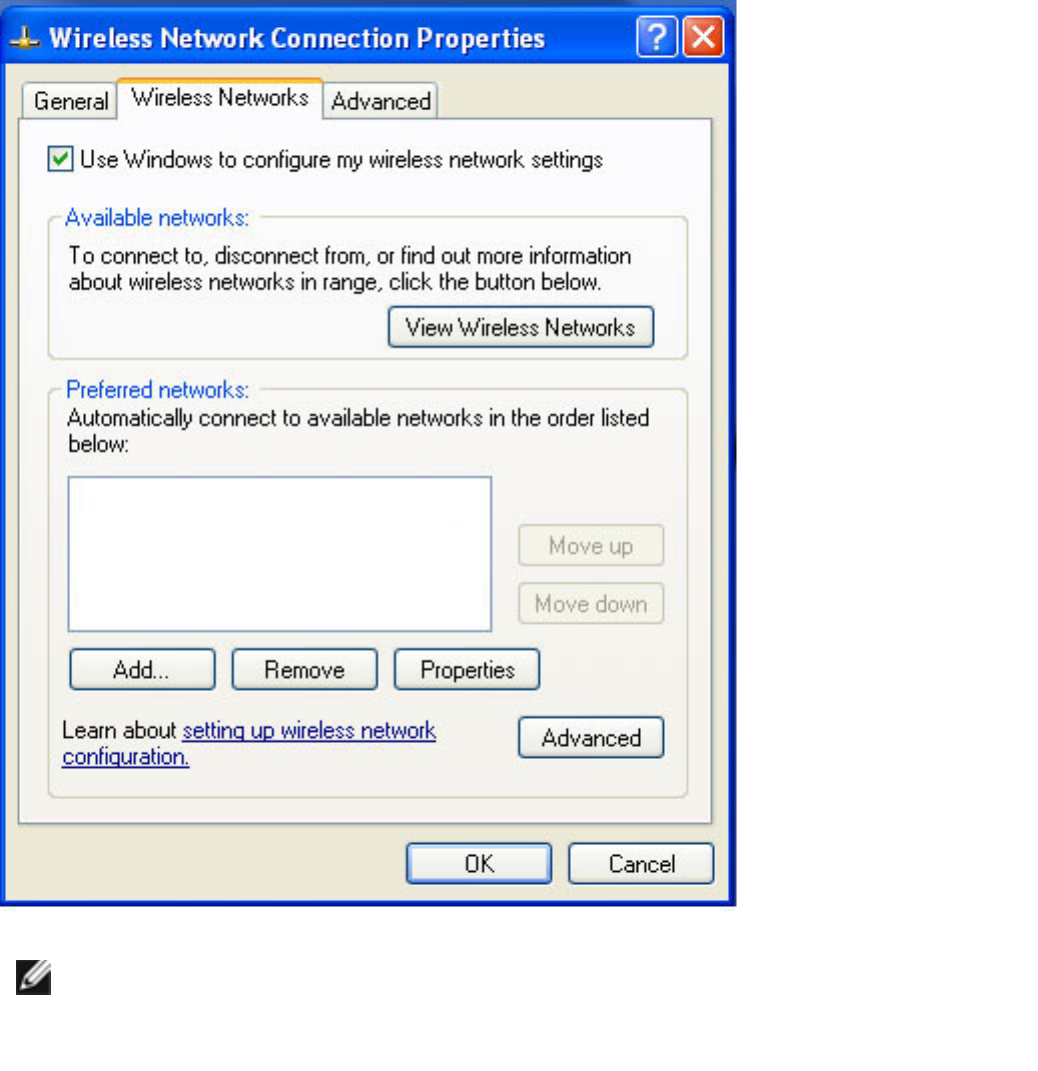
Making a Basic Network Connection in Windows XP: Intel PRO/Wireless 2915ABG Network Connection User's Guide
NOTE:The names of wireless networks your computer can see are
shown under Preferred networks. The name of your network is
usually shown here.
2. On the Wireless Networks tab, under Preferred networks, click Add. The
Wireless network properties dialog opens:
file:///C|/Documents%20and%20Settings/pguillor/Desktop/w2k5/XPsetup.htm (3 of 9) [7/2/2004 12:29:13 PM]
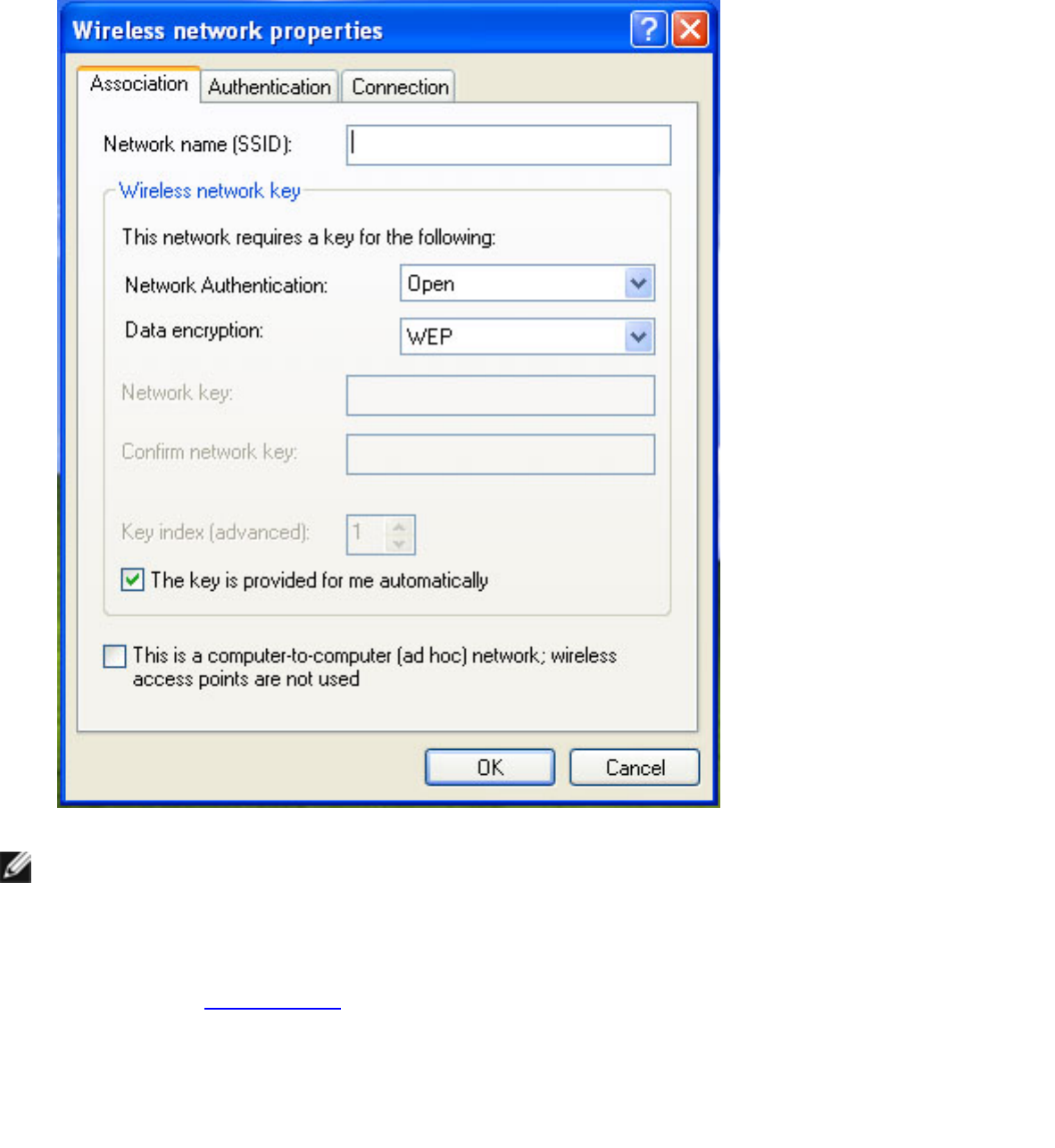
Making a Basic Network Connection in Windows XP: Intel PRO/Wireless 2915ABG Network Connection User's Guide
NOTE:The names of wireless networks your computer can see are shown under
Available Networks. For Windows XP SP2, it is necessary to Click on View
Wireless Networks to see a list of available networks. The name of your
network is usually shown here. If a blank network name (SSID) is received
from a silent mode wireless router, there will be no entry for that network in the
available networks list. To associate with a "silent mode" wireless router, a
new profile must first be created before connection. After connection, the
associated SSID can be viewed in the available networks list and in the
preferred networks list.
3. Enter the name of your network in the Network name (SSID) field.
4. Click OK. The new network name appears in the Preferred networks list:
file:///C|/Documents%20and%20Settings/pguillor/Desktop/w2k5/XPsetup.htm (4 of 9) [7/2/2004 12:29:13 PM]

Making a Basic Network Connection in Windows XP: Intel PRO/Wireless 2915ABG Network Connection User's Guide
Adding an infrastructure network
Network security must now be configured. For a home wireless network, you can choose
not to have security, or you can configure your network for WEP security. If there is no
network security, anyone can access your wireless network. WEP security provides
some level of security for your wireless network. Additional advanced security settings
are also available that are typically used in corporate environments or for advanced
users who require higher security levels. You must ensure that the security settings on
the access point exactly match those chosen for the wireless connection. Choose the
appropriate link below for the security type you want to use.
● Configuring your Infrastructure Network with No Security
● Configuring your Infrastructure Network with WEP Security
● Configuring Advanced Network Security Settings in Windows XP
● Configuring Advanced Network Security Settings Using Intel® PROSet for
Wireless
Configuring your Infrastructure Network with No Security
1. Right-click the Intel® PROSet/Wireless Network icon on the task tray and click
Open Microsoft client. The Wireless Network connection Properties dialog opens
(see Connecting to a Network).
2. On the Wireless Network Connection Properties dialog (see Connecting to a
file:///C|/Documents%20and%20Settings/pguillor/Desktop/w2k5/XPsetup.htm (5 of 9) [7/2/2004 12:29:13 PM]
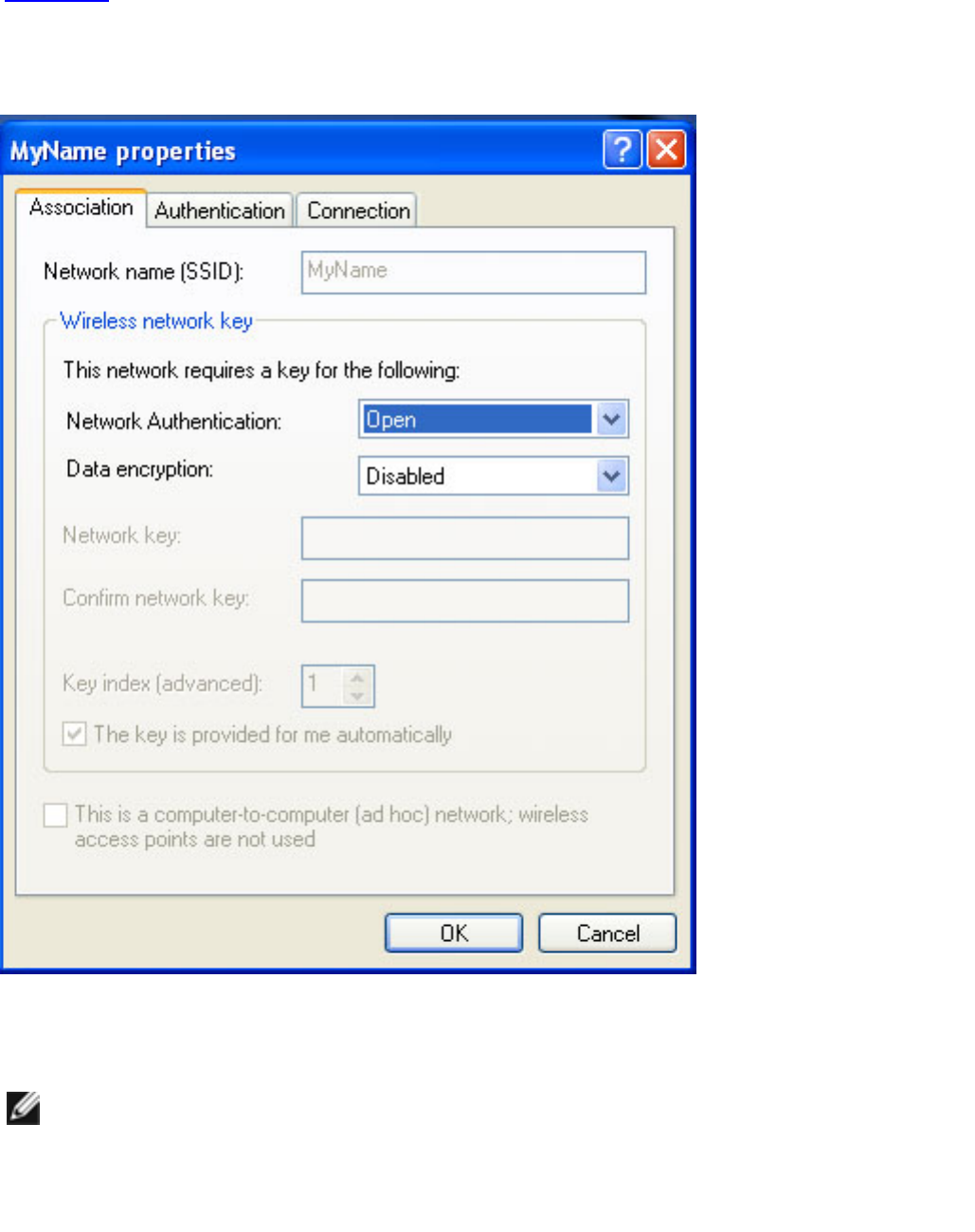
Making a Basic Network Connection in Windows XP: Intel PRO/Wireless 2915ABG Network Connection User's Guide
Network), click to select your wireless network in the Preferred networks
section.
3. Click Properties. The your wireless network Properties dialog opens:
4. From the Network Authentication drop-down menu, click to select Open.
NOTE:Earlier versions of Windows XP software may not contain these
drop-down menus. If you are using one of these earlier versions,
click to deselect the Data encryption (WEP enabled) checkbox
and skip to step 5.
5. From the Data encryption drop-down menu, click to select Disabled.
6. To save your settings on this dialog, click OK.
file:///C|/Documents%20and%20Settings/pguillor/Desktop/w2k5/XPsetup.htm (6 of 9) [7/2/2004 12:29:13 PM]

Making a Basic Network Connection in Windows XP: Intel PRO/Wireless 2915ABG Network Connection User's Guide
7. To close the Wireless Network Connection Properties dialog, click OK.
Your network configuration is now complete. Continue to Viewing the Status of your
Wireless Connection.
Configuring your Infrastructure Network with WEP Security
1. On the Wireless Network Connection Properties dialog (see Connecting to a
Network), click to select your wireless network in the Preferred networks section.
2. Click Properties. The Wireless Network Properties dialog opens.
3. From the Network Authentication drop-down menu, select Open.
NOTE:Earlier versions of Windows XP software may not contain these
drop-down menus. If you are using one of these earlier versions,
click to select the Data encryption (WEP enabled) checkbox and
skip to step 5.
4. From the Data encryption drop-down menu, select WEP.
5. Click the checkbox to deselect The key is provided for me automatically.
6. Type the WEP network key in the Network key field. Your Network key must
exactly match the access point’s network key. Your Network key will be either 5 or
13 ASCII (text) characters, or 10 or 26 hexadecimal (0-9, A-F) characters. The
person who configured your access point is the only one who knows your network
key.
7. Type this key again in the Confirm network key field. The settings are shown in
the following illustration:
file:///C|/Documents%20and%20Settings/pguillor/Desktop/w2k5/XPsetup.htm (7 of 9) [7/2/2004 12:29:13 PM]
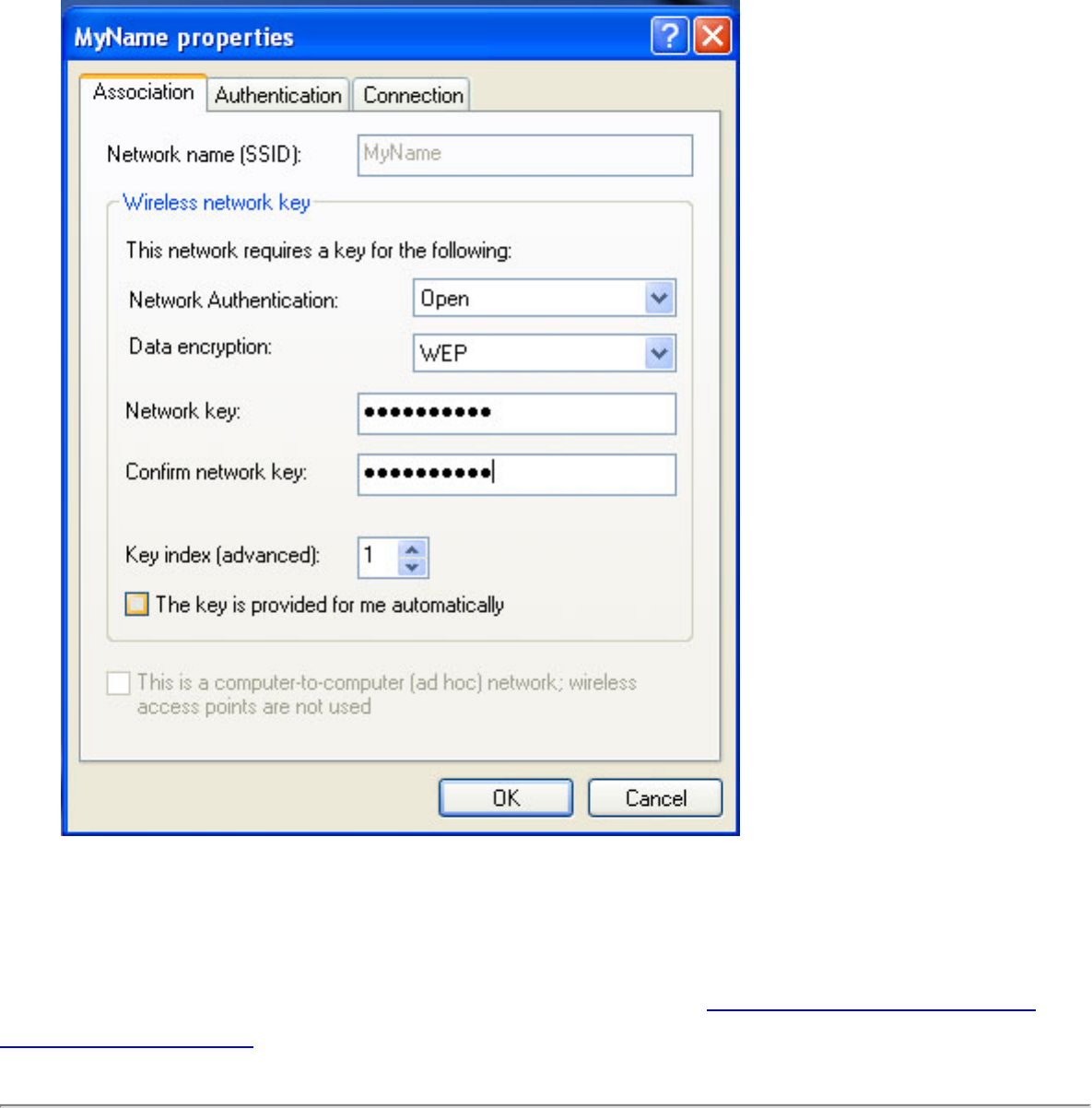
Making a Basic Network Connection in Windows XP: Intel PRO/Wireless 2915ABG Network Connection User's Guide
8. To save your settings, click OK.
9. To close the Wireless Network Connection Properties dialog, click OK.
Your network configuration is now complete. Continue to Viewing the Status of your
Wireless Connection.
Viewing the Status of your Wireless Connection
The quality of your wireless connection is affected by:
● The strength of your wireless networking signal
file:///C|/Documents%20and%20Settings/pguillor/Desktop/w2k5/XPsetup.htm (8 of 9) [7/2/2004 12:29:13 PM]

Making a Basic Network Connection in Windows XP: Intel PRO/Wireless 2915ABG Network Connection User's Guide
● The level of noise created by other devices in your home or office
● The location and environment in your home or office
The quality of your wireless network is indicated by the Wireless Network Connection
icon, located in the lower right corner of your Windows desktop. Point to this icon for a
description of your signal quality.
NOTE
NOTE:It is also possible to view the current status of your wireless connection
from the Intel® PROSet/Wireless main screen. To open PROSet/Wireless,
double-click the PROSet icon located in the lower right corner of your
Windows desktop.
Back to Top
Back to Contents
file:///C|/Documents%20and%20Settings/pguillor/Desktop/w2k5/XPsetup.htm (9 of 9) [7/2/2004 12:29:13 PM]

Making a Basic Network Connection in Windows 2000: Intel PRO/Wireless 2915ABG Network Connection User's Guide
Back to Contents
Making a Basic Network Connection in Windows
2000: Intel® PRO/Wireless 2915ABG Network
Connection User's Guide
Connect to a Network in Windows 2000
Viewing the Status of your Wireless Connection
Connecting to a Network using Windows 2000
This document assumes that your wireless card is already installed in your system and the
software has been installed. If you did not receive your wireless card as part of a system, refer to
the Setup Guide that came with your wireless card for hardware and software installation
instructions.
To see if you have a wireless card installed:
1. From your Windows desktop, right-click My Computer and select Properties.
2. From the Hardware tab, select the Device Manager button.
3. Double-click Network adapters.
4. If a supported wireless card is installed, you will see either Intel® PROSet/Wireless
2200BG Network Connection or Intel) PRO/Wireless 2915ABG Network Connection. If
a supported wireless card is not installed this name will not be displayed.
If you are using Windows 2000, you must use Intel® PROSet/Wireless to configure your
wireless card. This procedure is discussed in this section.
NOTE:USING WINDOWS XP: It is recommended that you use Windows XP to configure
profiles for your network connections. However, you can also use Intel®
PROSet/Wireless to create your profiles. If you need to configure profiles using Cisco
specific settings such as LEAP you will also need to use Intel® PROSet/Wireless.
Refer to Making a Basic Network Connection in Windows XP for information about
configuring your wireless network profiles.
Configuring a Network Profile in Infrastructure Mode using Windows 2000
file:///C|/Documents%20and%20Settings/pguillor/Desktop/w2k5/W2Ksetup.htm (1 of 10) [7/2/2004 12:29:25 PM]

Making a Basic Network Connection in Windows 2000: Intel PRO/Wireless 2915ABG Network Connection User's Guide
To connect to a wireless network, you must first configure a network profile for that network on
your computer using Intel® PROSet/Wireless. Refer to Using Intel® PROSet/Wireless for
instructions about how to launch Intel® PROSet/Wireless.
You can connect to a network by first creating a new profile using the Profile Wizard, and then
selecting that profile to connect to the network access point using the Connect button. Refer to
Creating a profile for more information.
Follow the applicable instruction set below, based on whether the network requires network
security key information (check with your network administrator or access point installer to see if
network key information is required).
● Configuring your Infrastructure Network with no security
● Configuring your Infrastructure Network with WEP Security
Configuring your Infrastructure Network with No Security
To configure a new profile with no security:
1. Double-click the Intel® PROSet/Wireless icon in the desktop task tray, or click Start
àPrograms àIntel® PROSet/Wireless àIntel® PROSet/Wireless. (Be sure you are
using Intel® PROSet/Wireless and not Microsoft Client to configure a new profile.)
2. From the Intel® PROSet/Wireless dialog, under Profiles, click Add. The General Settings
dialog opens:
file:///C|/Documents%20and%20Settings/pguillor/Desktop/w2k5/W2Ksetup.htm (2 of 10) [7/2/2004 12:29:25 PM]
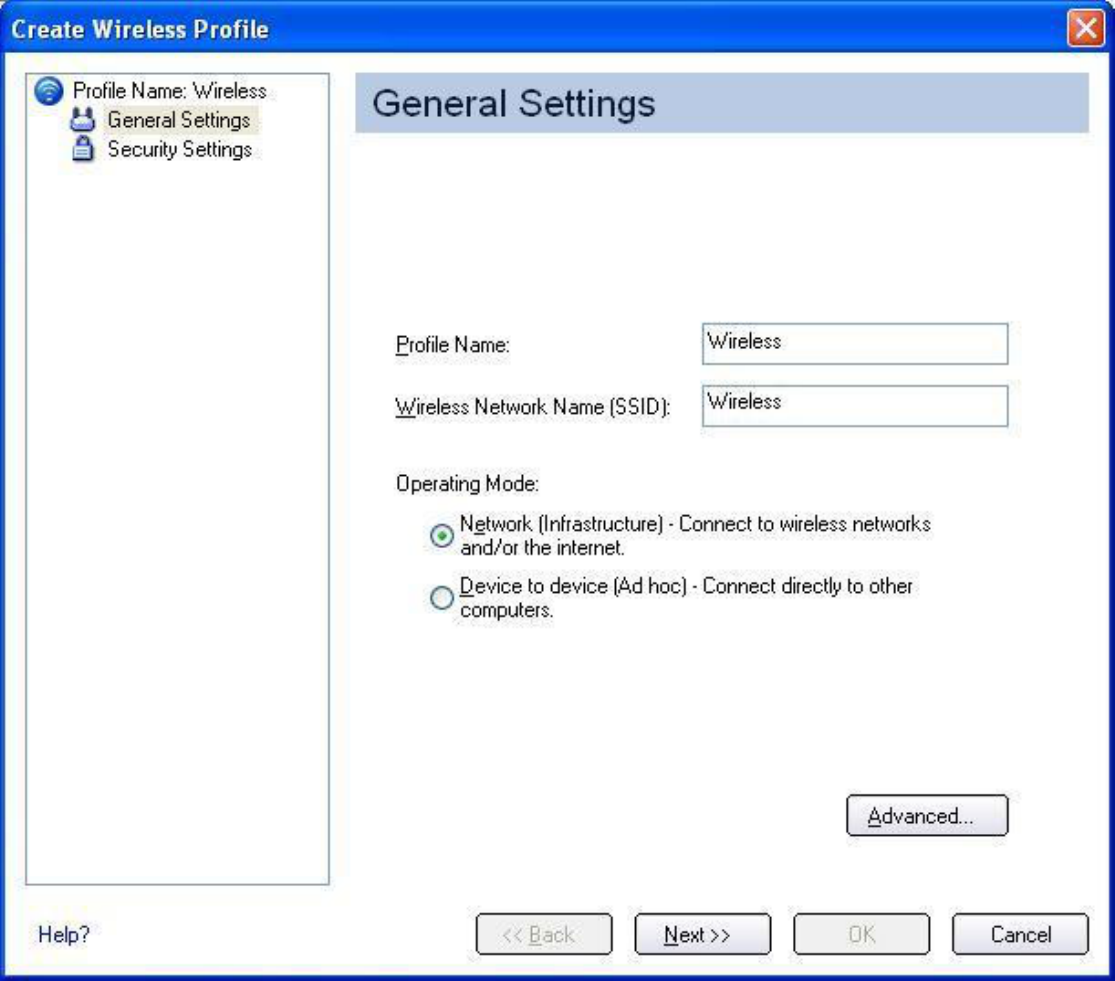
Making a Basic Network Connection in Windows 2000: Intel PRO/Wireless 2915ABG Network Connection User's Guide
3. Enter the Profile Name and Wireless Network Name (SSID) in the appropriate fields.
4. Select Network [Infrastructure]. If you want to assign a password for this profile, click
Advanced. The Advanced Settings dialog opens:
file:///C|/Documents%20and%20Settings/pguillor/Desktop/w2k5/W2Ksetup.htm (3 of 10) [7/2/2004 12:29:25 PM]
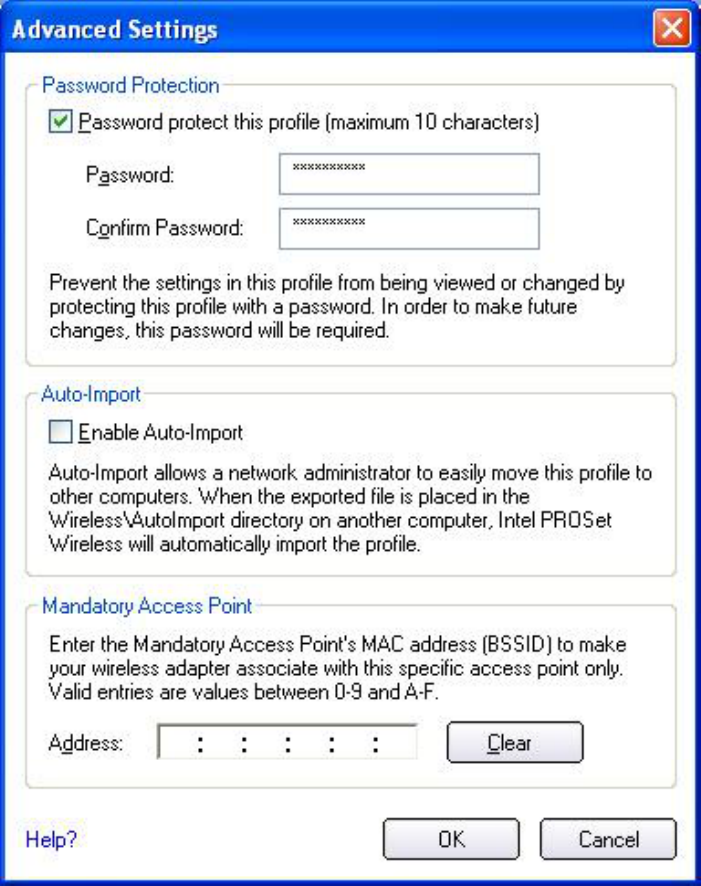
Making a Basic Network Connection in Windows 2000: Intel PRO/Wireless 2915ABG Network Connection User's Guide
5. Select Password protect this profile (maximum 10 characters).
6. Enter the password, then re-enter it in the Confirm Password box.
7. To close the dialog, click OK. The previous Create Wireless Profile dialog reopens:
file:///C|/Documents%20and%20Settings/pguillor/Desktop/w2k5/W2Ksetup.htm (4 of 10) [7/2/2004 12:29:25 PM]
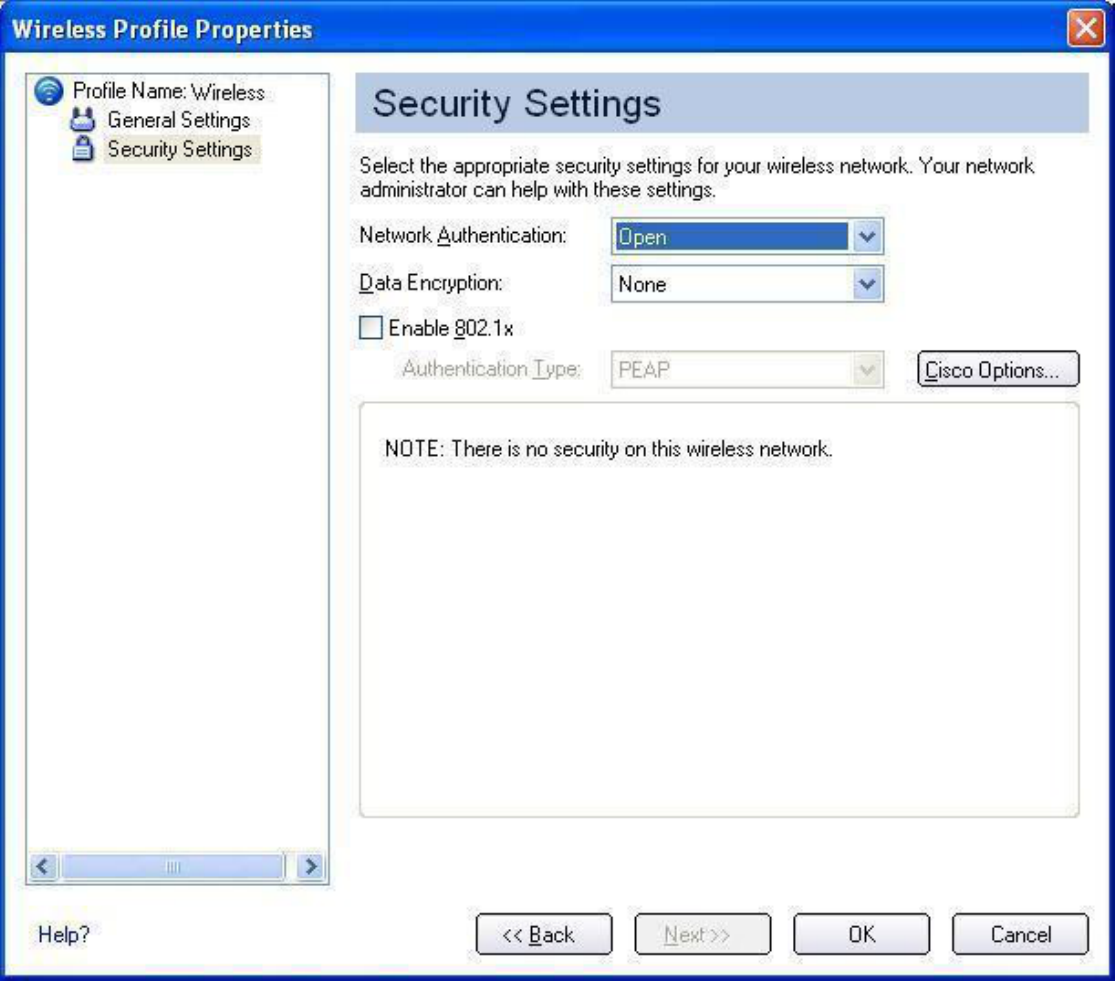
Making a Basic Network Connection in Windows 2000: Intel PRO/Wireless 2915ABG Network Connection User's Guide
8. Click Next.
9. For Network Authentication, select Open (recommended).
10. Select None as the Data Encryption.
11. To save your settings and close the Security Settings page, click OK. The Intel®
PROSet/Wireless dialog reopens.
file:///C|/Documents%20and%20Settings/pguillor/Desktop/w2k5/W2Ksetup.htm (5 of 10) [7/2/2004 12:29:25 PM]
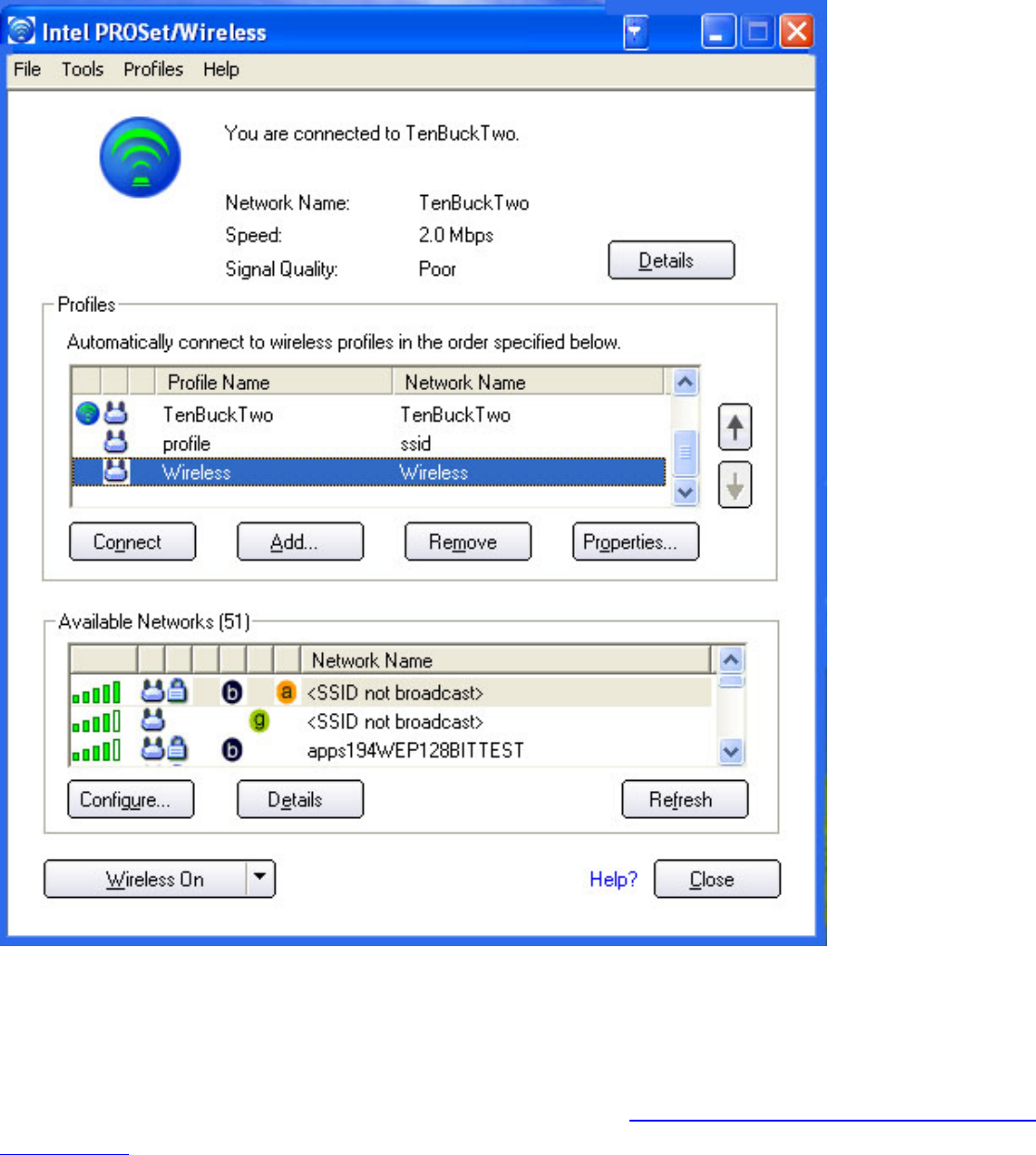
Making a Basic Network Connection in Windows 2000: Intel PRO/Wireless 2915ABG Network Connection User's Guide
12. The new profile is positioned at the bottom of the Profiles list. Use the up and down arrows
to position it at the top of the list.
13. To connect to the wireless network, select it and click Connect.
14. To verify the status of your wireless connection, refer to Viewing the Status of your Wireless
Connection.
Configuring your Infrastructure Network with WEP security
The following describes how to edit an existing profile and apply Wired Equivalent Privacy (WEP)
encryption.
file:///C|/Documents%20and%20Settings/pguillor/Desktop/w2k5/W2Ksetup.htm (6 of 10) [7/2/2004 12:29:25 PM]
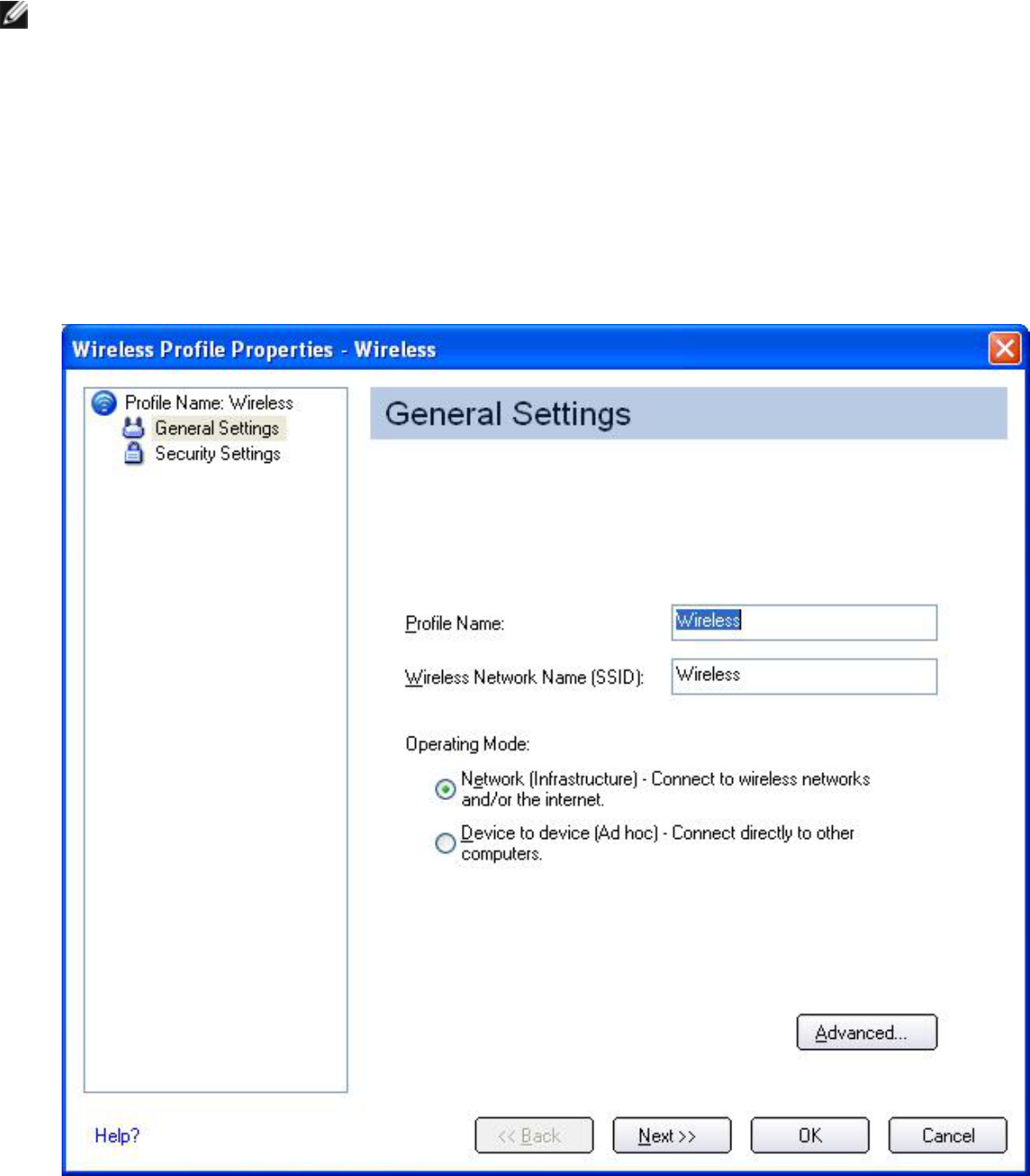
Making a Basic Network Connection in Windows 2000: Intel PRO/Wireless 2915ABG Network Connection User's Guide
NOTE:Before starting, have the security network key available for the access point (for home
use). If the access point is installed in a corporate environment, contact your system
administrator for the network key.
To configure a profile with WEP security:
1. Double-click the Intel® PROSet/Wireless icon in the desktop task tray, or click Start
àPrograms àIntel® PROSet/Wireless àIntel® PROSet/Wireless.
2. From the Intel® PROSet/Wireless dialog, select the profile from the Profiles list and click
Properties. The General Settings dialog opens:
3. Click Next. The Security Settings dialog opens:
file:///C|/Documents%20and%20Settings/pguillor/Desktop/w2k5/W2Ksetup.htm (7 of 10) [7/2/2004 12:29:25 PM]
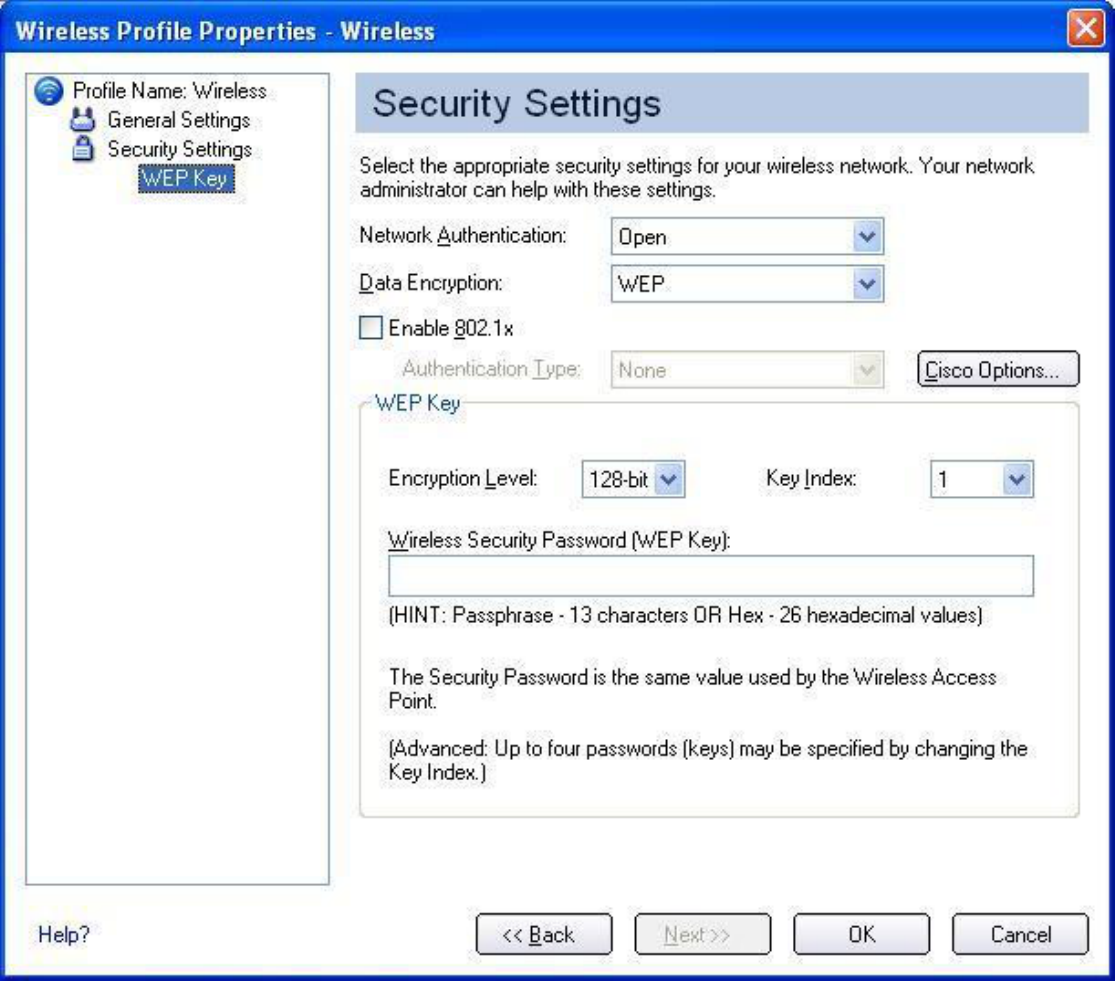
Making a Basic Network Connection in Windows 2000: Intel PRO/Wireless 2915ABG Network Connection User's Guide
4. For Network Authentication, select Open (recommended).
5. Select WEP as the Data Encryption.
6. For the Encryption Level, select 64-bit or 128-bit.
7. Select a key index number 1, 2, 3, or 4. Key selection must correspond to the network key
on the access point.
8. Enter the password characters in the Wireless Security Password (WEP Key) text box.
Select either of the following:
● Use ASCII characters: Click Use ASCII characters to enable. Enter a
text phrase, five (using 64-bit) or 13 (using 128-bit) alphanumeric
characters (0-9, a-z or A-Z), in the pass phrase field.
● Use hex Key: Click Use hex Key to enable. Enter ten (using 64-bit)
alphanumeric characters, 0-9, A-F, or twenty-six (using 128-bit)
file:///C|/Documents%20and%20Settings/pguillor/Desktop/w2k5/W2Ksetup.htm (8 of 10) [7/2/2004 12:29:25 PM]

Making a Basic Network Connection in Windows 2000: Intel PRO/Wireless 2915ABG Network Connection User's Guide
alphanumeric characters (0-9, A-F) in the hex key field.
NOTE:Both the network name and the network key information are case-
sensitive.
9. To save the settings and close the Security Settings page, click OK.
10. The profile is positioned at the bottom of the Profiles list. Use the up and down arrows to
position it at the top of the list.
11. To connect to the wireless network, click Connect.
12. To verify the status of your wireless connection, refer to Viewing the Status of your Wireless
Connection.
Your basic configuration is now complete. If your network required advanced security options,
click on the appropriate link below for advanced configuration instructions.
Configuring Advanced Network Security Settings in Windows XP: Using Windows XP Support.
Configuring Advanced Network Security Settings in Windows 2000: Using Intel®
PROSet/Wireless.
Viewing the Status of Your Wireless Connection
The wireless network connection icon in the bottom right corner of the windows desktop indicates
the current status of your wireless connection. There is also a signal quality icon on the Intel®
PROSet/Wireless main windows that provides the current status of your wireless connection. The
signal can vary from poor to excellent depending on the surroundings and quality of the signal
from the access point or computer (ad hoc mode). The following table shows how the signal
quality icon indicates the status of your wireless connection, and the suggested actions for low
signals.
Connection
Icon Connection
Status Bars/Color Suggested Action
Excellent 5 green
bars No action required
Very Good 4 green
bars No action required
Good 3 green
bars No action required
file:///C|/Documents%20and%20Settings/pguillor/Desktop/w2k5/W2Ksetup.htm (9 of 10) [7/2/2004 12:29:25 PM]

Making a Basic Network Connection in Windows 2000: Intel PRO/Wireless 2915ABG Network Connection User's Guide
Low 2 green
bars Move closer to the access point
Very Low 1 yellow
bar Move closer to the access point
No
connection no colored
bars Computer is still trying to establish initial
connection or you have moved out of
the range of your access point.
Back to Top
Back to Contents
file:///C|/Documents%20and%20Settings/pguillor/Desktop/w2k5/W2Ksetup.htm (10 of 10) [7/2/2004 12:29:25 PM]

Using the Intel(R) PROSet Wireless Utility: Intel(R) PRO/Wireless 2200BG Network Connection User's Guide
Back to Contents
Using Intel® PROSet/Wireless: Intel
PROSet/Wireless 2915ABG Network
Connection User's Guide
Using Intel PROSet/Wireless as Your Wireless Manager
Enabling/Disabling the Wireless Radio
Intel PROSet/Wireless Main Window
Intel PROSet/Wireless Menus
Administrator Tool
Single Sign On Feature
Installing and Uninstalling the Software
Installing and Uninstalling the Single Sign On Feature
Window XP Zero Configuration
Using Intel PROSet/Wireless as Your Wireless Manager
The following information is for Windows XP users. If you are using Windows 2000 refer to
Making a Basic Network Connection in Windows 2000.
Intel PROSet/Wireless can be used to set up, edit, and manage network profiles to connect
to a network. It also includes advanced settings such as power management and channel
selection for setting up ad hoc networks. If you are using Windows XP, it is recommended
that you use Windows XP to manage your network profiles. However, if your network
requires LEAP authentication, you will need to use Intel® PROSet/Wireless to configure
your LEAP profiles.
Disabling Windows XP Wireless Manager from the Windows Operating
System
To disable Windows XP as your wireless manager from Windows:
1. Click Start àSettings àControl Panel.
file:///C|/Documents%20and%20Settings/pguillor/Desktop/w2k5/UtilIntc.htm (1 of 39) [7/2/2004 12:29:31 PM]
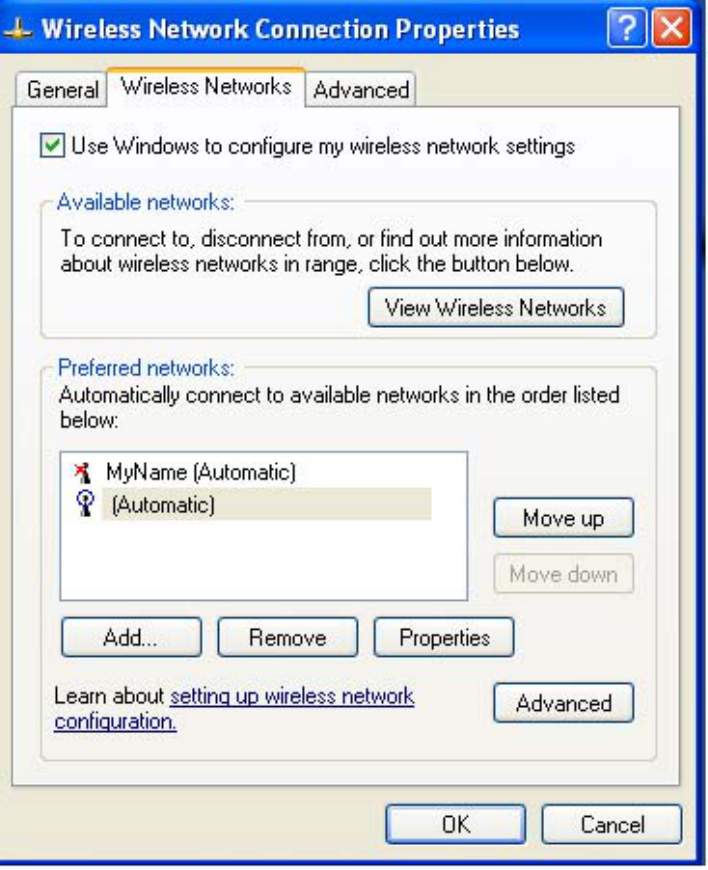
Using the Intel(R) PROSet Wireless Utility: Intel(R) PRO/Wireless 2200BG Network Connection User's Guide
2. Double-click Network Adapters.
3. Right-click Wireless Network Connection, and then click Properties. The Wireless
Network Connection Properties page opens:
2. On the Wireless Networks tab, click to clear the Use Windows to configure my
wireless network settings checkbox.
3. To save your settings, click OK.
This procedure configures Intel® PROSet/Wireless to manage your network profiles.
Disabling Windows XP from Intel® PROSet/Wireless
If Windows XP is enabled, the Intel® PROSet/Wireless main window is disabled. However,
you can still open the Intel® PROSet/Wireless window from the Start menu and disable
Windows XP.
file:///C|/Documents%20and%20Settings/pguillor/Desktop/w2k5/UtilIntc.htm (2 of 39) [7/2/2004 12:29:31 PM]
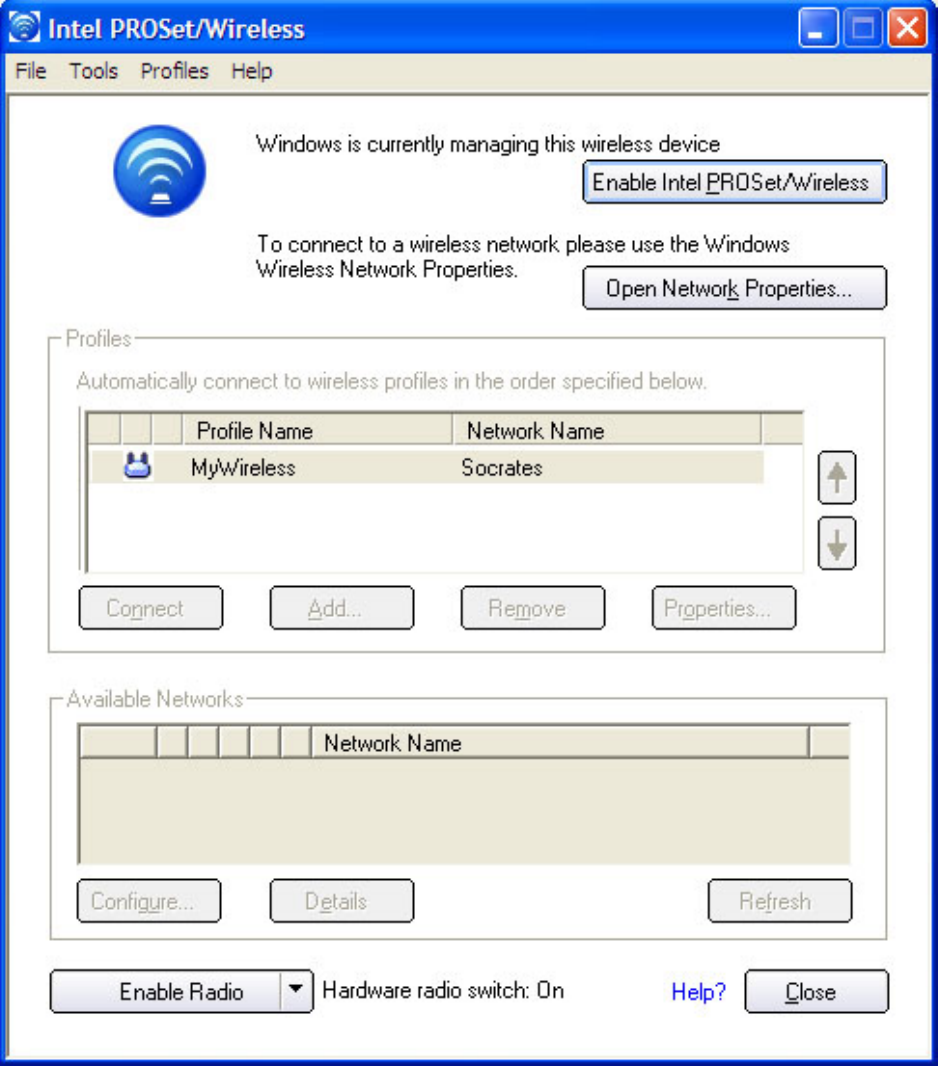
Using the Intel(R) PROSet Wireless Utility: Intel(R) PRO/Wireless 2200BG Network Connection User's Guide
To disable Windows XP from the Intel PROSet/Wireless window:
1. Click Start àPrograms àIntel PROSet/Wireless. The Intel PROSet/Wireless
window opens.
2. Click Enable Intel PROSet/Wireless. This procedure configures Intel
PROSet/Wireless to manage your network profiles.
file:///C|/Documents%20and%20Settings/pguillor/Desktop/w2k5/UtilIntc.htm (3 of 39) [7/2/2004 12:29:31 PM]
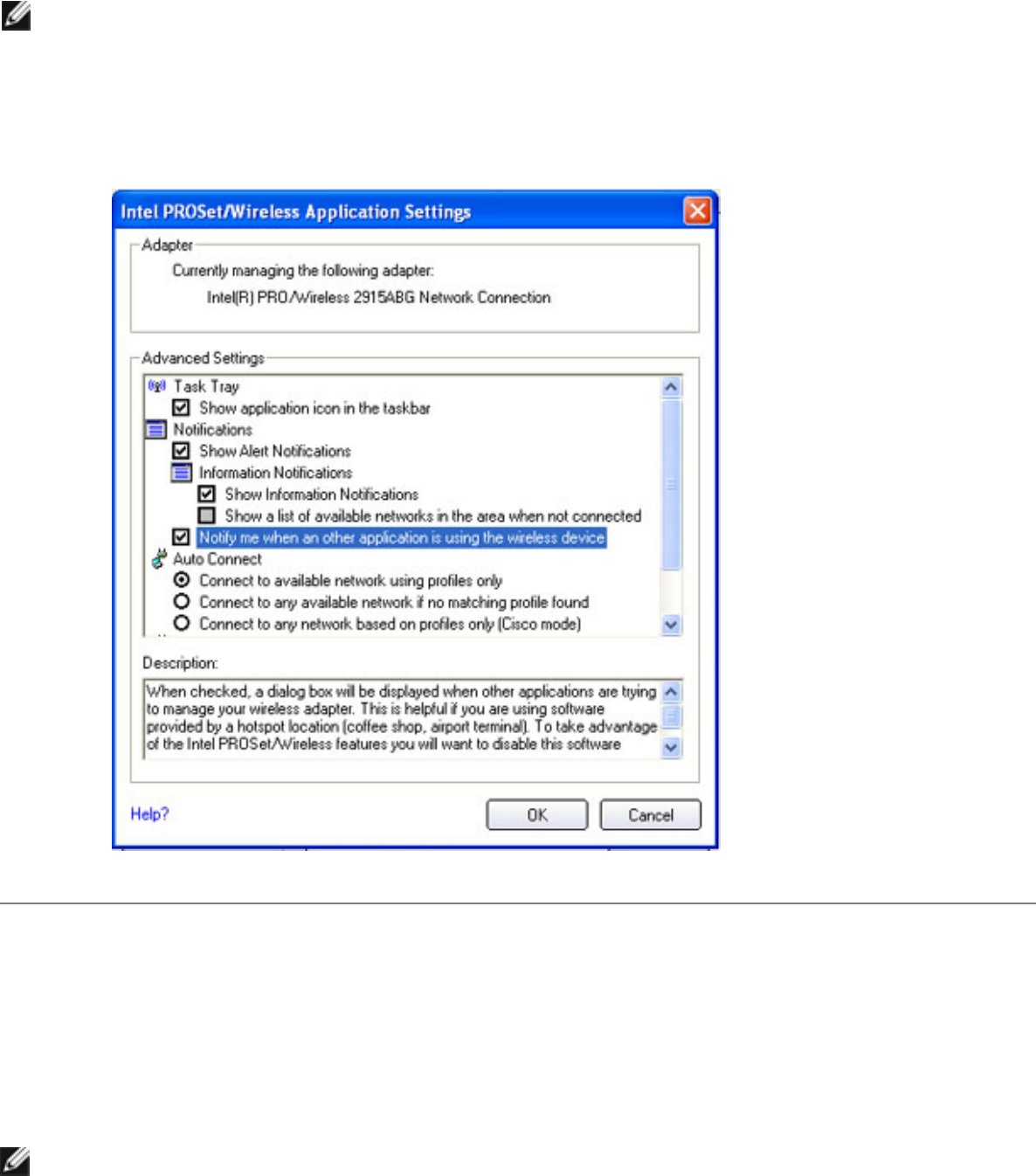
Using the Intel(R) PROSet Wireless Utility: Intel(R) PRO/Wireless 2200BG Network Connection User's Guide
NOTE:To be notified when Windows XP or any other wireless manager starts to manage
your network profiles, select Applications Settings under the Tools menu on the
Intel PROSet/Wireless window box. Next, select Notify when another
application is using the wireless device checkbox, as shown in the following
illustration:
Enabling/Disabling the Wireless Radio
The wireless radio can be enabled/disabled from a hardware radio switch on your computer,
in conjunction with either the Intel PROSet/Wireless or with Windows.
NOTE: When your computer is switched on and the radio is enabled, the radio is capable
of constantly transmitting signals. In certain situations, such as in a plane, signals from the
radio may cause interference. The following methods describe how to disable the radio and
use your laptop without emitting radio signals.
file:///C|/Documents%20and%20Settings/pguillor/Desktop/w2k5/UtilIntc.htm (4 of 39) [7/2/2004 12:29:31 PM]

Using the Intel(R) PROSet Wireless Utility: Intel(R) PRO/Wireless 2200BG Network Connection User's Guide
Using the Fn + F2 radio off/on switch
To enable/disable the radio:
1. Press Fn + F2 to switch the radio on or off. This is known as the
hardware switch. If you have Intel PROSet/Wireless installed, the current state of
the radio is displayed in the Intel PROSet/Wireless main window and in the task tray.
The hardware radio switch must be turned on before you can enable the radio using
the Intel PROSet/Wireless or Windows Device Manager:
Radio icon status: Using Fn + F2 displays a large wireless icon indicating that
the radio is enabled or disabled, as shown in the following illustration:
Radio Enabled using
Fn + F2
Radio Disabled
using Fn + F2
Using Intel PROSet/Wireless to enable/disable the radio
The radio can be enabled/disabled from Intel PROSet/Wireless. The status icon on the Intel
PROSet/Wireless main window displays the current state of the radio.
When the radio is on, an attempt is made to associate the network access point using the
last profile. If the adapter cannot connect to the access point, the Configuration Service
attempts to find an available network.
To enable/disable the radio using Intel PROSet/Wireless:
● To enable/disable the radio from the Intel PROSet/Wireless main window:
file:///C|/Documents%20and%20Settings/pguillor/Desktop/w2k5/UtilIntc.htm (5 of 39) [7/2/2004 12:29:31 PM]

Using the Intel(R) PROSet Wireless Utility: Intel(R) PRO/Wireless 2200BG Network Connection User's Guide
■ Open the Intel PROSet/Wireless main window.
■ To toggle the radio off and on, click Enable/Disable Radio.
● To enable/disable the radio off/on from the task tray:
■ Right-click the task tray icon .
■ From the menu that opens, select Enable Radio or Disable Radio.
When the radio is disabled, the task try shows the icon with a red X: .
The icon is located in the lower right corner of Windows desktop.
Using Device Manager to enable/disable the radio
The radio can be enabled/disabled using Device Manager on the Windows operating
system. The wireless icon on the task tray will display the current state of the radio.
To enable/disable the radio from the Windows Device Manager:
1. From the Windows desktop, right-click My Computer and then click Properties.
2. Click the Hardware tab, and then click Device Manager.
3. Double-click Network adapters.
4. Right-click the installed wireless adapter in use.
5. From the pop-up menu, choose Enable/Disable (depending on whether the radio is
currently on or off).
6. When prompted, click Yes.
NOTE::Make sure the radio is enabled on both the software and the hardware. If it
is not enabled on the hardware, you will receive this message when you try
to connect:
The Intel® PRO/Wireless 2915ABG (or the Intel
PROSet/Wireless 2200BG) network connection is still disabled.
Press Fn + F2 to enable it.
A red X indicates the radio is disabled.
Intel PROSet/Wireless Main Window
file:///C|/Documents%20and%20Settings/pguillor/Desktop/w2k5/UtilIntc.htm (6 of 39) [7/2/2004 12:29:31 PM]
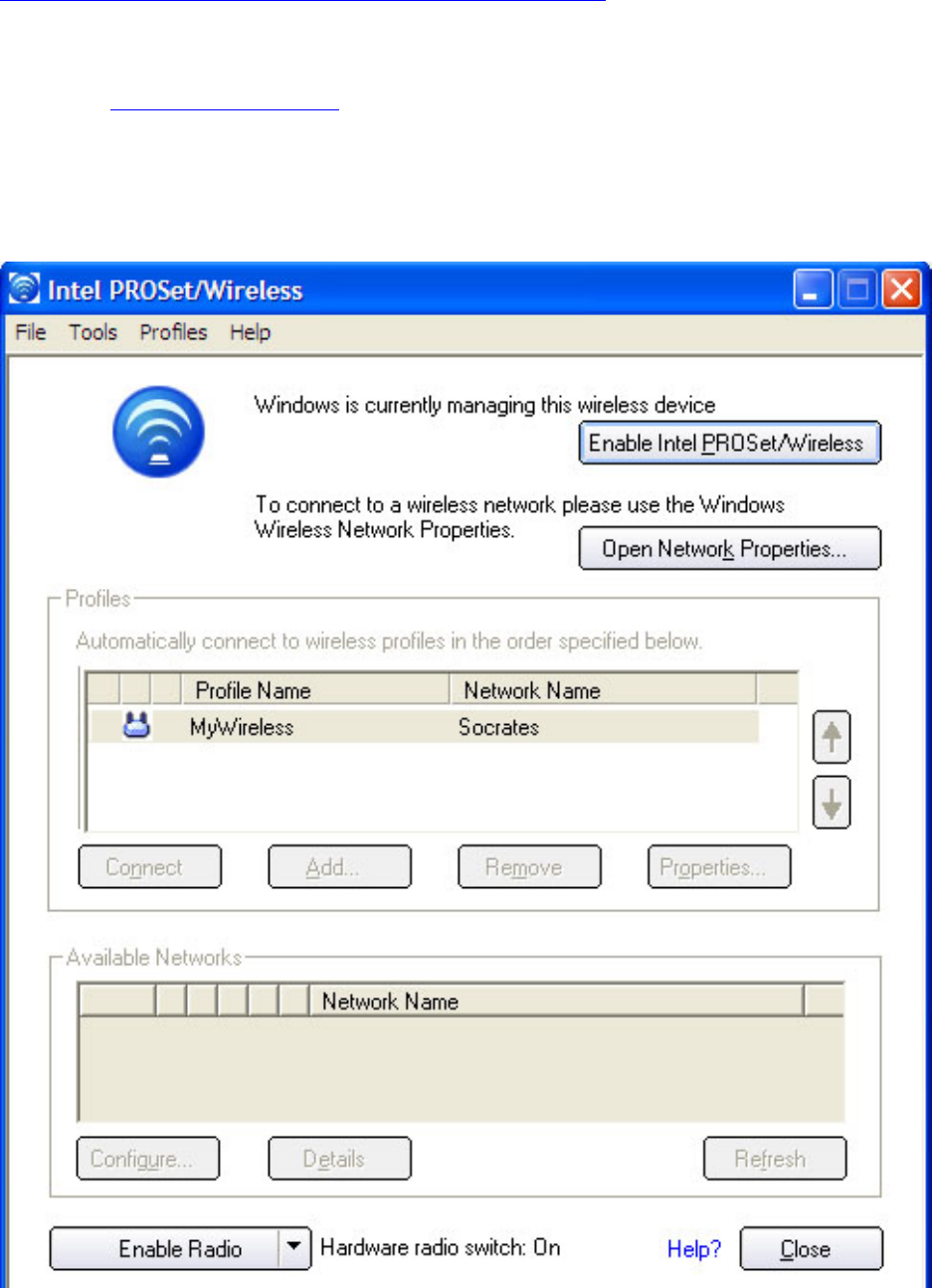
Using the Intel(R) PROSet Wireless Utility: Intel(R) PRO/Wireless 2200BG Network Connection User's Guide
The main window contains basic information about your connection. If you are associated to
a network, it will contain information such as SSID, profile name, and speed, and AP settings
such as 802.11 band, channel, and security mode. The Signal Quality icon provides visual
information about the quality of the wireless signal. It varies from poor to excellent,
depending on the surroundings and quality of the signal from the access point. Refer to
Viewing the Status of your Wireless Connection for more information.
The current status of the radio is also displayed in the Intel PROSet/Wireless main screen.
Refer to enabling the radio for more information about how to enable/disable the wireless
radio.
Intel PROSet/Wireless Main Window:
file:///C|/Documents%20and%20Settings/pguillor/Desktop/w2k5/UtilIntc.htm (7 of 39) [7/2/2004 12:29:31 PM]
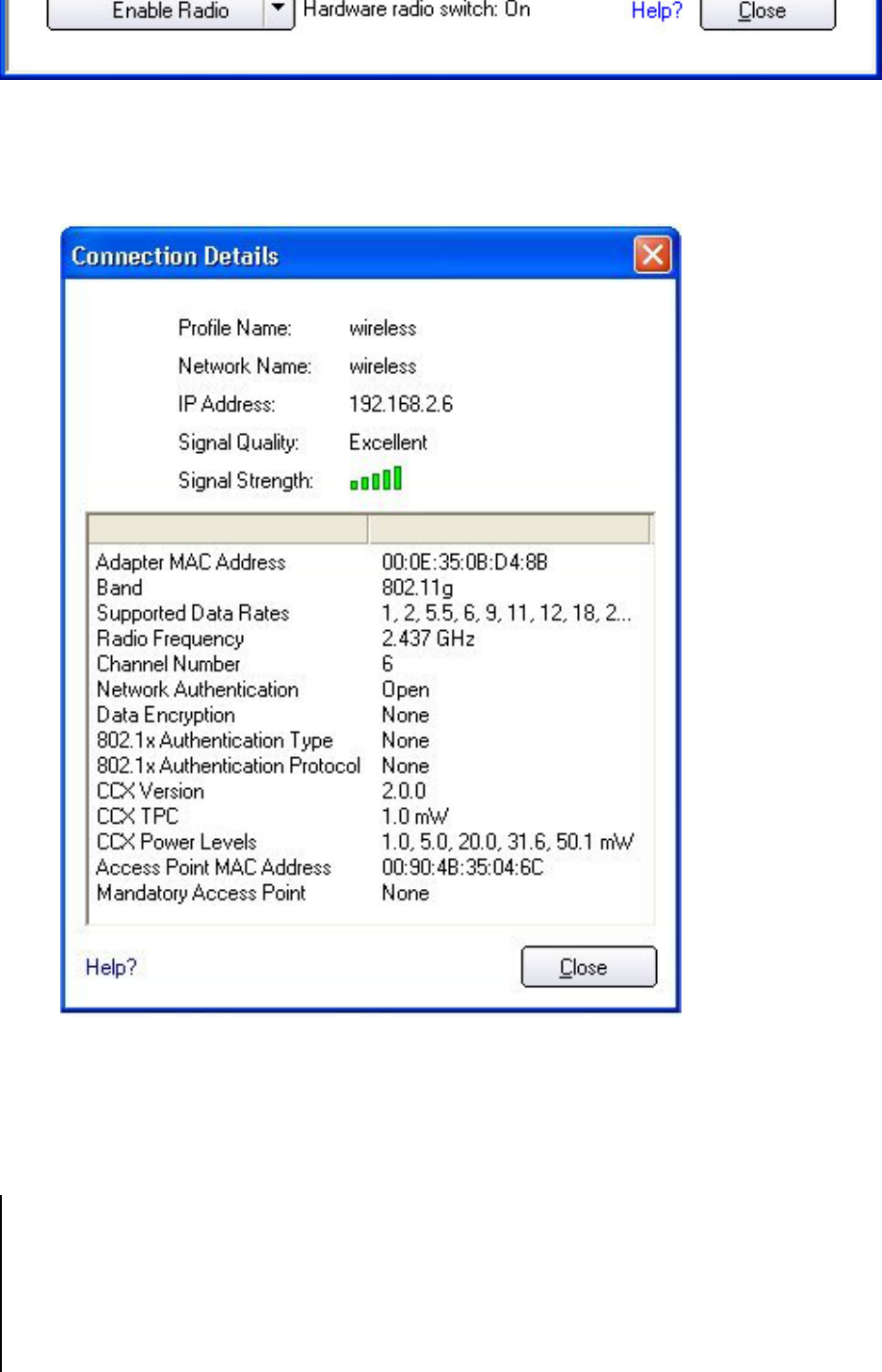
Using the Intel(R) PROSet Wireless Utility: Intel(R) PRO/Wireless 2200BG Network Connection User's Guide
● To view detailed parameters of the access point and network adapter, as shown in the
following illustration, click Details.
The Connection Details window displays the current network connection information.
Connection Details description
Name Description
Profile Name Name of the profile. If this is a one-time connection then <no active
profile> is displayed.
Network Name Network Name (SSID) of the current connection.
IP address Internet Protocol (IP) address for the current connection.
file:///C|/Documents%20and%20Settings/pguillor/Desktop/w2k5/UtilIntc.htm (8 of 39) [7/2/2004 12:29:31 PM]

Using the Intel(R) PROSet Wireless Utility: Intel(R) PRO/Wireless 2200BG Network Connection User's Guide
Signal Quality A radio frequency (RF) signal can be assessed by basically two
components:
● strength (quantity) of the signal
● the quality of the signal
The quality of the signal is determined by a combination of factors -
but primarily is composed of signal strength and the ratio of the RF
noise present. RF noise occurs both naturally in nature and
artificially by electrical equipment. If the amount of the RF noise is
high, and/or the signal strength is low, it results in a lower signal to
noise ratio which causes poorer signal quality. With a low signal to
noise ratio it is more difficult for the radio receiver to discern the
data information contained in the signal from the noise itself.
Signal Strength While adequate signal strength is required for good data
communications, even more important is the quality of the signal.
A strong signal of poor quality results in poor data
communications. If the signal quality is low, investigate sources of
noise nearby, such as interference from other wireless LANs, other
RF transmitters, electric motors or compressors. Also reflections of
the signal by metallic or other objects in the area can result in poor
signal quality.
Adapter MAC Address The Media Access Control (MAC) address for the wireless adapter.
Band Indicates the wireless band of the current connection.
● 802.11a
● 802.11b
● 802.11g
Supported Data rates Rates at which the wireless adapter can send and receive data.
Displays the speed in Mbps for the frequency being used.
● 802.11g - 1, 2, 5.5, 6, 9, 11, 12, 18, 24, 36, 48, and 54
● 802.11b - 1, 2, 5.5, and 11
● 802.11a - 6, 9, 11, 12, 18, 24, 36, 48, and 54
Radio Frequency Displays the channel frequency of the current wireless connection.
Channel Number Displays the transmit and receive channel.
file:///C|/Documents%20and%20Settings/pguillor/Desktop/w2k5/UtilIntc.htm (9 of 39) [7/2/2004 12:29:31 PM]

Using the Intel(R) PROSet Wireless Utility: Intel(R) PRO/Wireless 2200BG Network Connection User's Guide
Network
Authentication Displays Open, Shared, WPA-Enterprise, WPA-Personal, WPA2-
Enterprise and WPA2-Personal modes. Displays the 802.11
authentication used by the currently used profile. Refer to Security
Settings for more information.
Data Encryption Displays None, WEP, CKIP, TKIP or AES-CCMP. Refer to Security
Settings for more information.
CCX Version Version of the Cisco Compatible Extensions on this wireless
connection.
CCX TPC Power Cisco Compatible Extensions Power Levels.
CCX Power Levels 0.2, 0.4, 1.0, 6.3, 100.0 mW
Access Point MAC
Address The Media Access Control (MAC) address for the associated
access point.
Mandatory Access
Point Displays "None" is not enabled. If enabled from the Mandatory AP
setting, the access point MAC address is displayed. This option
directs the wireless adapter to connect to an access point using a
specific MAC address (48-bit 12 hexadecimal digits, e.g.,
00:06:25:0E:9D:84).
Close Closes the page.
Help? Displays the help information for this page.
Main Window Connection Status Icons
Icon Description
Radio Disabled: The wireless adapter is not associated to a network.
Click the Enable Radio button to enable the adapter.
Searching for wireless networks: The wireless adapter is scanning
for any available wireless networks.
Animated Icons:
No wireless networks found: There are no available wireless
networks found.
file:///C|/Documents%20and%20Settings/pguillor/Desktop/w2k5/UtilIntc.htm (10 of 39) [7/2/2004 12:29:31 PM]

Using the Intel(R) PROSet Wireless Utility: Intel(R) PRO/Wireless 2200BG Network Connection User's Guide
Wireless network found: An available wireless network is found. You
can choose to connect to available networks displayed in the Available
Networks list.
Connected to a wireless network: Connected to a wireless network.
The network name, speed, and signal quality display the current
connection status. Click Details to display details of the current
network connection.
Not connected to a wireless network: Not connected to a wireless
network.
Network Name Network Name (SSID): The name of the network that the adapter is
connected to. The Network Name SSID must be the same as the
SSID of the access point, using infrastructure mode (also called
BSSID, ESSID, or Net ID) or other computers in an ad hoc network
(also called IBSSID).
Speed Displays the current data transfer rate in mega-bits-per-second
(Mbps):
● 802.11g - 1, 2, 5.5, 6, 9, 11, 12, 18, 24, 36, 48, or 54
● 802.11b - 1, 2, 5.5, or 11
● 802.11a - 54, 48, 36, 24, 18, 12, 9, 6
Signal Quality The signal quality icon bars indicate the quality of the transmit and
receive signals between your wireless adapter and the nearest access
point or computer in device-to-device mode. The number of vertical
green bars indicate the strength of the transmit and receive signals.
The signal quality ranges from excellent to out of range. The following
factors affect signal quality:
● Signal quality decreases with distance and is affected by metal
and concrete barriers.
● Metal objects can reflect signals and cause interference.
● Other electrical devices can cause interference.
Details Provides adapter connection status information.
Enable/Disable
Radio Switch the radio off and on. Refer to Enabling/Disabling Wireless the
Radio for more information.
Help? Displays the help information for this window. Drag Help? to the item
of interest to display help information.
file:///C|/Documents%20and%20Settings/pguillor/Desktop/w2k5/UtilIntc.htm (11 of 39) [7/2/2004 12:29:31 PM]

Using the Intel(R) PROSet Wireless Utility: Intel(R) PRO/Wireless 2200BG Network Connection User's Guide
Close Close the Intel PROSet/Wireless main window.
XClose the Intel PROSet/Wireless main window.
Profiles list (on the main window)
Name Description
Profile Name Profiles are network settings that allow your wireless adapter to
connect to a network access point (Infrastructure mode) or
computer (device-to-device ad hoc mode) which does not use an
access point. Refer to Setting up Profiles for more information.
Network Name Name of the wireless network (SSID) or computer.
Connection Icons The network profile status icons indicate the different connection
states of the adapter with a wireless network, the type of operating
mode being used, and if network security is being used.
Blue circle: The wireless adapter is associated with an access
point or computer (Ad hoc mode). If a profile has 802.1x security
enabled, this indicates that the wireless adapter is associated and
authenticated.
Infrastructure operating mode.
Ad hoc operating mode.
The network is using Security encryption.
Wireless network band frequency being used.
Network Name Name of the wireless network (SSID) or computer.
Arrows Use the arrows to position profiles in a preferred order for auto-
connection.
● Up-arrow: Move the position of a selected profile up in the
profile list.
● Down-arrow: Move the position of a selected profile down in
the profile list.
Connect button Connect the selected profile to the wireless network.
Add button Create a new profile using the Profile Wizard.
Remove button Remove a selected profile from the Profile List. All profiles cannot
be removed from the list, one profile must remain in the list.
Properties button Edit the contents of an existing profile. You can also double-click a
profile in the Profile List to edit the profile.
file:///C|/Documents%20and%20Settings/pguillor/Desktop/w2k5/UtilIntc.htm (12 of 39) [7/2/2004 12:29:31 PM]

Using the Intel(R) PROSet Wireless Utility: Intel(R) PRO/Wireless 2200BG Network Connection User's Guide
Available networks (on the main window)
The Available Networks list displays a list of wireless networks within range of the adapter.
Use the Connect button to launch the Profile Wizard to create a profile for the selected
wireless network.
Name Description
The signal strength of the wireless network access point or
computer (Ad hoc mode). The signal strength icon bars indicate
that the wireless network or computer is available for connection
but is still not is associated with an access point or computer (Ad
hoc mode).
The wireless network is using Infrastructure operating mode.
The wireless network is using Ad hoc operating mode.
The wireless network is using Security encryption.
The band frequency being used by the wireless network.
Network Name Name of the wireless network (SSID) or computer.
Configure button Configures the selected available Network Name.
Properties button The Networks Properties displays the current network connection
status for the wireless adapter. Refer to Network Properties for
information.
Details button Provides detailed information about the selected network and its
access points.
Refresh button Refresh the list of available networks. If any new networks are
available with range of the adapter, the list is updated to show the
new network name.
Intel PROSet/Wireless Menus
You can use the following menu options to configure your network settings:
● File
● Tools
● Profiles
● Help
file:///C|/Documents%20and%20Settings/pguillor/Desktop/w2k5/UtilIntc.htm (13 of 39) [7/2/2004 12:29:31 PM]

Using the Intel(R) PROSet Wireless Utility: Intel(R) PRO/Wireless 2200BG Network Connection User's Guide
● Task Tray
Wireless Menu Descriptions
Name Description
File Exit: Close the Intel PROSet/Wireless main window.
To launch Intel PROSet/Wireless:
● Click Start > Programs > Intel PROSet/Wireless > Intel
PROSet/Wireless.
● Right-click the task tray icon located in the lower right corner
of your Windows Desktop, and click the menu option Open
Intel PROSet/Wireless.
● Double-click the task tray icon to open Intel
PROSet/Wireless.
Tools Application Settings: Provides system wide connection
preferences. Refer to Application Settings for information. Use
Ctrl+P from your keyboard as an alternative to using your mouse
to access this feature.
Adapter Settings: Displays Adapter Settings that correspond to
the settings made in the Windows Advanced Settings. Refer to
Adapter Settings for information. Use Ctrl+A from your keyboard
as an alternative to using your mouse to access this feature.
Use Microsoft client): Enables Windows XP as the wireless
manager. Use F10 on your keyboard as an alternative to using
your mouse to access this feature. Refer to Switching to Windows
XP wireless manager for more information.
Advanced Statistics: Provides detailed information about the
network connection.
Intel Wireless Troubleshooter: Self diagnostics utility. Use
Ctrl+D from your keyboard as an alternative to using your mouse
to access this feature.
Administrator Tool: If installed, the Administrator tool is for
file:///C|/Documents%20and%20Settings/pguillor/Desktop/w2k5/UtilIntc.htm (14 of 39) [7/2/2004 12:29:31 PM]

Using the Intel(R) PROSet Wireless Utility: Intel(R) PRO/Wireless 2200BG Network Connection User's Guide
administrators or the person who has administrator privileges on
this computer. This option is used to configure shared profiles
using Pre-logon and Persistent profiles. Refer to Administrator Tool
for more information. Use Ctrl+T from your keyboard as an
alternative to using your mouse to access this feature.
Profiles Import/Export: Import and export profiles to and from the profile
list. Refer to Import/Export Profiles for information. Use Ctrl+I from
your keyboard as an alternative to using your mouse to access this
feature.
Manage Exclusions: Include or exclude specific access points.
Refer to Manage Exclusions for information. Use Ctrl+M from your
keyboard as an alternative to using your mouse to access this
feature.
Help Intel PROSet/Wireless Help: Launch the online help (F1).
About: Displays version information for the currently installed
application components.
Tools Menu
The following options are available from the Tools menu.
Application Settings (Tools menu)
Application Settings control how Intel PROSet/Wireless behaves and displays information.
Name Description
Adapter Displays the name of the installed adapter currently being managed
by Intel PROSet/Wireless
file:///C|/Documents%20and%20Settings/pguillor/Desktop/w2k5/UtilIntc.htm (15 of 39) [7/2/2004 12:29:31 PM]

Using the Intel(R) PROSet Wireless Utility: Intel(R) PRO/Wireless 2200BG Network Connection User's Guide
Task Tray Show application icon in the taskbar: Select this option to display
the task tray status icon. This icon resides in the Windows Task bar
(Notification area). Clear the box to not display the task tray status
icon. Selecting Hide Icon from the task tray menu also clears this
check box.
The Task Tray Status Icon provides several functions:
● Visual feedback for the connection state and wireless activity
of your wireless network. The icon changes color and
animation for different wireless activity. See Task Tray Icons
for more information.
● Menu – A menu is displayed when you click the icon. From
this menu you perform tasks such as turning on/off the radio
or launching the Intel PROSet/Wireless application. See: Task
Tray Menu Options for more information.
● Tool tips and balloon prompts. See: Tool Tip and Balloon
Prompts for more information.
Notifications Show Alert Notifications: Select this option to display balloon
windows next to the task tray icon. When your action is required, a
message prompt displays. Only high importance events (alerts)
trigger a balloon window. If the balloon window is checked, then the
appropriate action is taken. Clear the box to not display balloon
message prompts displayed. Refer to Tool Tip and Balloon Prompts
for more information.
Select one of the following options:
● Information Notifications: These balloons are of lower
importance. They do not require your interaction but can
greatly improve the wireless experience.
● Show Information Notifications: This checkbox is checked
by default. All informational balloon windows are displayed
next to the task tray status icon. These balloons improve your
wireless experience by notifying you when available wireless
networks are in range. They also inform you when a wireless
connection has been made or has been lost. Refer to Tool Tip
and Balloon Prompts for more information.
file:///C|/Documents%20and%20Settings/pguillor/Desktop/w2k5/UtilIntc.htm (16 of 39) [7/2/2004 12:29:31 PM]

Using the Intel(R) PROSet Wireless Utility: Intel(R) PRO/Wireless 2200BG Network Connection User's Guide
● Show a list of available networks in the area when not
connected: When the Show Information Notifications
checkbox is not checked, you can check this item. Since the
informational balloon windows are disabled this option allows
you to still be notified of available networks when the wireless
adapter is not connected.
● Notify me when another application is using the wireless
device: When checked, a window is displayed when other
applications are trying to manage your wireless adapter. This
is helpful if you are using software provided by a hotspot
location (such as a coffee shop or airport terminal. To take
advantage of the Intel PROSet/Wireless features you may
want to disable the hotspot software when you leave.
For more information about using the options above, refer to
Configuration Service.
Auto Connect Connect to available network using profiles only: (Default)
Connect the wireless adapter to an available network using a
matching profile from the Profiles List. If no matching profile is found
you are notified by a notification (see Notifications). The wireless
device remains disconnected until a matching profile is found or you
configure a new matching profile.
Connect to any available network if no matching profile found:
If the wireless adapter is disconnected and wireless networks are
found, the Intel PROSet/Wireless Configuration service attempts to
match a profile from the Profiles List and if a match is found,
connect. If no matches are found and one of the available networks
is open (unsecured), this option allows the Intel Configuration
Service to connect to that open network. Note: Open networks have
no security. You would need to provide your own security for this
wireless connection. One way to secure an open wireless
connection is with Virtual Private Networking (VPN) software.
Connect to any network based on profiles only (Cisco mode):
This mode supports multiple and blank network names (SSIDs) for
access points that support Cisco Compatible Extensions. Select this
option to try every profile in preferred order. This requires that users
know they are in the vicinity of an access point which has more than
one SSID but only advertises one.
file:///C|/Documents%20and%20Settings/pguillor/Desktop/w2k5/UtilIntc.htm (17 of 39) [7/2/2004 12:29:31 PM]

Using the Intel(R) PROSet Wireless Utility: Intel(R) PRO/Wireless 2200BG Network Connection User's Guide
Manage Exclusions Enable automatic exclude list feature: Select this checkbox to
enable the automatic exclude list feature. This feature provides a
way to exclude access points from automatic connection. Refer to
Manage Exclusions for more information.
Enable manual exclude list feature: Select this checkbox to
enable the manual exclude list feature. This feature provides a way
to exclude networks from automatic connection. Refer to Manage
Exclusions for more information.
OK Save settings and return to the previous window.
Cancel Close the page and cancel changes.
Help? Displays the help information for this window.
Adapter Settings (Tools menu)
The Advanced tab on the Intel® PRO/Wireless 2915ABG Network Connection and Intel®
PRO/Wireless 2200BG Network Connection window provides global settings for the wireless
adapter. To access this window, click Tools > Adapter Settings. The Advanced tab is the
default setting.
Advanced Tab Description
Name Description
Ad Hoc Channel Value:
802.11b/g: Select this option when using 802.11b and 802.11g
(2.4 GHz) ad hoc band frequency.
● Select the allowed operating channel from the list.
802.11a: Select this option when using 802.11a (5 GHz) ad hoc
band frequency.
● Select the allowed operating channel from the list.
file:///C|/Documents%20and%20Settings/pguillor/Desktop/w2k5/UtilIntc.htm (18 of 39) [7/2/2004 12:29:31 PM]

Using the Intel(R) PROSet Wireless Utility: Intel(R) PRO/Wireless 2200BG Network Connection User's Guide
Intel Throughput
Enhancement Changes the value of the Packet Burst control.
Enable: Enables throughput enhancement.
Disable: (default setting) Disables throughput enhancement.
Mixed mode
protection Use this option to avoid collision in the 11b/11g mixed
environment. Use RTS/CTS where clients may not hear each
other. Use CTS-to-self to gain more throughput where clients are
physically close to and can hear each other.
Power Management Allows you to select a balance between power consumption and
adapter performance. The wireless adapter power settings slider
sets a balance between the computer's power source and the
battery.
Use default value: Power settings are based on the computer's
power source (Default).
Manual: Allows you to adjust the slider for the desired setting. Use
the lowest setting for maximum battery life.* Use the highest setting
for maximum performance.
* Power consumption savings will vary based on infrastructure
settings.
Preamble Mode The preamble property allows you to change the preamble length
setting received by the access point during initial connection.
Auto Tx Preamble: (Default) Allows automatic detection of the
preamble setting received from the access point to enable the
appropriate preamble option. Short preamble is used if this option
is supported; if not, long preamble is used.
Long Tx Preamble: Always use a long preamble length to connect
to an access point.
file:///C|/Documents%20and%20Settings/pguillor/Desktop/w2k5/UtilIntc.htm (19 of 39) [7/2/2004 12:29:32 PM]

Using the Intel(R) PROSet Wireless Utility: Intel(R) PRO/Wireless 2200BG Network Connection User's Guide
Preferred Band If there is a wireless network that supports more than one band of
operation, this setting will determine which band to connect with.
For example, if 802.11a is selected for this Preferred Band setting,
but an 802.11a network is unavailable, then the wireless adapter
will still connect to an available 802.11b or 802.11g network. The
selections are:
● 802.11g
● 802.11a
● 802.11b
Transmit Power Decreasing the transmit power level reduces the radio coverage.
Default setting: Highest power setting.
● Lowest: Minimum coverage. Setting the transmission power
level enables you to expand or confine a coverage area in
respect to other wireless devices that could be operating
nearby. Reducing a coverage area in high traffic areas
improves transmission quality by reducing the number of
missed beacons and noise in that coverage area.
● Highest Maximum coverage. Set the adapter to a maximum
transmit power level. Select this setting when operating in
highly reflective environments and areas where other devices
could be operating nearby, and when attempting to
communicate with mobile computers at the outer edge of a
coverage area.
Note: This setting will take effect when using either Infrastructure
or ad hoc mode.
Data Rate Select the data transfer rate in megabits-per-second (Mbps).
Best Rate: (Default) Use the fastest rate detected.
Manually select: 1, 2, 5.5, 6. 9, 11, 12, 18, 24, 36, 48, or 54.
file:///C|/Documents%20and%20Settings/pguillor/Desktop/w2k5/UtilIntc.htm (20 of 39) [7/2/2004 12:29:32 PM]

Using the Intel(R) PROSet Wireless Utility: Intel(R) PRO/Wireless 2200BG Network Connection User's Guide
Wireless Mode 802.11a, 802.11b and 802.11g (Default): Connects to 802.11a,
802.11b, or 802.11g wireless networks.
● 802.11g only: Connects the wireless adapter to 802.11g
networks only.
● 802.11a and 802.11g only: Connects the wireless adapter to
802.11a and 802.11g networks only.
● 802.11b and 802.11g only: Connects the wireless adapter to
802.11b and 802.11g networks only.
Note: These wireless mode (Modulation type) options determine
the discovered access points displayed in the Available networks
list.
OK Save settings and return to the previous window.
Cancel Cancel changes and return to the previous window.
Help Displays the help for this window.
Windows Advanced Options (Adapter Settings)
To access the Windows XP/2000 Advanced options:
1. Start Windows and log on with administrative privileges.
2. From your desktop, right-click My Computer and click Properties.
3. Click the Hardware tab.
4. Click Device Manager.
5. Double-click Network adapters.
6. Right-click the name of the installed wireless adapter in use, and then click
Properties.
7. Select the Advanced tab.
8. Select the Property you want (e.g., Mixed mode protection, Power Management, etc.).
9. To deselect the checkbox, click Use default value.
10. Select the new value (Disable or Enable) from the drop-down box.
11. To save your settings and exit the window, click OK.
To access the Windows 98SE/Me Advanced options:
1. Start Windows and log on with administrative privileges.
2. From your desktop, right-click My Computer and then click Properties.
3. Click the Device Manager tab.
4. Double-click Network adapters.
5. Right-click the name of the installed wireless adapter in use, and then click
file:///C|/Documents%20and%20Settings/pguillor/Desktop/w2k5/UtilIntc.htm (21 of 39) [7/2/2004 12:29:32 PM]

Using the Intel(R) PROSet Wireless Utility: Intel(R) PRO/Wireless 2200BG Network Connection User's Guide
Properties.
6. Select the Advanced tab.
7. Select the Property you want (e.g., Mixed mode protection, Power Management, etc.).
8. To deselect the checkbox, click Use default value.
9. Select the new value (Disable or Enable) from the drop-down box.
10. To save your settings and exit the window, click OK.
To access the Windows NT4.0 Advanced options:
1. Start Windows and log on with administrative privileges.
2. From your desktop, right-click My Computer and click Properties.
3. Click the Hardware tab.
4. Click the Device Manager button.
5. Double-click Network adapters.
6. Right-click the name of the installed wireless adapter in use, and then click
Properties.
7. Select the Advanced tab.
8. Select the Property you want (e.g., Mixed mode protection, Power Management, etc.).
9. To deselect the checkbox, click Use default value.
10. Select the new value (Disable or Enable) from the drop-down box.
11. To save your settings and exit the window, click OK.
Advanced Statistics (Tools menu)
Provides current adapter connection information. The following describes information for the
Statistics Details window.
Name Description
Statistics Details Advanced Statistics - This information pertains to how the
adapter is communicating with an access point.
Association - If the adapter finds an access point to
communicate with, the value is In range. Otherwise, the value
is Out of range.
● AP MAC Address: The twelve digit MAC
address (e.g., 00:40:96:31:1C:05) of the
AP.
● Number of associations: The number of times
file:///C|/Documents%20and%20Settings/pguillor/Desktop/w2k5/UtilIntc.htm (22 of 39) [7/2/2004 12:29:32 PM]

Using the Intel(R) PROSet Wireless Utility: Intel(R) PRO/Wireless 2200BG Network Connection User's Guide
the access point has found the adapter.
● AP count: The number of available access
points within range of the wireless adapter.
● Number of full scans: The number of times the
adapter has scanned all channels for receiving
information.
Roaming - Roaming information indicates reasons for
adapter roaming. Roaming occurs when an adapter
communicates with one access point and then communicates
with another for better signal strength.
● Roaming Count: The number of times that
roaming occurred.
● AP did not transmit: The adapter did not
receive radio transmission from the access point.
You may need to reset the access point.
● Poor beacon quality: The signal quality is too
low to sustain communication with the access
point. You have moved the adapter outside the
coverage area of the access point or the access
point's device address information has been
changed.
● AP load balancing: The access point ended its
association with the adapter based on the access
point's inability to maintain communication with
all its associated adapters. Too many adapters
are trying to communicate with one access point.
● AP RSSI too low: The Receive Signal Strength
Indicator (RSSI) is too low to maintain an
association with the adapter. You may have
moved outside the coverage area of the access
point or the access point could have increased its
data rate.
● Poor channel quality: The quality of the channel
is low and caused the adapter to look for another
access point.
● AP dropped mobile unit: The access point
dropped a computer from the list of recognizable
mobile devices. The computer must re-associate
with an access point.
file:///C|/Documents%20and%20Settings/pguillor/Desktop/w2k5/UtilIntc.htm (23 of 39) [7/2/2004 12:29:32 PM]

Using the Intel(R) PROSet Wireless Utility: Intel(R) PRO/Wireless 2200BG Network Connection User's Guide
Miscellaneous - Use this information to determine if an
association with a different access point increases
performance and helps maintain the highest possible data
rate.
● Received Beacons: Number of beacons
received by the adapter.
● Percent missed Beacons: Percent value for
missed beacons.
● Percent transmit errors: The percentage of
data transmissions that had errors.
● RSSI: Signal strength of the access point with
which the adapter is communicating.
Transmit/Receive (Tx/Rx)
Statistics Displays percent values for non-directed, and directed
packets.
Total host packets: The sum total number of directed and
non-directed packets counts.
● Transmit - (Mbps)
● Receive - (Mbps)
Non-directed packets: The number of received packets
broadcast to the wireless network.
Directed packets: The number of received packets sent
specifically to the wireless adapter.
Total Bytes: The total number of bytes for packets received
and sent by the wireless adapter.
Reset Statistics Resets the adapter statistical counters back to zero and
begins making new data measurements.
Close Close the window and return to the main window.
Help? Displays the help information for this window.
Intel Wireless Troubleshooter (Tools menu)
Name Description
file:///C|/Documents%20and%20Settings/pguillor/Desktop/w2k5/UtilIntc.htm (24 of 39) [7/2/2004 12:29:32 PM]

Using the Intel(R) PROSet Wireless Utility: Intel(R) PRO/Wireless 2200BG Network Connection User's Guide
File Exit: Exit Intel Wireless Troubleshooter application.
Help Intel® Wireless Troubleshooter Help: Displays online help on
the Intel Wireless Troubleshooter.
About: Displays version information for the Intel Wireless
Troubleshooter.
Wireless Event Viewer Launch Wireless Event Viewer.
Disable Notification Click to disable the alert notifications.
Enable Notification Click to enable the alert notifications if an error is detected.
Available Help Date Time error message:
● Description of error.
● Link to resolve error (if available). See Resolving Errors.
● Link to recommended steps to resolve error.
Administrator Tool (Tools menu)
Name Description
Administrator Settings Settings button: Set the user's control over their wireless
network connections.
Administrator Profiles Options button: Enable or disable Persistent and Pre-Logon
profiles on the computer.
Persistent Connection: A Persistent profile is active during
boot time and when no user is logged onto the computer.
Pre-Logon/Common Connection: A Pre-Logon profile is
active once a user logs onto the computer. When Single Sign
On support is installed, this type of profile uses your
Windows log on user name and password. Pre-
logon/Common are placed at the top of the Profiles list.
Because these profiles are at the top of the list, when
available they are connected first.
file:///C|/Documents%20and%20Settings/pguillor/Desktop/w2k5/UtilIntc.htm (25 of 39) [7/2/2004 12:29:32 PM]

Using the Intel(R) PROSet Wireless Utility: Intel(R) PRO/Wireless 2200BG Network Connection User's Guide
Disable Intel Profile Switching. Users will only be able to
connect with the first Pre-Logon profile: Disable Profile
Switching only applies to Pre-logon/Common profiles.
Add: Launches the Profile Wizard to create a profile.
Remove: Removes a selected profile from the profiles list.
Properties: Allows users to edit the selected profile contents.
Change Password Allows users to change the Administrator Tool password.
Export Allows users to export settings and profiles as one package
to other computers on the network.
Close Closes the window.
Help? Displays the help for this window.
Profiles Menu
The following options are available from the Profiles menu
Import/Export (Profiles menu)
This option allows you to import and export profiles.
Import/Export Description
Name Description
Export profiles Select the profiles you want to export:
Select individual or multiple profiles from the list. The profile mode icon
indicates either infrastructure or ad hoc mode is being used and
whether security is being used.
Browse: Browse your hard disk for the destination directory. The
directory path is shown in the destination directory window.
Export: Start exporting profiles.
file:///C|/Documents%20and%20Settings/pguillor/Desktop/w2k5/UtilIntc.htm (26 of 39) [7/2/2004 12:29:32 PM]

Using the Intel(R) PROSet Wireless Utility: Intel(R) PRO/Wireless 2200BG Network Connection User's Guide
Import profiles Imports profiles in to the Profiles list.
Import: Browse your hard disk for files to import.
OK Saves settings and returns to the previous window.
Cancel Closes the window and cancels any changes.
Help? Displays help information for this window.
For information about importing/exporting user-created profiles, refer to Importing/Exporting
Profiles.
For information about exporting Administrator profiles, refer to Administrator Export
Preferences.
Manage Exclusions (Profiles menu)
The Exclude List management window is displayed when you select this menu option
from the Profiles menu. This option allows you to exclude or include specific access points.
This window allows you to see which networks (SSID) or individual access points (BSSID)
have been excluded.
Manage Exclusions Description
Name Description
Exclude List Management Network Name: Name (SSID) of the wireless network.
Radio: Displays band frequency of the wireless
adaptor: 2.457 GHz for 802.11b and 802.11g; 5.2 GHz
for 802.11a.
BSSID: MAC address for the selected access point.
Reason: Describes why the profile was excluded.
There are two kinds of exclude entries: User added or
Faulty access point exclusions. These are dynamically
entered in the list because of DHCP, 802.1x, or Rogue
access point failure.
file:///C|/Documents%20and%20Settings/pguillor/Desktop/w2k5/UtilIntc.htm (27 of 39) [7/2/2004 12:29:32 PM]

Using the Intel(R) PROSet Wireless Utility: Intel(R) PRO/Wireless 2200BG Network Connection User's Guide
Details: Explanation of the exclusion and suggestions
for fixing the exclusion.
Note: Entries that are colored gray are excluded rogue
access points. These entries cannot be removed from
the list.
Add Adds an access point to the list.
Remove Removes an access point from the list.
Reset list Refreshes the list.
Close Closes window and save settings.
Help? Displays the help information for this window.
Task Tray Icon Menu Options
The Intel PROSet/Wireless icon is displayed in the task tray located in the lower right
corner of your Windows desktop. Right-click the status icon to display the menu options.
Task Tray Icon Menu Description
Menu Item Sub-
menu
Item Comments
Open Intel
PROSet/Wirelessnone Click this option to
launch Intel
PROSet/Wireless.
If the Microsoft
client is managing
the wireless
adapter, this
menu option will
read: Open
Microsoft client.
To switch back to
Intel
PROSet/Wireless,
select Use Intel
PROSet/Wireless
from the menu.
file:///C|/Documents%20and%20Settings/pguillor/Desktop/w2k5/UtilIntc.htm (28 of 39) [7/2/2004 12:29:32 PM]

Using the Intel(R) PROSet Wireless Utility: Intel(R) PRO/Wireless 2200BG Network Connection User's Guide
Open Microsoft
client none Launches
Windows XP
wireless manager.
A list of available
networks will be
displayed. This
option is
displayed if Use
Intel
PROSet/Wireless
is selected.
Enable Radio none Turns the radio
on.
Disable Radio none Turns the radio
off.
Connect to
Profile List of
profiles is
displayed
Displays the
current profiles in
the Profile List.
Select a profile to
activate it.
Use Microsoft
client
Use Intel
PROSet/Wireless
None Toggles between
Intel
PROSet/Wireless
and Windows XP
Wireless Zero
Configuration
Service. When
you use Microsoft
client, you will not
be able to use the
Intel
PROSet/Wireless
profiles.
file:///C|/Documents%20and%20Settings/pguillor/Desktop/w2k5/UtilIntc.htm (29 of 39) [7/2/2004 12:29:32 PM]

Using the Intel(R) PROSet Wireless Utility: Intel(R) PRO/Wireless 2200BG Network Connection User's Guide
Hide Icon None Removes Intel
PROSet/Wireless
icon from the task
tray. The icon for
the current
session will no
longer be
displayed. Refer
to Application
Settings to
display or hide
the task tray icon.
Task Tray Icons
The task tray icon provides visual indication of the current wireless connection state.
The connection status icon is located in the lower right corner of your Windows desktop. The
task tray can be set to visible or not visible in the Application Settings Tools menu selection.
Task Tray Icon Description
Icon Description
Disable Radio: The wireless adapter is off. The
wireless device does not transmit or receive while
it is off. Click Enable Radio to enable the adapter.
The icon is white with a red X.
Searching for wireless networks: The wireless
adapter is searching for any available wireless
networks.
White icon with animation.
No wireless networks found: There are no
available wireless networks found. Intel
PROSet/Wireless will periodically scan for
available networks. If you want to force a scan,
double-click the icon to launch Intel
PROSet/Wireless and click the Refresh button.
Red icon.
file:///C|/Documents%20and%20Settings/pguillor/Desktop/w2k5/UtilIntc.htm (30 of 39) [7/2/2004 12:29:32 PM]

Using the Intel(R) PROSet Wireless Utility: Intel(R) PRO/Wireless 2200BG Network Connection User's Guide
Wireless network found: An available wireless
network is found. Double-click the icon to display
the Available Networks window, select the
network, and click the Configure button.
Yellow icon.
Authentication failed. Not able to authenticate
with wireless network.
Green icon with a yellow warning triangle.
Connected to a wireless network: Connected to
a wireless network. Tool tip display network
name, speed, and signal quality.
Green icon with waves that reflect signal quality.
More waves mean better signal quality.
NOTE: If you are using Windows XP as your wireless manager, the task tray icon is
white, and it will not reflect connection status. You can still click it to display the task tray
menu.
Tool Tips and Balloon Message Prompts
The Tool Tips and Balloon message prompts provide feedback and interaction for your
wireless adapter. To display Tool tips move your mouse pointer over the icon. Balloon
message prompts will be displayed when your wireless network changes state. For instance
if you are out of range of any wireless networks, when you come in range a balloon prompt
will be displayed. Balloon prompts can be enabled or disabled in the Application Settings.
Tool Tips
Tool tips display when the mouse pointer rolls over the icon. The tool tips display text for
each of the connection states. For example when you are connected to a wireless network,
the text shown below will be displayed in the tool tip:
Tool Tip Description
Tool Tip Description
file:///C|/Documents%20and%20Settings/pguillor/Desktop/w2k5/UtilIntc.htm (31 of 39) [7/2/2004 12:29:32 PM]
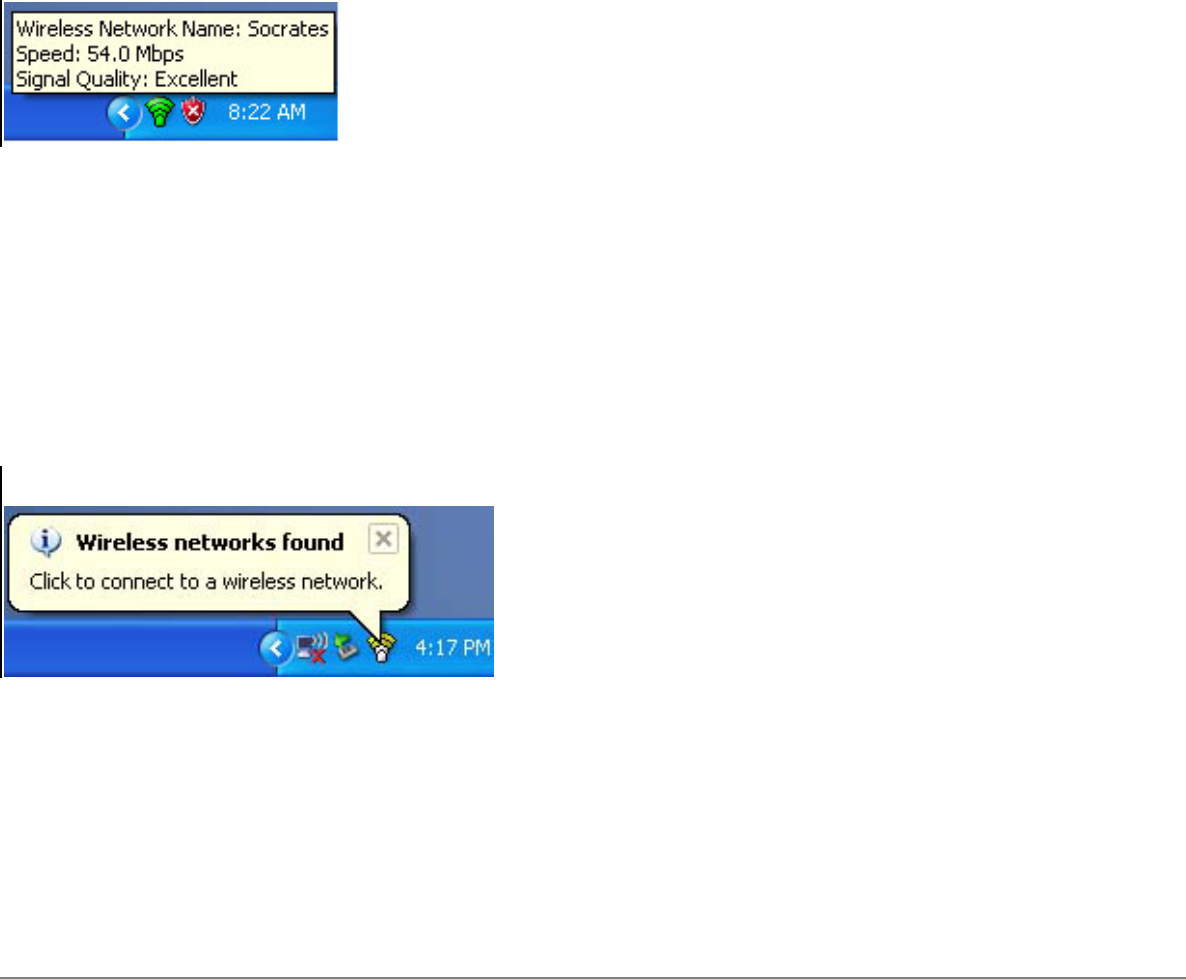
Using the Intel(R) PROSet Wireless Utility: Intel(R) PRO/Wireless 2200BG Network Connection User's Guide
Wireless Network Name: Intel
Speed: 54Mbps
Signal Quality: Excellent
Balloon Prompts
When user action is required, a balloon message prompt is displayed. If you click the
prompt, an appropriate action is taken. For example, when wireless networks are found, the
following balloon prompt appears:
Balloon Prompt description
Balloon Prompt Description
Wireless Network found.
Click to connect to a wireless network.
Launching Intel PROSet/Wireless from the Task Tray
To launch Intel PROSet/Wireless, use one of the following options:
● Click the task tray icon located in the lower right corner of your Windows desktop.
● Right-click the task tray icon and then click Open Intel PROSet/Wireless.
Administrator Tool
The Administrator Tool is used for administrators or the person who has administrator
privileges on this computer. This tool is used to configure shared (common) profiles.
This tool also allows the administrator to restrict what level of control the users of this
computer have over their wireless connections.
Users cannot modify administrator settings or profiles unless they have the password for this
tool. A password should be chosen that is secure.
file:///C|/Documents%20and%20Settings/pguillor/Desktop/w2k5/UtilIntc.htm (32 of 39) [7/2/2004 12:29:32 PM]

Using the Intel(R) PROSet Wireless Utility: Intel(R) PRO/Wireless 2200BG Network Connection User's Guide
You can export these settings and profiles as one package to other computers on your
network.
Name Description
Administrator Settings Settings button: Set the user's control over their wireless
network connections.
Administrator Profiles Options button: Enable or disable Persistent and Pre-Logon
profiles on the computer.
Persistent Connection: A Persistent profile is active during
boot time and when no user is logged onto the computer.
Pre-Logon/Common Connection: A Pre-Logon profile is
active once a user logs onto the computer. When Single Sign
On support is installed, this type of profile uses your
Windows logon user name and password. Pre-
logon/Common are placed at the top of the Profiles list.
Because these profiles are at the top of the list, when
available they are connected first.
Disable Intel Profile Switching. Users will only be able to
connect with the first Pre-Logon/Common profile:
Disable Profile Switching only applies to Pre-logon profiles.
Add: Launches the Profile Wizard to create a profile.
Remove: Removes a selected profile from the profiles list.
Properties: Allows users to edit the selected profile contents.
Change Password Allows users to change the Administrator Tool password.
Export Allows users to export settings and profiles as one package
to other computers on the network.
Close Closes the window.
Help? Displays the help for this window.
Administrator Export Preferences
file:///C|/Documents%20and%20Settings/pguillor/Desktop/w2k5/UtilIntc.htm (33 of 39) [7/2/2004 12:29:32 PM]

Using the Intel(R) PROSet Wireless Utility: Intel(R) PRO/Wireless 2200BG Network Connection User's Guide
Use the Administrator Settings and Profiles options to configure shared profiles for exporting.
Exported profiles can be pushed to any Intel PROSet/Wireless user’s 'auto import' folder.
IT Export Preferences window
Name Description
Export Administrator
Preferences Step 1: Select one or both types you want to export:
● Administrator Settings: Export all settings.
These include control of Cache Credentials and or
XP Co-existence options.
● Administrator Profiles: Export all the Persistent
and Pre-Logon/Common Profiles.
Step 2: Select the destination file:
● Browse button: Select the profile destination path
and directory. The export destination file has an
.sso extension. The directory path appears in the
destination directory window.
Step 3: Export the selected preferences:
● Export button: Start exporting your profiles to the
assigned destination folder.
Close Closes the window.
Help? Displays the help for this window.
Administrator Profile Options
These settings provide advanced profile connection options and allow the administrator to
enable or disable Persistent and or Pre-Logon/Common profiles on the computer.
Name Description
Persistent Connection A Persistent profile is active during boot time and
when no user is logged onto the computer.
file:///C|/Documents%20and%20Settings/pguillor/Desktop/w2k5/UtilIntc.htm (34 of 39) [7/2/2004 12:29:32 PM]

Using the Intel(R) PROSet Wireless Utility: Intel(R) PRO/Wireless 2200BG Network Connection User's Guide
Pre-Logon/Common Connection A Pre-Logon/Common profile is active once a user
logs onto the computer. These profiles appear at the
top of a user's profiles list. They cannot be modified
by the user without a password. Users can still
prioritize the profiles they have created but they
cannot re-prioritize Pre-logon/Common Profiles.
Since these profiles appear at the top of the profile
list, Intel PROSet/Wireless automatically attempts to
connect to the Administrator profiles first before any
user-created profiles.
OK Saves settings and close the window.
Cancel Cancels settings and close the window.
Help? Displays the help for this window.
Administrator Settings Window
These settings allow the administrator to control how users of this computer use their
wireless connection.
Name Description
Cache Credentials Cache the user credentials during a user session:
● Click checkbox: Cache user credentials in memory so that you
are only prompted the first time before connection instead of
each time you connect or disconnect to the network during the
Windows log on session.
● Clear checkbox: Prompt for credentials each time wireless
connectivity (authentication, re-authentication) is established
using 802.1x profiles with either the Use Windows Logon
credentials or the Prompt for Credentials on Connection option.
file:///C|/Documents%20and%20Settings/pguillor/Desktop/w2k5/UtilIntc.htm (35 of 39) [7/2/2004 12:29:32 PM]

Using the Intel(R) PROSet Wireless Utility: Intel(R) PRO/Wireless 2200BG Network Connection User's Guide
XP Co-existence Allow the user to enable XP Zero Configuration:
❍ Click checkbox: Displays a prompt, Windows XP is managing
your profiles, indicating that Windows XP Zero Configuration is
enabled and is managing your wireless adapter. You are
prompted to answer the following question:
Do you wish to disable Windows XP management and let Intel®
PROSet manage your wireless network?
❍ Select Yes, if you want Intel® PROSet/ Wireless to
manage your wireless adapter.
❍ Select No, if you want Windows XP to manage your
wireless adapter.
● Clear checkbox: If the box is cleared, when Intel®
PROSet/Wireless launches, you are not be notified in the event
that Windows XP Zero Configuration wireless manager is
enabled.
OK Saves settings and close the window.
Cancel Cancels settings and close the window.
Help? Displays the help information for this window.
Creating Administrator Profiles with the Administrator Tool
Administrator Profiles are created using the Administrator Tool. User profiles are created
from the Intel® PROSet/Wireless main window.
Administrator Profiles are user-based or shared profiles owned and managed by the network
administrator or the administrator of this computer. These profiles are common/shared by all
users on this computer. However, end users cannot modify these profiles; they can only be
modified using the Administrator Tool, which is password protected.
There are two types of Administrator profiles: Persistent and Pre-logon/Common.
Administrator Profiles are:
● Persistent Connection: This profile is applied at boot time or whenever no one is
logged on to the computer. A Persistent profile maintains a wireless connection either
file:///C|/Documents%20and%20Settings/pguillor/Desktop/w2k5/UtilIntc.htm (36 of 39) [7/2/2004 12:29:32 PM]

Using the Intel(R) PROSet Wireless Utility: Intel(R) PRO/Wireless 2200BG Network Connection User's Guide
until the computer is turned off or a different user logs on.
● Pre-Logon Common Connection: This profile is applied when a user logs on. If
Single Sign On support is installed, the connection is made as part of the Windows log-
on sequence (pre-logon). If Single Sign On support is not installed on the computer,
the profile is applied when the user session becomes active. Pre-logon/common
profiles always appear at the top of the user's Profiles list. Users can still prioritize their
profiles (the ones they created), but they cannot change the priority of Pre-
logon/Common Profiles. Because pre-logon/common profiles appears at the top of the
Profiles list, Intel® PROSet/Wireless automatically attempts to connect to the
Administrator-created profiles before any user-created profiles.
Pre-Logon Connection Status Window
When the Single Sign On component is installed, the user has Pre-logon support. During the
Windows log-on sequence, a Pre-logon Status window opens. This window displays the
progress of the network connection. After the wireless adapter is associated with the network
access point, the Status window closes.
1. After a system restart or power-up, the Windows Log On window opens, prompting
you to enter your Windows Log On domain, user name, and password.
2. Click OK. The PreLogon profile Status window displays the progress of the network
connection. After the wireless adapter is associated with the network access point, the
status window closes and the Windows user log on window is displayed.
Single Sign On and Windows XP Welcome Screen and Fast User
Switching
The Fast User Switching and the Windows XP Welcome Screen are disabled when Single
Sign On support is installed.
Single Sign On is targeted to the environment where users log on to their computer with a
user name, password, and typically a domain. Fast User Switching does not support domain
log on.
NOTE:Windows Fast User Switching is enabled by default is you are using Windows XP
Home Edition. It is targeted for the home user. Fast User Switching is also
available on Windows XP Professional if you install it on a stand-along or
workgroup-connected computer. If a computer running Windows XP Professional
is added to a domain, then the Fast User Switching option is not available.
file:///C|/Documents%20and%20Settings/pguillor/Desktop/w2k5/UtilIntc.htm (37 of 39) [7/2/2004 12:29:32 PM]

Using the Intel(R) PROSet Wireless Utility: Intel(R) PRO/Wireless 2200BG Network Connection User's Guide
Modifying and Uninstalling the Software
The Single Sign On Pre-Logon Connection feature is not installed during the Typical
installation process. To install this feature, use the Custom option during the installation
process.
Installing and Uninstalling the Single Sign On Feature
The Single Sign On Pre-Logon Connect feature is not installed during the initial software
installation process. This feature can be installed or uninstalled after Intel®
PROSet/Wireless has been installed.
To install the Single Sign On the Pre-Logon Connect feature after Intel® PROSet/Wireless
has been installed:
1. Click Start àSettings àControl Panel àAdd or Remove Programs àIntel
PROSet/Wireless.
2. Select Change/Remove.
3. On the Program Maintenance screen select Modify and then click Next.
4. Click Single Sign On. Select Install this feature and all subfeatures. Note:
Windows XP Fast Switching and the Welcome screen are disabled when the Single
Sign On feature options are installed.
5. Click Modify. After the software is installed on your computer, the component is listed
as Installed.
6. Click OK.
To remove the Single Sign On Pre-Logon Connect feature:
1. Click Start àSettings àControl Panel àAdd or Remove Programs àIntel
PROSet/Wireless.
2. Select Change/Remove.
3. On the Program Maintenance screen select Modify and then click Next.
4. Click Pre-Logon connect subfeature of Single Sign On. Select Do not install this
feature. A red X appears next to the option.
5. Click Modify. After the feature is uninstalled on your computer, the component is listed
as Not Present.
file:///C|/Documents%20and%20Settings/pguillor/Desktop/w2k5/UtilIntc.htm (38 of 39) [7/2/2004 12:29:32 PM]

Using the Intel(R) PROSet Wireless Utility: Intel(R) PRO/Wireless 2200BG Network Connection User's Guide
6. Click OK.
Uninstalling Intel PROSet/Wireless
The Intel PROSet/Wireless software can be uninstalled.
To remove Intel PROSet/Wireless:
1. Click Start > Settings > Control Panel > Add or Remove Programs > Intel
PROSet/Wireless.
2. Select Change/Remove.
3. Select Modify on the Program Maintenance screen
4. Click Next.
5. Click OK. After the software is uninstalled on your computer, the component is listed
as Not Present.
6. Click OK.
Windows XP Wireless Zero Configuration Feature
The Windows XP Wireless Zero Configuration feature provides a built-in wireless
configuration utility. This feature can be enabled and disabled in Windows XP or by clicking
Use Microsoft Client on the Tools menu. If XP Zero Configuration is enabled the features in
Intel® PROSet/Wireless are disabled.
Back to Top
Back to Contents
file:///C|/Documents%20and%20Settings/pguillor/Desktop/w2k5/UtilIntc.htm (39 of 39) [7/2/2004 12:29:32 PM]

Profiles
Back to Contents
Using Intel® PROSet/Wireless Profiles
What Is a Profile?
Profile Types
Administrator Profiles
Profiles List
Loading a Profile from the Task Tray
Creating a New Profile Using the Profile Wizard
Configuring Multiple Profiles
Editing a Profile
Adding WEP Encryption to a Profile
Creating an Ad Hoc Connection with an Existing Profile
Deleting a Profile
Setting a Profile Password
Importing and Exporting Profiles
Automatic Profile Distribution
Connecting to a Network without a Profile
Connecting to a Network with a Blank SSID
Profile Connection Preferences
What Is a Profile?
A profile is a saved group of network settings. Profiles are useful when moving from one wireless
network to another. Different profiles can be configured for each wireless network. Profile settings
must include the network name (SSID), operating mode, and security settings. From the Intel
PROSet/Wireless main window, you can add, edit, and remove profiles.
A profile is created when you connect to a wireless network. When you select a network from the
Available networks list and click Configure, the Profile Wizard is launched. The Profile Wizard
guides you through the settings required to connect to a wireless network. When the profile is
complete, you can save it, and it is added to the Intel PROSet/Wireless main window Profiles list.
Because these are saved settings, the next time you are in range of this wireless network, you are
automatically connected. For more information, refer to Profile Wizard Overview.
file:///C|/Documents%20and%20Settings/pguillor/Desktop/w2k5/Profiles.htm (1 of 21) [7/2/2004 12:29:37 PM]

Profiles
Profile Types
There are two types of profiles that can be used to connect to a wireless network. The profile types
are:
● User Profiles: These profiles are created by the user. If there is more than one user on a
computer network, the other users will need to create their own profiles. User-created
wireless profiles are not accessible by other network users.
● Administrator Profiles: If one or more profiles need to be shared among users on a
network, you need to install the Administrator Tool and create Administrator profiles. For
more information, refer to Administrator Profiles.
Administrator Profiles
Administrator Profiles are created using the Administrator Tool. User profiles are created from the
Intel PROSet/Wireless main window.
Administrator Profiles are user-based or shared profiles owned and managed by the network
administrator or the administrator of this computer. These profiles are common/shared by all users
on this computer. However, end users cannot modify these profiles; they can only be modified
using the Administrator Tool, which is password protected.
There are two types of Administrator profiles: Persistent and Pre-logon/Common.
Administrator Profiles are:
● Persistent Connection: This profile is applied at boot time or whenever no one is logged on
the computer. A Persistent profile maintains a wireless connection either until the computer is
turned off or a different user logs on.
● Pre-Logon Common Connection: This profile is applied when a user logs on. If Single Sign
On support is installed, the connection is made as part of the Windows log-on sequence (pre-
logon). If Single Sign On support is not installed on the computer, the profile is applied when
the user session becomes active. Pre-logon/common profiles always appear at the top of the
user's Profiles list. Users can still prioritize their profiles (the ones they created), but they
cannot change the priority of Pre-logon/Common Profiles. Because pre-logon/common
profiles appears at the top of the Profiles list, Intel PROSet/Wireless automatically attempts
to connect to the Administrator profiles before any user-created profiles.
For more information about these profiles, see Creating Administrator Profiles with the
Administrator Tool.
file:///C|/Documents%20and%20Settings/pguillor/Desktop/w2k5/Profiles.htm (2 of 21) [7/2/2004 12:29:37 PM]
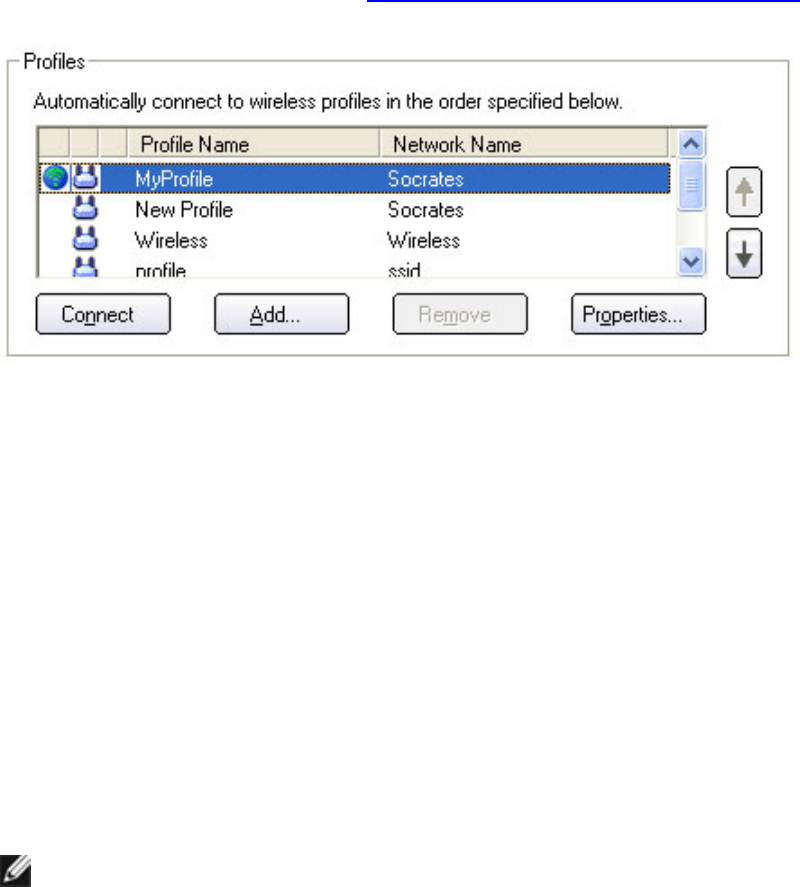
Profiles
Profiles List
The Profiles list displays a list of existing profiles. When you are in range of a wireless network,
Intel PROSet/Wireless scans the Profiles list to see if there is a match. If a match is found, you are
automatically connected to the network. For more information, see Configuration Service.
The priority order of the Profiles list is the same as the priority used by Intel PROSet/Wireless to
find a match.
The Profiles List, found on the Intel PROSet/Wireless main window:
● Use the up and down arrows to arrange profiles in a specific order to automatically connect
to a wireless network.
Profiles can be arranged in a specific order of connection: 1 is the highest priority. The
Configuration Service also uses the profiles priority list to connect to wireless networks. The
Profiles list displays the available user-based and shared profiles. User-based profiles can be
arranged in order of network connection priority. Administrator (shared) profiles will always take
precedence over user-based profiles. You can connect to one network, using the first profile in the
Profiles list, and then automatically connect to another network using the next profile. This allows
you to stay connected while roaming freely from one wireless network to another. Although you can
assign multiple profiles to a single network, you can only use one profile per connection. To add a
new profile, use the Profile Wizard sequence of windows to configure the profile contents. The
following sections discuss how to set up and configure a profile to connect to a network.
NOTE: Administrator (shared) Pre-Logon or Persistent profiles are displayed at the top of the
Profiles list. These profiles have priority over user-based profiles. Shared profiles in the Profiles list
cannot be modified only viewed.
● Use the Connect button to connect a profile to the selected wireless network. You can also
add, edit, and remove profiles from the main window.
file:///C|/Documents%20and%20Settings/pguillor/Desktop/w2k5/Profiles.htm (3 of 21) [7/2/2004 12:29:37 PM]

Profiles
Profile Icons
The network profile status icons indicate whether the adapter is associated with a network, the type
of operating mode being used, and whether security encryption is enabled. These icons are shown
next to the profile name in the profile list. Refer to Profiles for details.
Connecting to a Profile
When you are in range of a wireless network that has a matching profile, you will be automatically
connected to that network. If a network with a lower priority profile is also in range, you can force
the connection to that lower profile. This can be accomplished using Intel PROSet/Wireless or from
the task tray icon.
Manually connecting to a profile from Intel PROSet/Wireless
1. To open Intel PROSet/Wireless, double-click the task tray icon.
2. From the Profiles list, select an existing profile.
3. Click Connect. Remember: The connection will only be made if the wireless network is in
range.
Manually connecting to a profile from the task tray icon
1. Right-click the Intel PROSet/Wireless icon on the task tray.
2. Select Connect to Profile, and then click the desired profile.
Loading a Profile from the Task Tray
To load a profile from the Task Tray:
1. Right-click the Intel PROSet/Wireless connection icon in the task tray.
2. Make sure that the Intel PROSet/Wireless connection manager is selected (not Microsoft
client).
3. Click Connect to Profile and select the profile to be launched.
Profile Wizard Overview
file:///C|/Documents%20and%20Settings/pguillor/Desktop/w2k5/Profiles.htm (4 of 21) [7/2/2004 12:29:37 PM]

Profiles
Use the Profile Wizard to create a network profile for connection to a specific wireless network.
When the Intel Configuration Service detects an available network and the adapter is not
associated with another wireless network, the Connect to wireless network window is displayed.
From Intel PROSet/Wireless, select a network from the Available Networks list and click
Configure. The Profile Wizard guides you through the wireless network configuration process.
● Security Detection: After you select a wireless network from the Available Networks list, the
General Settings page opens to display the network name and operating mode for the
selected network. The identified Wireless Network Name (SSID) cannot be modified, but you
can change the Profile name. Click Next to display the second Profile wizard Security
progress page. This starts the access point query process to determine the highest level of
security required for the selected network. After the required security is determined, the
Security settings page displays the required information that must be entered to connect to
that particular network. For example, if an Infrastructure WEP network is selected, WEP
encryption and key index information is displayed, but only the WEP Network Key needs to
be entered. If you do not know the required network settings, contact your administrator.
Profiles
To add profiles or to edit an existing profile:
● Add (Create a new profile): Click Add to open the Profile wizard and create a new profile.
In this mode all of the General and Security page settings are blank and require that you
enter adapter and wireless network information. Before creating a new profile, contact your
administrator for the required network settings, or have the necessary network information
ready to enter.
● Properties (Edit a profile): Click Properties to open the Profile Wizard and edit the profile
contents. The General Settings and Security Settings pages display all of the profile settings
and parameters that can be modified.
For more information, refer to Creating a New Profile Using Profile Wizard or Configuring Multiple
Profiles Using Profile Wizard.
Creating a New Profile Using the Profile Wizard
The Profile Wizard allows you to create a new profile, configure the profile contents, and connect to
a wireless network. If you select a network from the Available Networks list and click Configure,
the Profile Wizard guides you through the necessary steps to create a profile and connect to the
network. During this process, the Profile Wizard attempts to detect the appropriate security settings
for you.
file:///C|/Documents%20and%20Settings/pguillor/Desktop/w2k5/Profiles.htm (5 of 21) [7/2/2004 12:29:37 PM]

Profiles
To create a new profile and connect to a wireless network:
1. From the Intel PROSet/Wireless main window, click Add. The Profile Wizard launches, and
the General Settings window opens.
2. In the Profile Name text box, enter a profile name.
3. in the Wireless Network Name (SSID) text box, enter the Wireless Network Name.
4. Select the Operating Mode you want to use, Infrastructure or Ad Hoc.
5. For the following options, click Advanced:
● Password protect the profile: Select the Password protect this profile checkbox. Enter the
password in the text box, and then re-enter it in the Confirm Password text box.
● Auto-Import: Allows automatic import of this profile. For network administrators only.
● Mandatory Access Point: Makes the wireless adapter associate with a specific access point.
6. To save your settings and return to the General Settings page, click OK.
7. Click Next. The Security Settings window opens.
8. Select the Network Authentication and Data Encryption options. Enter the encryption key
settings and configure the 802.1x settings as required. Refer to security settings for more
information.
9. When you complete the profile settings, click OK to return to the Intel PROSet/Wireless
window. (To change or verify the profile settings, select the profile and click Properties.)
10. From the Profiles list, select the new profile name.
11. To connect to the wireless network, click Connect. The network name, transmit and receive
speed, and signal quality are displayed.
12. To close the window, click Close.
Configuring Multiple Profiles Using Profile Wizard
Typically, one profile is assigned for a particular network connection. If there are multiple profiles
assigned to one wireless network name (SSID), before connection to the network, Intel
PROSet/Wireless configuration Service displays a window showing the multiple profile names for
that particular network. One profile must be selected to connect to the network.
To configure a profile to a network for which a wireless profile already exists.
1. Open the Intel PROSet/Wireless window.
2. From the Available Networks list, select the network to which you want to configure a profile:
file:///C|/Documents%20and%20Settings/pguillor/Desktop/w2k5/Profiles.htm (6 of 21) [7/2/2004 12:29:37 PM]
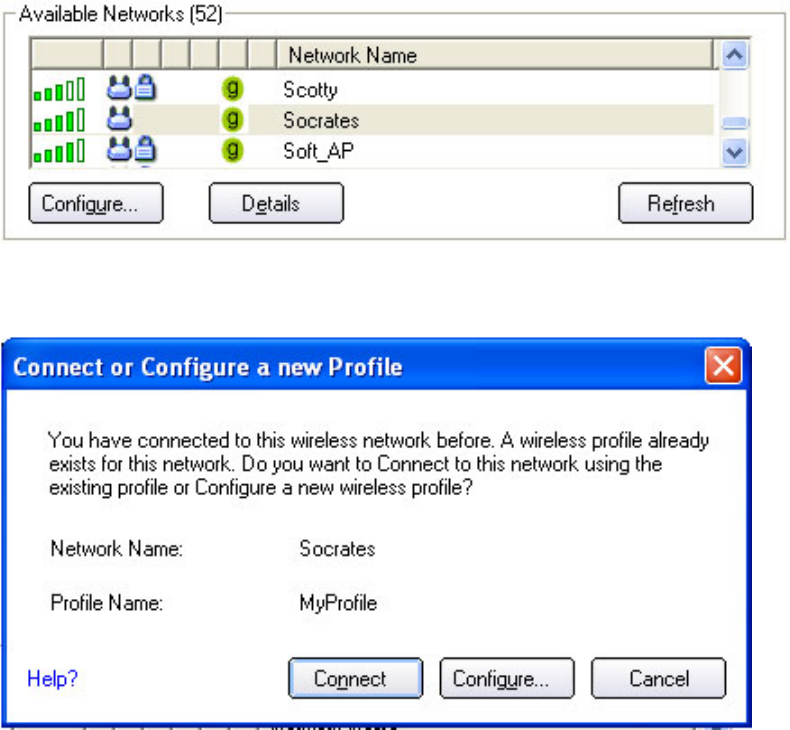
Profiles
3. Click Configure. The connect or configure a New Profile window opens:
4. Click Configure. The Configure Wireless Settings window opens, indicating you need to
designate settings for the new profile:
file:///C|/Documents%20and%20Settings/pguillor/Desktop/w2k5/Profiles.htm (7 of 21) [7/2/2004 12:29:37 PM]
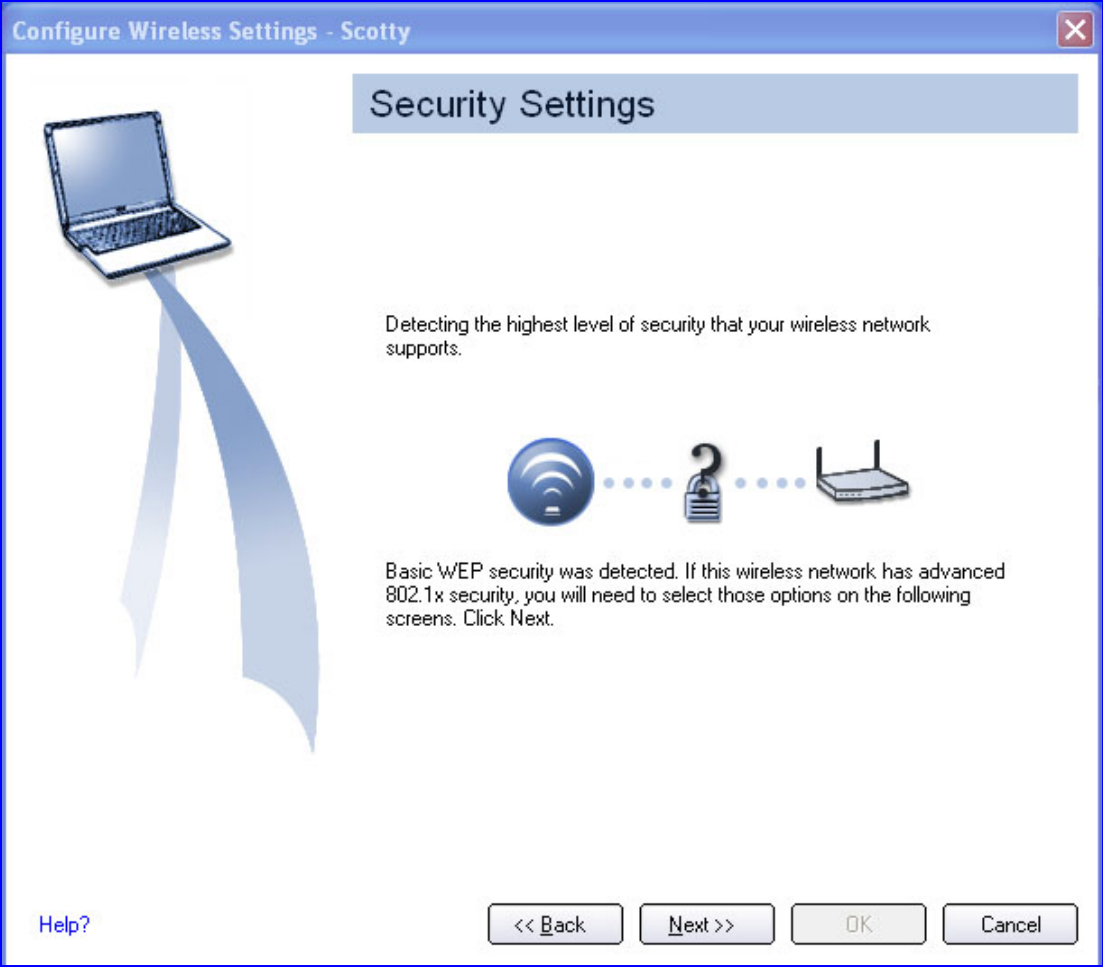
Profiles
5. Click Next. The General Settings window opens:
file:///C|/Documents%20and%20Settings/pguillor/Desktop/w2k5/Profiles.htm (8 of 21) [7/2/2004 12:29:37 PM]
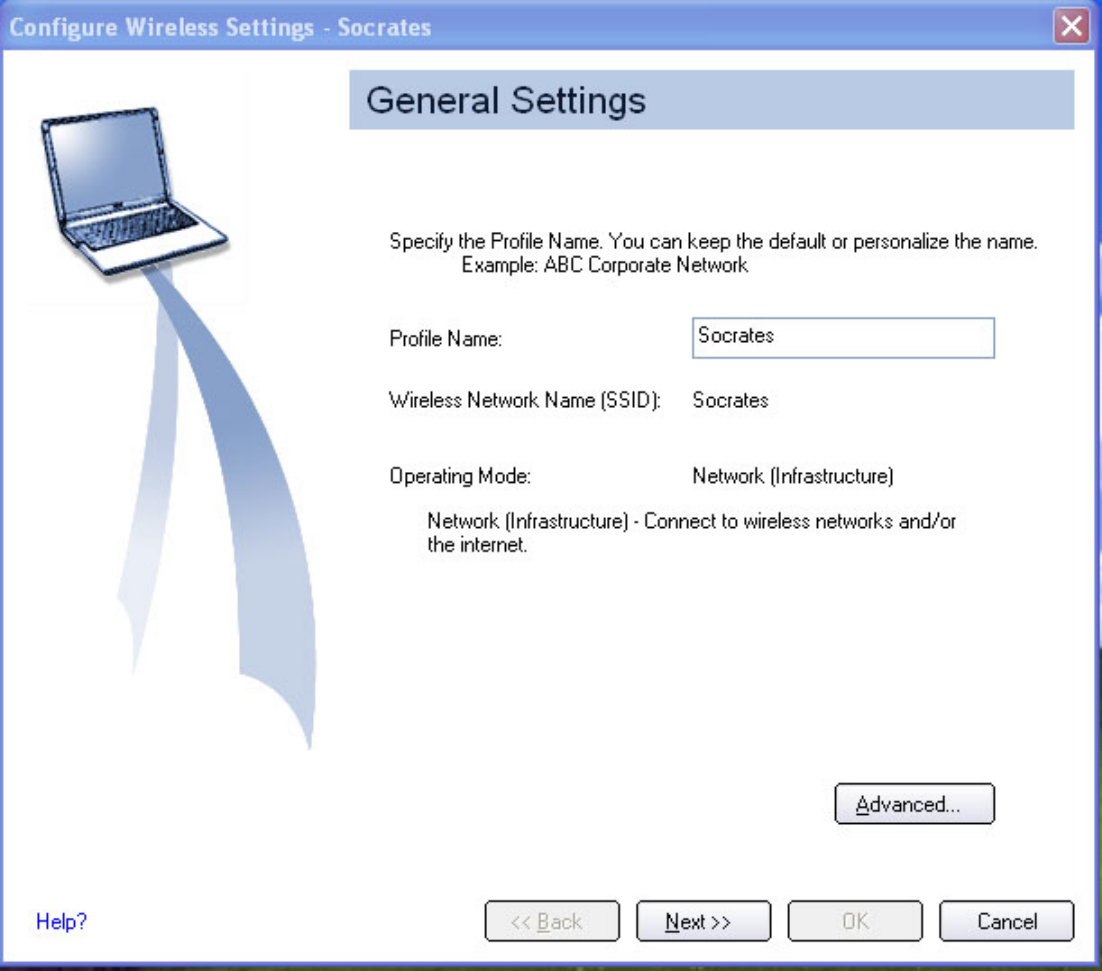
Profiles
6. In the Profile Name text box, enter a name for the profile and then click Next. The Security
Settings window opens:
file:///C|/Documents%20and%20Settings/pguillor/Desktop/w2k5/Profiles.htm (9 of 21) [7/2/2004 12:29:37 PM]

Profiles
7. Enter the Wireless Security Password (WEP Key) and click Next.
8. When the next window opens, showing you are done, click OK. You are returned to the Intel
PROSet/Wireless main window.
NOTE: If the Network requires a password, a password window will open, prompting you to
enter the password.
General Settings Window
The General Settings window is the first page in the Profile Wizard. From this page you can
specify the profile name, the wireless network name (SSID) and choose the operating mode.
file:///C|/Documents%20and%20Settings/pguillor/Desktop/w2k5/Profiles.htm (10 of 21) [7/2/2004 12:29:37 PM]

Profiles
While configuring the profile, you can use the left pane to navigate to the General and Security
Settings pages. The Back and Next button located at the bottom of the Profile Wizard can also be
used for the same functions.
General Settings window description
Name Description
Profile Name Name of the wireless network profile.
Examples: My Office Network, Bob's Home Network, ABC
Company Network, etc.
Wireless Network Name (SSID) Name of the wireless network access point used by the
wireless adapter for connection. The SSID must match
exactly the name of the wireless access point. It is case
sensitive.
When you are configuring a wireless network that was
selected from the Available Networks list, the SSID is taken
from the available network list. You cannot and should not
change it.
Blank SSID: If the wireless adapter receives a blank network
name (SSID) from a stealth access point, <SSID not
broadcast> is displayed in the available networks list.
Provide the actual SSID for the access point. After
connection both the blank SSID and the associated SSID
can be viewed in the available networks list.
Operating Mode Network (Infrastructure): Connect to an access point. An
infrastructure network consists of one or more access points
and one or more computers with wireless adapters. This
connection is the type used in home networks, corporate
networks, hotels and others to provide access to the network
and/or the internet.
Device to device (Ad hoc): Connect directly to other
computers in an ad hoc wireless network. This type of
connection is useful for connections between 2 or more
computers only. It will not provide access to network
resources or the Internet.
Advanced Advanced Settings allows you to set a profile password,
specify a certain access point address for adapter
connection (Mandatory AP), or allow the profile to be Auto-
Imported on another computer.
file:///C|/Documents%20and%20Settings/pguillor/Desktop/w2k5/Profiles.htm (11 of 21) [7/2/2004 12:29:37 PM]

Profiles
Administrator Profiles If you are creating or editing an Administrator profile from the
Administrator Tool you have the following options:
Persistent Connection: This is active when no user is
logged on. It is used to maintain a wireless connection when
no users are logged on.
Pre-Logon/Common: This is active when a user is logged
on. This profile is shared by all users. It is useful when you
want all users of a computer to use a specific profile. This
profile appears at the top of the profile list in
PROSet/Wireless.
Users cannot edit/modify Administrator profiles. They can
only be edited from the Administrator Tool.
NOTE: The Administrator Tool is only available if it has been
installed.
Next Opens Security Settings page.
Cancel Closes the Profile Wizard and cancels any changes.
Help? Displays the help for this window.
Security Settings Window
From the Security Settings page you can enter the required security settings for the selected
wireless network.
NOTE: The options displayed are dependent on the Operating Mode selected on the General
Settings page.
Security Settings Description
Name Setting
Network Authentication Open
Shared
WPA-Enterprise
WPA2-Enterprise
WPA-Personal
WPA2-Personal
file:///C|/Documents%20and%20Settings/pguillor/Desktop/w2k5/Profiles.htm (12 of 21) [7/2/2004 12:29:37 PM]

Profiles
Data Encryption None
WEP
CKIP
TKIP
AES-CCMP
Enable 802.1x (Authentication Type) MD5
EAP-SIM
TLS
TTLS
PEAP
LEAP
EAP-FAST
Cisco Options Click to view the Cisco Compatible Extensions
Options window.
NOTE: Cisco Compatible Extensions are
automatically enabled for CKIP, LEAP and EAP-
FAST profiles.
Back View the prior page in the Profile Wizard.
Next View the next page in the Profile Wizard. If more
security information is required then the next Step
of the Security page is displayed.
OK Close the Profile Wizard and save the profile.
Cancel Close the Profile Wizard and cancel any changes
made.
Help? Displays the help information for the current page.
Advanced Settings Description
From this window you can password protect a profile, enable the Auto-Import feature, and select a
specific access point on a network to connect to. Use the Advanced button on the General Settings
page to access this window.
Advanced Settings Description
Name Description
file:///C|/Documents%20and%20Settings/pguillor/Desktop/w2k5/Profiles.htm (13 of 21) [7/2/2004 12:29:37 PM]

Profiles
Password Protection Password: Password can be up to 10 characters. The entered
password characters display as asterisks.
Confirm New Password: Type the same password as entered in the
Password field.
Auto-Import Enable Auto-Import: Check to allow the profile to be imported and
exported to other computers. This option allows a network
administrator to distribute this profile automatically to computers
connected to a network. Refer to Automatic File Distribution for more
information.
Mandatory Access Point Mandatory Access Point: Forces the wireless adapter to connect to
an access point using a specific MAC address. Type the MAC
address of the access point (BSSID) 48-bit 12 hexadecimal digits,
e.g., 00:06:25:0E:9D:84. This feature is not available when using ad
hoc operating mode.
Clear button: Clear current address.
OK Close the window and save the settings.
Cancel Close the window and cancel any changes.
Help? Displays the help information for this window.
Editing a Profile
To edit an existing profile:
1. From the Profiles list, select the profile you want to edit.
2. Click Properties. The General Settings window opens.
3. In the left pane of the General Settings window, click General Settings or Security Settings.
4. Edit the settings are required:
● General Settings: Refer to General Settings for more information.
● Security Settings: Refer to Security Settings for more information.
5. When you finish editing the settings, click OK to return to the main window.
6. From the Profile list, select the edited profile name and click Connect. The connection
status, network name, transmit and receive speed, and signal quality are displayed.
Adding WEP Encryption to a Profile
file:///C|/Documents%20and%20Settings/pguillor/Desktop/w2k5/Profiles.htm (14 of 21) [7/2/2004 12:29:37 PM]

Profiles
NOTE: Before starting, you must obtain a user name and password on the RADIUS server from
your system administrator.rator.
To add WEP with no authentication to a new profile:
1. From Intel PROSet/Wireless window, click click Properties from the Profile list. The General
Settings window opens.
2. Click Next (or select Security Settings from the left pane). The Security Settings window
opens.
3. For the Network Authentication, select Open (recommended).
4. For Data Encryption, select WEP.
5. For the Encryption Level, select either 64-bit or 128-bit.
6. Select the key index 1, 2, 3, or 4 (1 is the default setting). When using the WEP key index,
each wireless station must use the same key index number to access the wireless network.
7. In the Wireless Security Password (WEP Key) text box, enter the Wireless Security
Password (WEP Key):
● 64-bit: Enter a text phrase, up to 5 alphanumeric characters (0-9, a-z, or A-Z), in the pass
phrase field or enter a hexadecimal value up to 10 alphanumeric characters (0-9, A-F) in the
Network Key field.
● 128-bit: Enter a text phrase, up to 13 alphanumeric characters (0-9, a-z, or A-Z), or enter a
hexadecimal value up to 26 alphanumeric characters (0-9, A-F) in the Network key field.
8. To save the profile settings, click OK.
Creating an Ad Hoc Connection with an Existing Profile
To create an ad hoc connection:
1. From the Intel PROSet/Wireless main window, select the profile you want from the profile list
and click Properties.
2. When the General Settings window opens, click Device to device (Ad hoc) - connect
directly to other computers.
3. Click Next.
4. For Data Encryption, select WEP.
5. For the Encryption Level, select 64- or 128-bit. The 128-bit level offers stronger encryption.
6. For the Key Index, select 1. When using WEP Key Index, each wireless station must use the
same key index number to access the wireless network.
7. Enter the Wireless Security Password (WEP Key):
● 64-bit: Enter a text phrase, up to 5 alphanumeric characters (0-9, a-z, or A-Z), in the pass
phrase field or enter a hexadecimal value up to 10 alphanumeric characters (0-9, A-F) in the
file:///C|/Documents%20and%20Settings/pguillor/Desktop/w2k5/Profiles.htm (15 of 21) [7/2/2004 12:29:37 PM]

Profiles
Network Key field.
● 128-bit: Enter a text phrase, up to 13 alphanumeric characters (0-9, a-z, or A-Z), or enter a
hexadecimal value up to 26 alphanumeric characters (0-9, A-F) in the Network key field.
7. To save the profile settings, click OK.
Deleting a Profile
To delete a profile:
1. Open the Intel ProSet/Wireless window.
2. From the Profiles List, click the profile to be deleted and click Remove.
3. When prompted to be sure you want to permanently delete the profile, click Yes.
NOTE:You cannot delete all profiles from the Profiles List. There must always be one profile
displayed in the list. If you are a restricted user the Delete button is disabled if you select
a Common profile. Common profiles can only be edited and deleted if you have
administrator privileges.
Setting a Profile Password
To password protect an existing profile:
1. From the Intel PROSet/Wireless main window, select a profile from the Profiles list and then
click Properties. The General Settings page opens.
2. Click the Advanced button.
3. Click Password protect this profile.
4. In the Password text box, type a password.
5. In the Confirm Password text box, re-type the password.
6. To save the setting and return to the General Settings page, click OK.
7. On the General Settings page, click OK.
8. To close the main window, click Close.
Connecting to a Network without a Profile
To connect to an available network without a profile using Windows:
1. Right-click the wireless client icon on the task tray and click Open Microsoft client.
2. Under Available Networks, click View Wireless Networks. A list of available networks
file:///C|/Documents%20and%20Settings/pguillor/Desktop/w2k5/Profiles.htm (16 of 21) [7/2/2004 12:29:37 PM]

Profiles
opens.
3. Select the network you want and click Connect. When you open the Microsoft client, the
network you selected will appear in the Preferred Networks list.
4. To check the connection status, right-click the Wireless Network icon on the task tray.
To connect to an available network without a profile using Intel PROSet/Wireless:
1. Open the Intel PROSet/Wireless window.
2. Under Available Networks, select the network you want to connect to.
3. Click Configure. A connection window opens.
4. Select Connect one time and click OK. The Wireless connection icon on the task tray
indicates that you are now connected to the selected network.
Connecting to a Network with a Blank SSID
If the wireless adapter receives a blank network name (SSID) from a stealth access point, <SSID
not broadcast> is displayed in the available networks list. To associate with a stealth access point,
a new profile must first be created before connection. After connection both the blank SSID and the
associated SSID can be viewed in the available networks list.
To connect to an access point that transmits a blank network name (SSID) in the Available
Networks list:
1. On the Intel PROSet/Wireless window, click the Refresh button.
2. Select the network name with a blank SSID and <no profile> shown in the Available
Networks list.
3. Click Configure.
4. The Profile Wizard window opens. Enter a profile name and Network Name (SSID) and
security settings if required.
5. Click Next until settings are complete.
6. To save the profile settings and return to the Wireless Networks tab, click OK.
7. Select the new profile from the Profiles List and click Connect.
Profile Connection Preferences
To access the profile connection preference option:
1. From the Intel PROSet/Wireless main window, click Application Settings on the Tools
menu.
2. Under Auto Connect, select one of the following options:
file:///C|/Documents%20and%20Settings/pguillor/Desktop/w2k5/Profiles.htm (17 of 21) [7/2/2004 12:29:37 PM]

Profiles
● Connect to available network using profiles only: (Default setting) Use the profiles in the
Profiles List to connect to any available network.
● Connect to any available network without using a profile from the Profile List.
● Connect to any network based on profiles only (Cisco mode): Tries every profile in
preferred order. This assumes the user knows they are in the vicinity of an access point
which has more than one SSID. It advertises only one wireless profile which allows you to get
connected easily to a network.
4. To save the setting, click OK.
5. To close the main window, click Close.
Importing and Exporting Profiles (Profiles menu)
You can import and export user-based profiles to and from the Profiles list. Wireless profiles can be
automatically imported into the Profiles list. This is accomplished by Intel PROSet/Wireless
monitoring the import folder on your hard disk for new profiles. Only profiles that have been
enabled (Enable Auto-Import) on the Profiles Import/Export window can be automatically imported.
If a profile of the same name already exists in the Profiles list, a window prompts you to reject or
accept the imported profile. If you accept it, the existing profile is replaced. All imported user-based
profiles are placed at the bottom of the Profiles list, and it is immediately deleted from the import
folder on your hard disk after import, whether the import was successful or not. For more
information, refer to Automatic Profile Distribution.
NOTE:A password protected profile can be imported and exported; however, before editing the
profile, the password must be entered. Refer to Setting a Profile Password for more
information. To export Administrator profiles, refer to Administrator Export Properties for
more information.
Import/Export Window Description
Name Description
file:///C|/Documents%20and%20Settings/pguillor/Desktop/w2k5/Profiles.htm (18 of 21) [7/2/2004 12:29:37 PM]

Profiles
Export profiles Select the profiles you want to export:
Select individual or multiple profiles from the list. The profile mode icon
indicates either infrastructure or ad hoc mode is being used and whether
security is being used.
Browse: Browse your hard disk for the destination directory. The directory
path is shown in the destination directory window.
Export: Start exporting profiles.
Import profiles Imports profiles in to the Profiles list.
Import: Browse your hard disk for files to import.
OK Saves settings and returns to the previous window.
Cancel Closes the window and cancels any changes.
Help? Displays help information for this window.
To import profiles:
1. Open the Intel PROSet/Wireless window.
2. On the menu bar, point to Profiles and then click Import/Export.
3. When the Import/Export Profiles window opens, click Import.
4. Select the profile you want to import and click Import. (The profiles extension is either
.profiles or .p50. The profiles to import can be located in any directory you choose on your
computer.)
5. When the Import Successful window appears, click OK.
6. To return to the main window, click Close.
To export profiles:
1. Open the Intel PROSet/Wireless window.
2. On the menu bar, point to Profiles and then click Import/Export.
3. When the Import/Export Profiles window opens, select the profile you want to export from the
Profiles list.
4. To select the destination folder, click Browse.
5. Select the destination folder and click Open.
6. Click Export.
7. When the Export Successful window appears, click OK.
8. To return to the main window, click Close.
file:///C|/Documents%20and%20Settings/pguillor/Desktop/w2k5/Profiles.htm (19 of 21) [7/2/2004 12:29:37 PM]

Profiles
Automatic Profile Distribution
The Enable Auto-Import feature allows a network administrator to distribute profiles automatically
to computers connected to a network. The Enable Auto-Import option is located on the Advanced
Settings window. Use the Advanced button on the General settings page to access the Advanced
Settings.
Importing Profiles
To distribute a profile automatically, the Enable Auto-Import must be selected, and then the profile
can be copied to a specific directory on the host computer. From there it can be distributed to
multiple computers. Once the profile is received by the remote computer it will automatically be
available for use on the Profiles list. If a profile is password protected when sent, the user will be
prompted for the password before the profile can be used.
Automatically importing wireless network profiles is accomplished by monitoring the import folder
on your hard disk for new profile files. Only profiles that have the Enable Auto-Import box checked
on the Profile Wizard Advanced page window can be automatically imported. If a profile of the
same name already exists in the Profiles List, a window is displayed from which you can either
reject the import, or accept in which case the existing profile will be replaced. All imported profiles
will be placed at the bottom of the Profiles List, and the profile file will be immediately deleted from
the import folder on your hard disk after the import whether the import was successful or not.
To import a profile into the Profiles List:
Step 1: Enable the enable Auto-Import feature:
a. From the Intel PROSet/Wireless window, select a profile to be edited from the Profiles List in
the Networks page, and click Properties (or click Add to create a new profile using the
Profile Wizard). The General Settings window opens.
b. Click Advanced. The Advanced Settings window opens.
c. Click the Enable Auto-Import check box.
d. To save the setting and close the window, click OK (Edit a profile) or Finish (Add a profile).
You are returned to the General Settings window.
e. Click OK. You are returned to the Intel PROSet/Wireless main window.
Step 2: Export the profile from the Profiles list to a folder on your hard disk. Refer to
Importing and Exporting Profiles for details.
Step 3: Copy the exported profile (.50/.profile extension) from its folder to the directory:
Program Files\Intel\Wireless\AutoImport. The profile is now ready to distribute to other
computers.
Step 4: Using a network copy utility such as SMS, you can distribute the profiles to each of
file:///C|/Documents%20and%20Settings/pguillor/Desktop/w2k5/Profiles.htm (20 of 21) [7/2/2004 12:29:37 PM]

Profiles
the remote computers on the network. The profiles much be copied into the following
directory on the remote computer: Program files/Intel\Wireless\AutoImport. The profile is
displayed in the Profiles list of the remote computer.
NOTE: If a profile is sent with password protection, the user is prompted for the password
before the profile can be used.
file:///C|/Documents%20and%20Settings/pguillor/Desktop/w2k5/Profiles.htm (21 of 21) [7/2/2004 12:29:37 PM]

Making a Basic Network Connection in Windows 2000: Intel PRO/Wireless 2915ABG Network Connection User's Guide
Back to Contents
Security Overview
WEP encryption
802.1x Authentication
WPA/WPA2
Cisco Features
This section describes the types of security used in connecting to wireless networks.
WEP encryption
Using IEEE 802.11 Wired Equivalent Privacy (WEP) encryption can prevent
unauthorized reception of wireless data. WEP encryption provides two levels of security,
using a 64-bit key (sometimes referred to as 40-bit) or a 128-bit key (also known as 104-
bit). For better security, use a 128-bit key. If you use encryption, all wireless devices on
your wireless network must use the same encryption keys.
WEP encryption and shared authentication provides protection for your data on the
network. WEP uses an encryption key to encrypt data before transmitting it. Only
computers using the same encryption key can access the network or decrypt the
encrypted data transmitted by other computers. Authentication provides an additional
validation process from the adapter to the access point.
The WEP encryption algorithm is vulnerable to passive and active network attacks. TKIP
and CKIP algorithms include enhancements to the WEP protocol that mitigate existing
network attacks and address its shortcomings
Open and Shared Key authentication
The 802.11 authentication supports two types of network authentication methods: Open
System and Shared Key.
● Using Open authentication, any wireless station can request authentication. The
station that needs to authenticate with another wireless station sends an
file:///C|/Documents%20and%20Settings/pguillor/Desktop/w2k5/Security_Overview.htm (1 of 7) [7/2/2004 12:29:43 PM]

Making a Basic Network Connection in Windows 2000: Intel PRO/Wireless 2915ABG Network Connection User's Guide
authentication management frame that contains the identity of the sending station.
The receiving station, or Access Point, grants any request for authentication. Open
authentication allows any device network access. If no encryption is enabled on the
network, any device that knows the SSID of the access point can gain access to
the network.
● Using Shared Key authentication, each wireless station is assumed to have
received a secret shared key over a secure channel that is independent from the
802.11 wireless network communications channel. Shared key authentication
requires that the client configure a static WEP key. The client access is granted
only if it passes a challenge-based authentication.
802.1x Authentication
The 802.1x authentication is independent of the 802.11 authentication process. The
802.1x standard provides a framework for various authentication and key-management
protocols. There are different 802.1x authentication types, each providing a different
approach to authentication but all employing the same 802.1x protocol and framework for
communication between a client and an access point. In most protocols, upon the
completion of the 802.1x authentication process, the supplicant receives a key that it
uses for data encryption. Refer to How 802.1x authentication works for more information.
With 802.1x authentication, an authentication method is used between the client and a
Remote Authentication Dial-In User Service (RADIUS) server connected to the access
point. The authentication process uses credentials, such as a user's password that are
not transmitted over the wireless network. Most 802.1x types support dynamic per-user,
per-session keys to strengthen the static key security. 802.1x benefits from the use of an
existing authentication protocol known as the Extensible Authentication Protocol (EAP).
The 802.1x authentication for wireless LANs has three main components: The
authenticator (the access point), the supplicant (the client software), and the
authentication server (a Remote Authentication Dial-In User Service [RADIUS] server).
The 802.1x authentication security initiates an authorization request from the wireless
client to the access point, which authenticates the client to an Extensible Authentication
Protocol (EAP) compliant RADIUS server. This RADIUS server may authenticate either
the user (via passwords or certificates) or the system (by MAC address). In theory, the
wireless client is not allowed to join the network until the transaction is complete. There
are several authentication algorithms used for 802.1x. Some examples are; MD5-
Challenge, EAP-TLS, EAP-TTLS, Protected EAP (PEAP), and EAP Cisco Wireless Light
file:///C|/Documents%20and%20Settings/pguillor/Desktop/w2k5/Security_Overview.htm (2 of 7) [7/2/2004 12:29:43 PM]

Making a Basic Network Connection in Windows 2000: Intel PRO/Wireless 2915ABG Network Connection User's Guide
Extensible Authentication Protocol (LEAP). These are all methods for the wireless client
to identify itself to the RADIUS server. With RADIUS authentication, user identities are
checked against databases. RADIUS constitutes a set of standards addressing
Authentication, Authorization and Accounting (AAA). Radius includes a proxy process to
validate clients in a multi-server environment. The IEEE 802.1x standard is for controlling
and authenticating access to port-based 802.11 wireless and wired Ethernet networks.
Port-based network access control is similar to a switched local area network (LAN)
infrastructure that authenticates devices that are attached to a LAN port and prevent
access to that port if the authentication process fails.
What is a RADIUS?
RADIUS is the Remote Access Dial-In User Service, an Authorization, Authentication,
and Accounting (AAA) client-server protocol, which is used when a AAA dial-up client
logs in or out of a Network Access Server. Typically, a RADIUS server is used by Internet
Service Providers (ISP) to perform AAA tasks. AAA phases are described as follows:
● Authentication phase: Verifies a user name and password against a local
database. After the credentials are verified, the authorization process begins.
● Authorization phase: Determines whether a request is allowed access to a
resource. An IP address is assigned for the Dial-Up client.
● Accounting phase: Collects information on resource usage for the purpose of
trend analysis, auditing, session time billing, or cost allocation.
How 802.1x authentication works
A simplified description of the 802.1x authentication is:
1. A client sends a "request to access" message to an access point. The access point
requests the identity of the client.
2. The client replies with its identity packet which is passed along to the
authentication server.
3. The authentication server sends an "accept" packet to the access point.
4. The access point places the client port in the authorized state and data traffic is
allowed to proceed.
file:///C|/Documents%20and%20Settings/pguillor/Desktop/w2k5/Security_Overview.htm (3 of 7) [7/2/2004 12:29:43 PM]

Making a Basic Network Connection in Windows 2000: Intel PRO/Wireless 2915ABG Network Connection User's Guide
802.1x features
● 802.1x supplicant protocol support
● Support for the Extensible Authentication Protocol (EAP) - RFC 2284
● Supported Authentication Methods:
● MD5 - RFC 2284
● EAP TLS Authentication Protocol - RFC 2716 and RFC 2246
● EAP Tunneled TLS (TTLS)
● Cisco LEAP
● EAP-FAST
● EAP-SIM
● PEAP
● Supports Windows XP, 2000
WPA and WPS2
Wi-Fi Protected Access (WPA) is a security enhancement that strongly increases the
level of data protection and access control to a wireless network. WPA enforces 802.1x
authentication and key-exchange and only works with dynamic encryption keys. To
strengthen data encryption, WPA utilizes its Temporal Key Integrity Protocol (TKIP).
TKIP provides important data encryption enhancements that include a per-packet key-
mixing function, a message integrity check (MIC) named Michael, an extended
initialization vector (IV) with sequencing rules, and also a re-keying mechanism. Using
these improvement enhancements, TKIP protects against WEP's known weaknesses.
The second generation of WPA that complies with the IEEE TGi specification is known
as WPA2.
WPA-Enterprise and WPA2- Enterprise: Provides this level of security on enterprise
networks with a 802.1x RADIUS server. An Authentication Type is selected to match the
authentication protocol of the 802.1x server.
WPA-Personal and WPA2-Personal: Provides this level of security in the small network
or home environment. It uses a password also called a pre-shared key (PSK). The longer
this password the stronger the security of the wireless network. If your Wireless Access
Point or Router supports WPA/WPA2 Personal, then you should enable it on the access
point and provide a long, strong password. The same password entered into access
point needs to be used on this computer and all other wireless devices that access the
file:///C|/Documents%20and%20Settings/pguillor/Desktop/w2k5/Security_Overview.htm (4 of 7) [7/2/2004 12:29:43 PM]

Making a Basic Network Connection in Windows 2000: Intel PRO/Wireless 2915ABG Network Connection User's Guide
wireless network.
Cisco Features
Cisco LEAP
Cisco LEAP (Cisco Light EAP) is a server and client 802.1x authentication via a user-
supplied logon password. When a wireless access point communicates with a Cisco
LEAP-enabled RADIUS (Cisco Secure Access Control Server (ACS) server), Cisco
LEAP provides access control through mutual authentication between client wireless
adapters and the wireless network and provides dynamic, individual user encryption keys
to help protect the privacy of transmitted data.
Fast Roaming (CCKM)
When a wireless LAN is configured for fast reconnection, a LEAP enabled client device
can roam from one access point to another without involving the main server. Using
Cisco Centralized Key Management (CCKM), an access point configured to provide
Wireless Domain Services (WDS) takes the place of the RADIUS server and
authenticates the client without perceptible delay in voice or other time-sensitive
applications.
CKIP
Cisco Key Integrity Protocol (CKIP) is Cisco proprietary security protocol for encryption in
802.11 media. CKIP uses the following features to improve 802.11 security in
infrastructure mode:
● Key Permutation (KP)
● Message Integrity Check (MIC)
● Message Sequence Number
EAP-FAST
EAP-FAST, like EAP-TTLS and PEAP, uses tunneling to protect traffic. The main
difference is that EAP-FAST does not use certificates to authenticate.
file:///C|/Documents%20and%20Settings/pguillor/Desktop/w2k5/Security_Overview.htm (5 of 7) [7/2/2004 12:29:43 PM]

Making a Basic Network Connection in Windows 2000: Intel PRO/Wireless 2915ABG Network Connection User's Guide
Provisioning in EAP-FAST is negotiated solely by the client as the first communication
exchange when EAP-FAST is requested from the server. If the client does not have a
pre-shared secret Protected Access Credential (PAC), it can request to initiate a
provisioning EAP-FAST exchange to dynamically obtain one from the server.
EAP-FAST documents two methods to deliver the PAC: manual delivery through an out-
of-band secure mechanism, and automatic provisioning.
● Manual delivery mechanisms can be any delivery mechanism that the
administrator of the network feels is sufficiently secure for their network.
● Automatic provisioning establishes an encrypted tunnel to protect the
authentication of the client and the delivery of the PAC to the client. This
mechanism, while not as secure as a manual method may be, is more secure than
the authentication method used in LEAP.
The EAP-FAST method can be divided into two parts: provisioning, and authentication.
The provisioning phase involves the initial delivery of the PAC to the client. This phase
only needs to be performed once per client and user.
Mixed Cells Mode
Some access points, for example Cisco 350 or Cisco 1200, support environments in
which not all client stations support WEP encryption, this is called Mixed-Cell Mode.
When these wireless networks operate in “optional encryption” mode, client stations that
join in WEP mode send all messages encrypted, and stations that join in using standard
mode send all messages unencrypted. These APs broadcast that the network is not
using encryption, but allow clients to join using WEP mode. When “Mixed-Cell” is
enabled in a profile, it allows you to connect to access points that are configured for
“optional encryption.”
Radio Management
When this feature is enabled your wireless adapter provides radio management
information to the Cisco infrastructure. If the Cisco Radio Management utility is used in
the infrastructure, it configures radio parameters, detects interference and rogue access
points.
Back to Top
file:///C|/Documents%20and%20Settings/pguillor/Desktop/w2k5/Security_Overview.htm (6 of 7) [7/2/2004 12:29:43 PM]

Configuring Advanced Network Security Settings in Windows XP: Intel PRO/Wireless 2915ABG Network Connection User's Guide
Back to Contents
Configuring Advanced Network Security Settings in
Windows XP: Intel® PROSet/Wireless 2915ABG Network
Connection User's Guide
Configuring an Ad Hoc Network with No Security
Configuring an Ad Hoc Network with WEP Security
Configuring a WPA-PSK Client with AES or TKIP Encryption
Configuring a WPA-PSK Client with AES or TKIP Encryption and TLS or TTLS Authentication
Configuring a WPA Client with AES or TKIP Encryption and PEAP Authentication
Configuring a Client for TLS/TTLS Authentication
If you are using Windows 2000, click Configuring Advanced Network Security Settings in Windows 2000 for
instructions on how to configure advanced security settings for your wireless adapter.
This section contains instructions about how to configure advanced security settings for your wireless
adapter. This requires information about advanced security settings on your access point (for home users) or
from a system administrator (corporate environment). Refer to Making a Basic Network Connection in Windows
XP for basic setup instructions.
NOTE:If you cannot view your network in the list of Available Networks, it may be because your network
does not broadcast or is in silent mode. Click Add and enter the name of the SSID of the network you
are trying to associate with to add it to the list of Preferred Networks. For further configuration, select
the added network and click Configure to edit security settings. Refer to the Troubleshooting section
for further instructions on how to configure networks with silent SSID’s.
If you are using Windows XP (Service Pack 2) Category View some of the windows shown in the
following examples may appear different from those on your screen. To switch from Category View to
Classic view, click Start àControl Panel and on the navigation bar click Switch to Classic View.
Configuring an Ad hoc Network with No Security
In peer-to-peer (ad hoc) mode, you can send and receive information to other computers without using an access
point. Each computer in a peer-to-peer network is called a peer. Creating an ad hoc network requires more than
one computer with a wireless adapter. All systems on the ad hoc network must be configured identically. You
can use peer-to-peer mode to network computers in a home or small office, or to set up a temporary wireless
network for a meeting.
To configure an ad hoc network connection with no security:
file:///C|/Documents%20and%20Settings/pguillor/Desktop/w2k5/XPAdv.htm (1 of 15) [7/2/2004 12:29:50 PM]
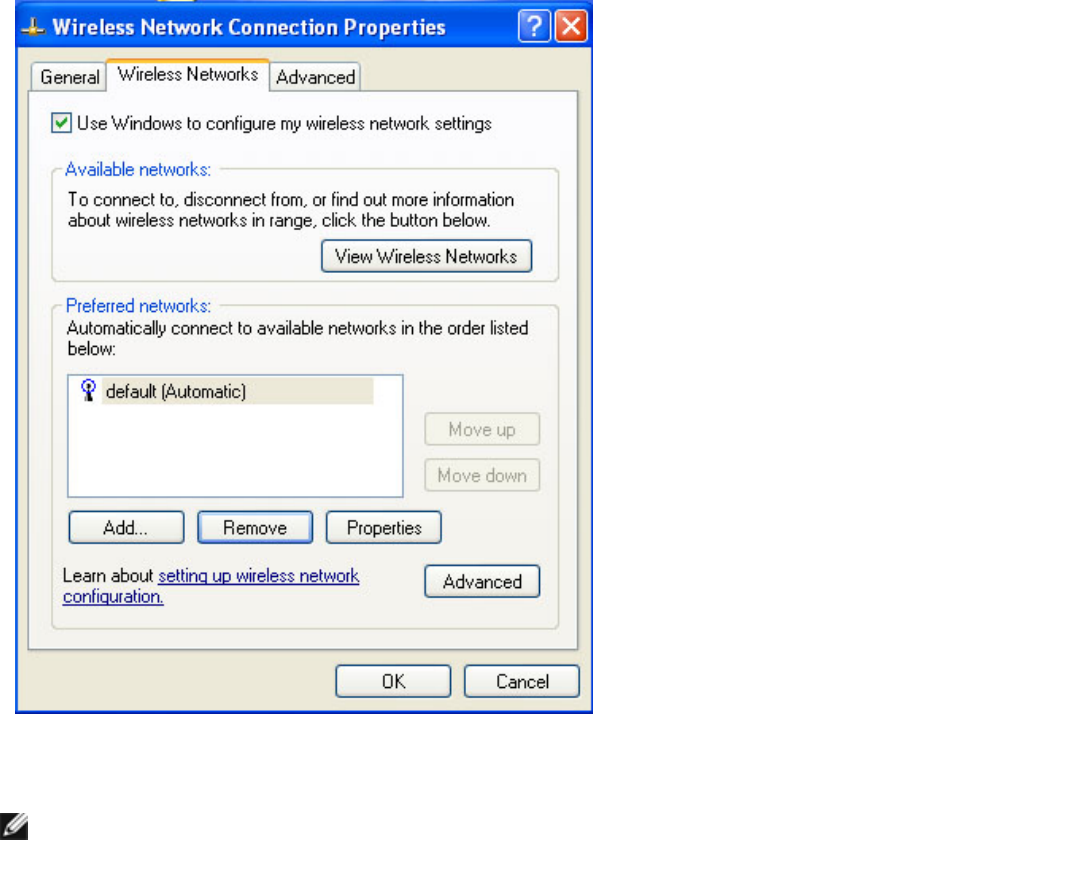
Configuring Advanced Network Security Settings in Windows XP: Intel PRO/Wireless 2915ABG Network Connection User's Guide
1. Click Start àSettings àControl Panel and double-click Network Connections.
2. Right-click Wireless Network Connection and click Properties.
3. On the Wireless Network Connection Properties window, select the Wireless Networks tab.
4. Verify that the Use Windows to configure my wireless network settings box is selected. If it is not,
select it. The correct setting is shown in the following illustration:
5. Click Add. The Wireless Network Connection Properties window opens.
NOTE:The names of wireless networks your computer can see are shown under Available
Networks. The name of the network is usually shown here.
6. In the Network name (SSID) text box, enter the name of the network you want to add.
7. For Network Authentication, select Open (default setting).
8. For Data encryption, select Disabled.
9. Select the This is a computer-to-computer (ad hoc) network; wireless Access Points are not used
checkbox. These settings are shown in the following illustration:
file:///C|/Documents%20and%20Settings/pguillor/Desktop/w2k5/XPAdv.htm (2 of 15) [7/2/2004 12:29:50 PM]
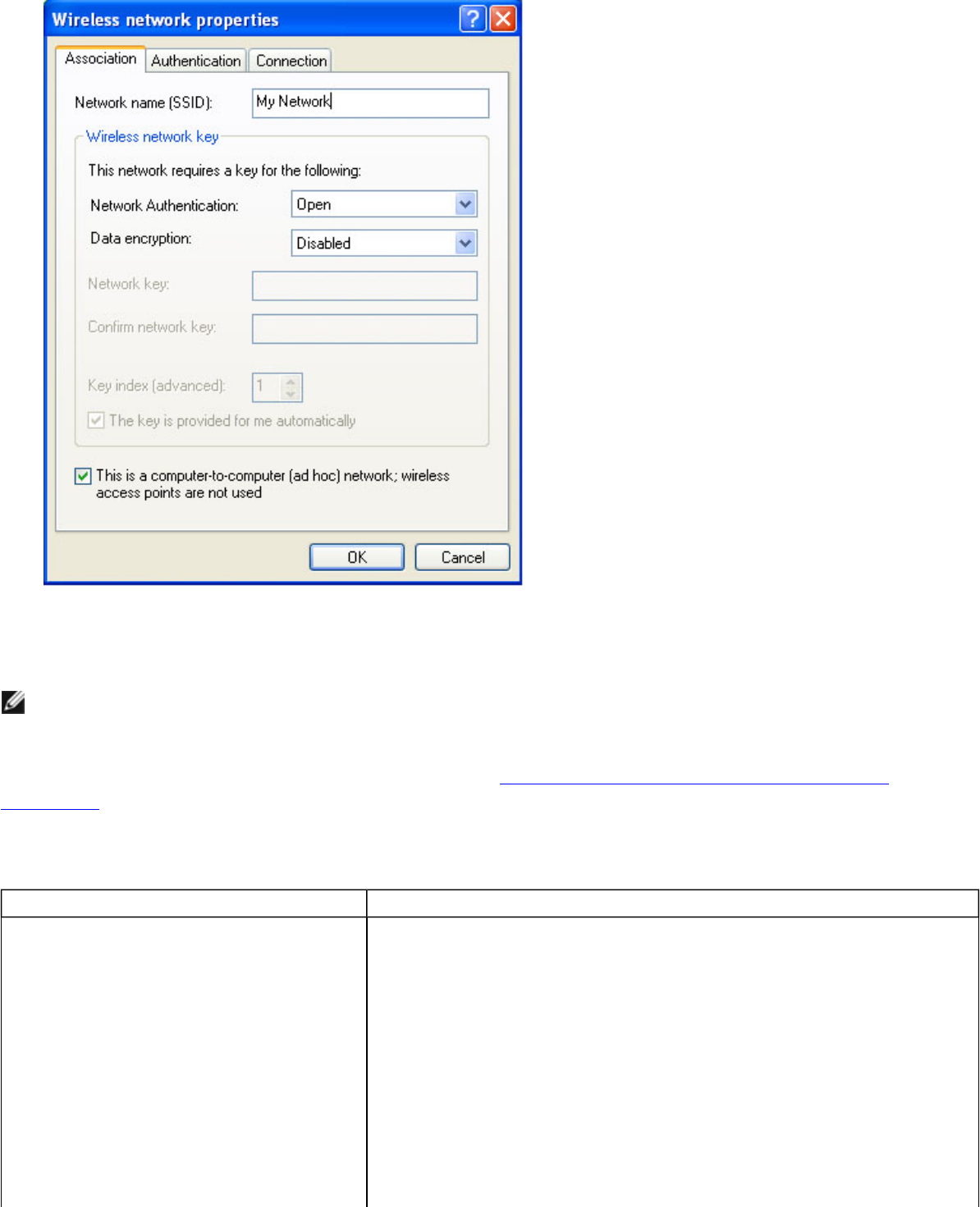
Configuring Advanced Network Security Settings in Windows XP: Intel PRO/Wireless 2915ABG Network Connection User's Guide
10. Click OK. You are returned to the Wireless Network tab, and the new network name appears in the
Preferred networks list.
NOTE:Internet connection and firewall settings under Windows XP (Service Pack 2) may affect the ability to
connect to an ad hoc network.
Your network configuration is now complete. Continue to Viewing the Status of your Wireless Network
Connection.
Ad hoc connection options
Name Description
Network Authentication Open: No authentication used. Open authentication allows a wireless
device access to the network without 802.11 authentication. The
access point allows any request for authentication. If no encryption is
enabled on the network, any wireless device with the correct network
name (SSID) can associate with the access point and gain access to
the network.
Shared: Shared authentication is accomplished with a pre-configured
WEP key. Use this mode for 802.11 Authentication. This mode can
work with any 802.1x authentication protocol and with the following
data encryption options; None, WEP (64-bit, or 128-bit) or CKIP (64-
bit, or 128-bit).
file:///C|/Documents%20and%20Settings/pguillor/Desktop/w2k5/XPAdv.htm (3 of 15) [7/2/2004 12:29:50 PM]

Configuring Advanced Network Security Settings in Windows XP: Intel PRO/Wireless 2915ABG Network Connection User's Guide
WPA-None: No authentication used on a Wi-Fi Protected Access
(WPA) client. This works with TKIP and AES data encryption in an ad
hoc connection.
Data Encryption Disabled: No data encryption is used.
WEP: WEP data encryption can be configured using 64-bit or 128-bit.
WEP settings can be used with all Network Authentication protocols.
When WEP encryption is enabled on an access point, the WEP key
provides a way to verify access to the network. If the wireless device
does not have the correct WEP key, even though authentication is
successful, the device is unable to transmit data through the access
point or decrypt data received from the access point.
Encryption Level 64-bit or 128-bit: 64-bit or 128-bit encryption.
Key Index 1,2,3,4: Up to four passwords may be specified by changing the Key
Index.
Wireless Security Password (WEP
Key) Type the wireless network Password (WEP Key) in the text box. The
Password is the same value used by the wireless access point or
router. Contact your wireless network administrator for this password.
Pass phrase (64-bit): Enter 5 ASCII characters (can use any
characters, including spaces).
Hex key (64-bit): Enter 10 alphanumeric hexadecimal characters, 0-
9, A-F.
Pass phrase (128-bit): Enter 13 ASCII characters (can use any
characters, including spaces).
Hex key (128-bit): Enter 26 alphanumeric hexadecimal characters, 0-
9, A-F.
Configuring an Ad hoc Network with WEP Security
One configuration option for your ad hoc network is to set it up with no security (data encryption disabled), but
this allows anyone to access your wireless network. Another option is to use WEP encryption. Using WEP
encryption provides some level of security for your wireless network.
To use configure your ad hoc network with WEP security:
1. Click Start àSettings àControl Panel and double-click Network Connections.
2. Right-click Wireless Network Connection and click Properties. The Wireless Network Connection
Properties window opens.
3. On the Wireless Network Connection Properties window, click the Wireless Networks tab as shown in the
following illustration:
file:///C|/Documents%20and%20Settings/pguillor/Desktop/w2k5/XPAdv.htm (4 of 15) [7/2/2004 12:29:50 PM]
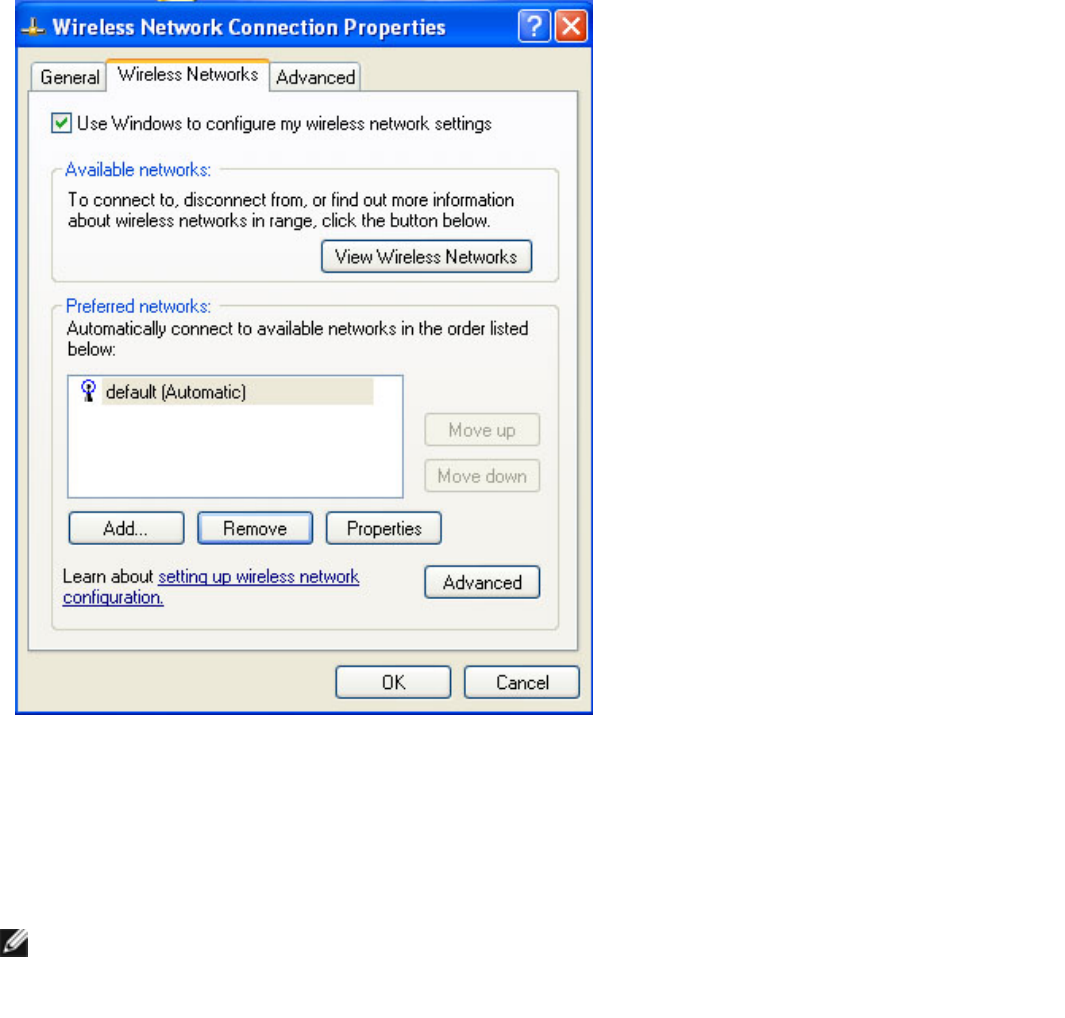
Configuring Advanced Network Security Settings in Windows XP: Intel PRO/Wireless 2915ABG Network Connection User's Guide
4. From the list of Preferred Networks, select the network and click Properties. The Network properties
window opens.
Note: Make sure that This is a computer-to-computer (ad hoc) network; wireless access points are
not used is selected.
5. On the Association tab, from the Network Authentication drop-down menu, select Open.
NOTE:Earlier versions of Windows XP software may not contain these drop-down menus. If you
are using one of these earlier versions, click to select the Data encryption (WEP
enabled) checkbox and continue with the next step.
6. From the Data Encryption drop-down menu, click WEP. These settings are shown in the following
illustration:
file:///C|/Documents%20and%20Settings/pguillor/Desktop/w2k5/XPAdv.htm (5 of 15) [7/2/2004 12:29:50 PM]
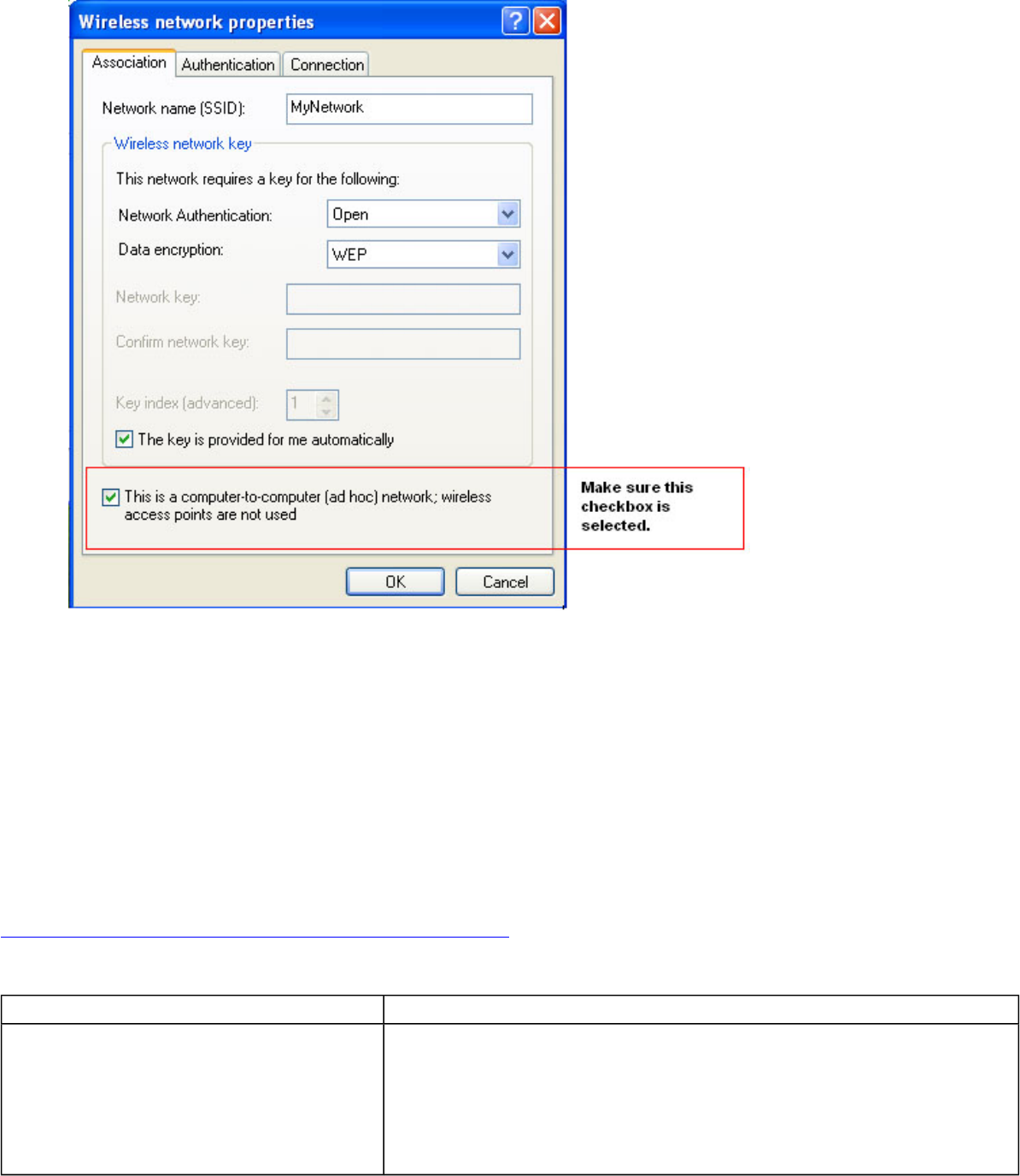
Configuring Advanced Network Security Settings in Windows XP: Intel PRO/Wireless 2915ABG Network Connection User's Guide
NOTE: If the wireless network does not require a network key (password), skip to step 10.
7. If you need to provide a network key, click to deselect The key is provided for me automatically.
8. In the Network key text box, type the WEP network key. Your Network key must exactly match the
password (network key) used by other computers in the ad hoc network. Your Network key will be either 5
or 13 ASCII (text) characters, or 10 or 26 hexadecimal (0-9, A-F) characters.
9. In the Confirm network key text box, type this key again.
10. To save your settings, click OK.
11. To close the Wireless Network Connection Properties window, click OK.
Your network configuration is now complete. For more information about the status of your connection, refer to
Viewing the Status of your Wireless Network Connection.
Ad hoc network connection using no network authentication (Open) with WEP data encryption
Name Description
Network Authentication Open: No authentication used. Open authentication allows a wireless
device access to the network without 802.11 authentication. The
access point allows any request for authentication. If no encryption is
enabled on the network, any wireless device with the correct network
name (SSID) can associate with the access point and gain access to
the network.
file:///C|/Documents%20and%20Settings/pguillor/Desktop/w2k5/XPAdv.htm (6 of 15) [7/2/2004 12:29:50 PM]

Configuring Advanced Network Security Settings in Windows XP: Intel PRO/Wireless 2915ABG Network Connection User's Guide
Data Encryption WEP: WEP data encryption can be configured using 64-bit or 128-bit.
WEP settings can be used with all Network Authentication protocols.
When WEP encryption is enabled on an access point, the WEP key
provides a way to verify access to the network. If the wireless device
does not have the correct WEP key, even though authentication is
successful, the device is unable to transmit data through the access
point or decrypt data received from the access point.
Encryption Level 64-bit or 128-bit: 64-bit or 128-bit encryption.
Key Index 1,2,3,4: Up to four passwords may be specified by changing the Key
Index.
Wireless Security Password (WEP
Key) Type the wireless network Password (WEP Key) in the text box. The
Password is the same value used by the wireless access point or
router. Contact your wireless network administrator for this password.
Pass phrase and hex key options are:
Pass phrase (64-bit): Enter 5 ASCII characters (can use any
characters, including spaces).
Hex key (64-bit): Enter 10 hexadecimal characters, 0-9, A-F.
Pass phrase (128-bit): Enter 13 ASCII characters (can include any
characters, including spaces).
Hex key (128-bit): Enter 26 alphanumeric hexadecimal characters, 0-
9, A-F.
Configuring a WPA-PSK Client with AES or TKIP Encryption
This security level is available for Infrastructure networks. To configure a WPA-PSK client:
1. Click Start àSettings àControl Panel and then double-click Network Connections.
2. Right-click Wireless Network Connection and click Properties.
3. On the Wireless Network Connection Properties window, select the Wireless Networks tab.
4. Verify that the Use Windows to configure my wireless network settings box is selected. If it is not,
select it.
5. From the Preferred Networks list, select the network you want and click Properties.
NOTE:If the wireless network access point is in silent mode (blank network name SSID) the
network name will not be displayed. You must first add the network name (SSID), then it
will appear in the list of available networks.
6. For Network Authentication, select WPA-PSK (Wi-Fi Protected Access Pre-shared Key).
file:///C|/Documents%20and%20Settings/pguillor/Desktop/w2k5/XPAdv.htm (7 of 15) [7/2/2004 12:29:50 PM]
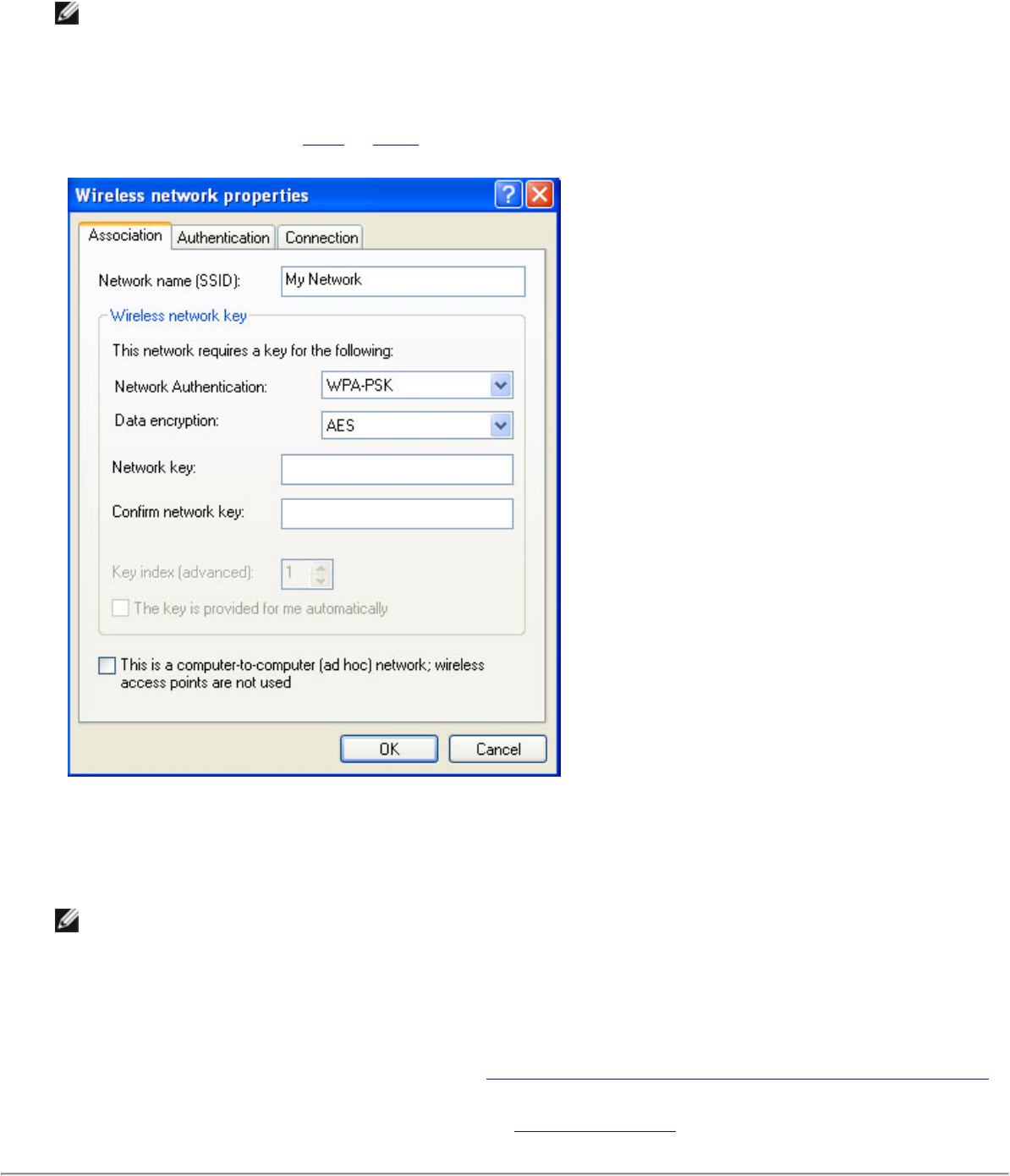
Configuring Advanced Network Security Settings in Windows XP: Intel PRO/Wireless 2915ABG Network Connection User's Guide
NOTE:Earlier versions of Windows XP did not support encryption modes such as WPA and WPA-
PSK. If you cannot view these options in the dropdown menu, please update Windows XP
to the latest service pack. If WPA is required the Microsoft WPA supplicant must also be
installed.
7. For Data Encryption, select AES or TKIP. These settings are shown in the following illustration:
8. If you need to provide a network key, click to deselect The key is provided for me automatically.
9. Enter the network key in the Network Key and the Confirm Network Key box. The network key must be a
text phrase from 8 to 63 characters long or, a Hex key (0-9, A-F) 64 characters long.
NOTE:Refer to your access point/router settings (for home users) or, contact your system administrator
for the data encryption type and network key (enterprise users.)
10. To save your settings, click OK .
11. To close the Wireless Network Connection Properties window, click OK.
For more information about connection status, refer to Viewing the Status of your Wireless Network Connection.
For more information about PEAP authentication, refer to Security Overview.
Configuring a WPA-PSK Client with AES or TKIP Encryption and TLS or TTLS
file:///C|/Documents%20and%20Settings/pguillor/Desktop/w2k5/XPAdv.htm (8 of 15) [7/2/2004 12:29:50 PM]

Configuring Advanced Network Security Settings in Windows XP: Intel PRO/Wireless 2915ABG Network Connection User's Guide
Authentication
Transport Layer Security TLS and Tunneled Transport Layer Security (TTLS) settings define the protocol and the
credentials used to authenticate a user. TLS is a type of authentication method using Extensible Authentication
Protocol (EAP) and a security protocol called Transport Layer Security. EAP-TLS uses certificates that require
passwords. EAP-TLS authentication supports dynamic WEP key management. The TLS protocol is intended to
secure and authenticate communications across a public network through data encryption. The TLS Handshake
Protocol allows the server and client to provide mutual authentication and to negotiate an encryption algorithm
and cryptographic keys before data is transmitted. In TTLS, the client uses EAP-TLS to validate the server and
create a TLS-encrypted channel between the client and server. The client can use another authentication
protocol, typically password-based protocols, such as MD5 Challenge over this encrypted channel to enable
server validation. The challenge and response packets are sent over a non-exposed TLS encrypted channel.
TTLS implementations today support all methods defined by EAP, as well as several older methods (CHAP,
PAP, MS-CHAP and MS-CHAPv2). TTLS can easily be extended to work with new protocols by defining new
attributes to support new protocols.
To configure this infrastructure network:
1. Click Start àSettings àControl Panel and double-click Network Connections.
2. Right-click Wireless Network Connection Properties and click Properties.
3. When the Wireless Network Properties window opens, click the Wireless Networks tab.
4. Verify that the Use Windows to configure my wireless network settings box is selected. If it is not,
select it.
5. From the Preferred Networks list, select the network you want and click Properties. The network properties
window opens.
6. For Network Authentication, select WPA-PSK (Wi-Fi Protected Access).
NOTE:Earlier versions of Windows XP did not support encryption modes such as WPA and WPA-
PSK. If you cannot view these options in the dropdown menu, please update Windows XP
to the latest service pack.
7. For Data Encryption (depending on your network encryption), select AES or TKIP. If you are not sure which
data encryption type to use, contact your network administrator.
8. Click the Authentication tab and then select Smart Card or other certificate for EAP Type, as shown in
the following illustration:
file:///C|/Documents%20and%20Settings/pguillor/Desktop/w2k5/XPAdv.htm (9 of 15) [7/2/2004 12:29:50 PM]
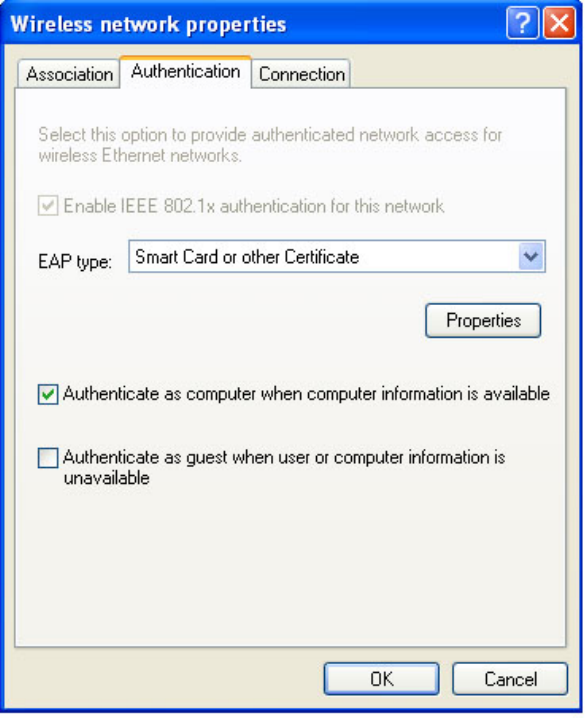
Configuring Advanced Network Security Settings in Windows XP: Intel PRO/Wireless 2915ABG Network Connection User's Guide
9. Click Properties and then select Use a certificate on this computer:
file:///C|/Documents%20and%20Settings/pguillor/Desktop/w2k5/XPAdv.htm (10 of 15) [7/2/2004 12:29:50 PM]
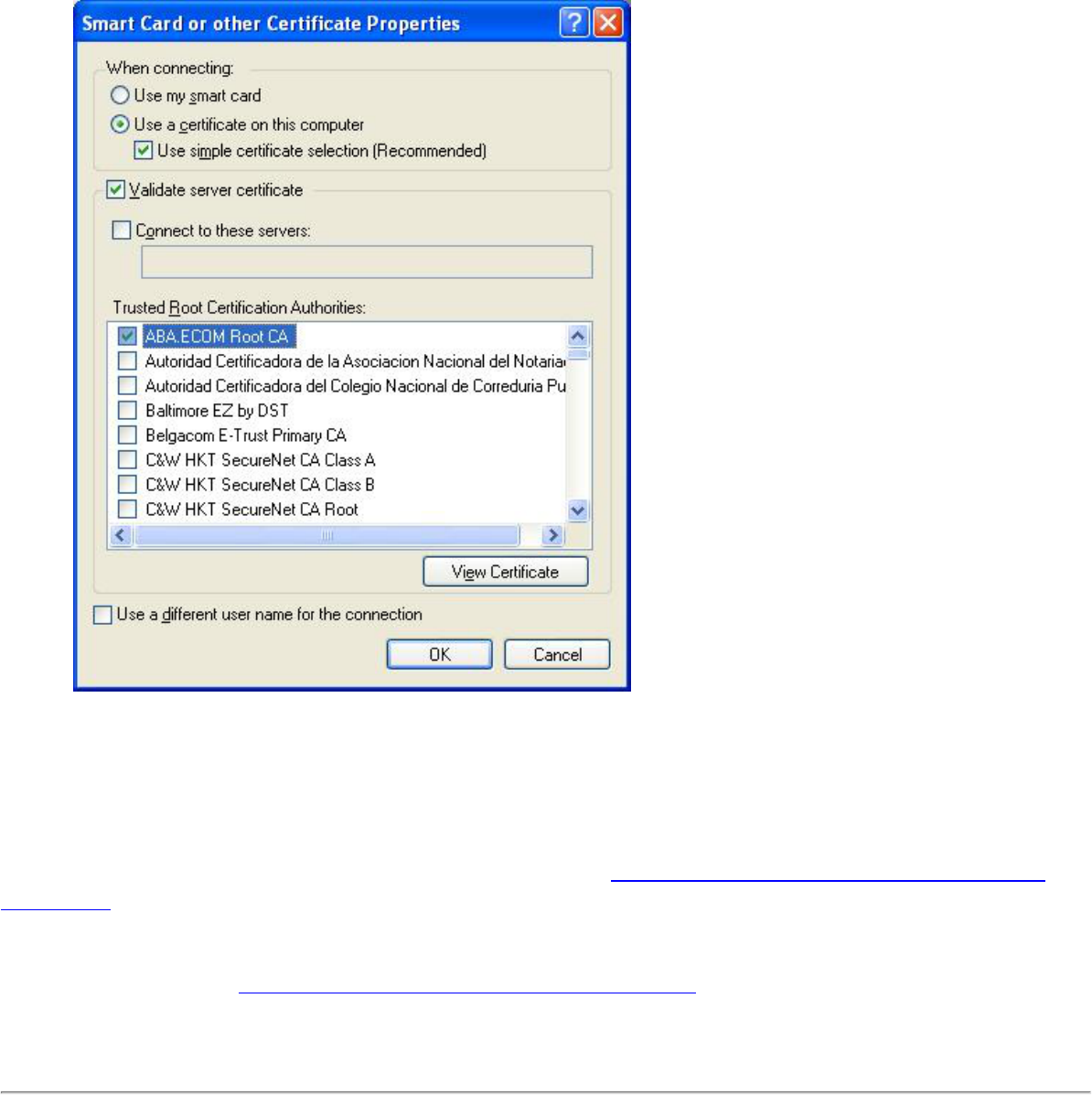
Configuring Advanced Network Security Settings in Windows XP: Intel PRO/Wireless 2915ABG Network Connection User's Guide
10. Select the appropriate certificate(s) from the Trusted Root Certification Authorities. Contact your network
administrator if you cannot find the appropriate certificate or do not know which one to use.
11. To close the Smart Card or other Certificate Properties window, click OK.
12. To close the Wireless network properties box, Click OK.
To verify that your network connection has been made, refer to Viewing the Status of your Wireless Network
Connection.
For information about how to obtain a client certificate for TLS or TTLS authentication, contact your network
administrator or, refer to Setting up a client for TLS/TTLS authentication.
Configuring a WPA Client with AES or TKIP Encryption and PEAP Authentication
Protected Extensible Authentication Protocol (PEAP) is an Internet Engineering Task Force (IETF) draft protocol
sponsored by Microsoft, Cisco, and RSA Security. PEAP is designed to take advantage of server-side Extensible
Authentication Protocol (EAP)-Transport Layer Security (TLS) and to support various authentication methods,
including user passwords, one-time passwords, and Generic Token Cards.
To configure this infrastructure network with PEAP authentication:
file:///C|/Documents%20and%20Settings/pguillor/Desktop/w2k5/XPAdv.htm (11 of 15) [7/2/2004 12:29:50 PM]
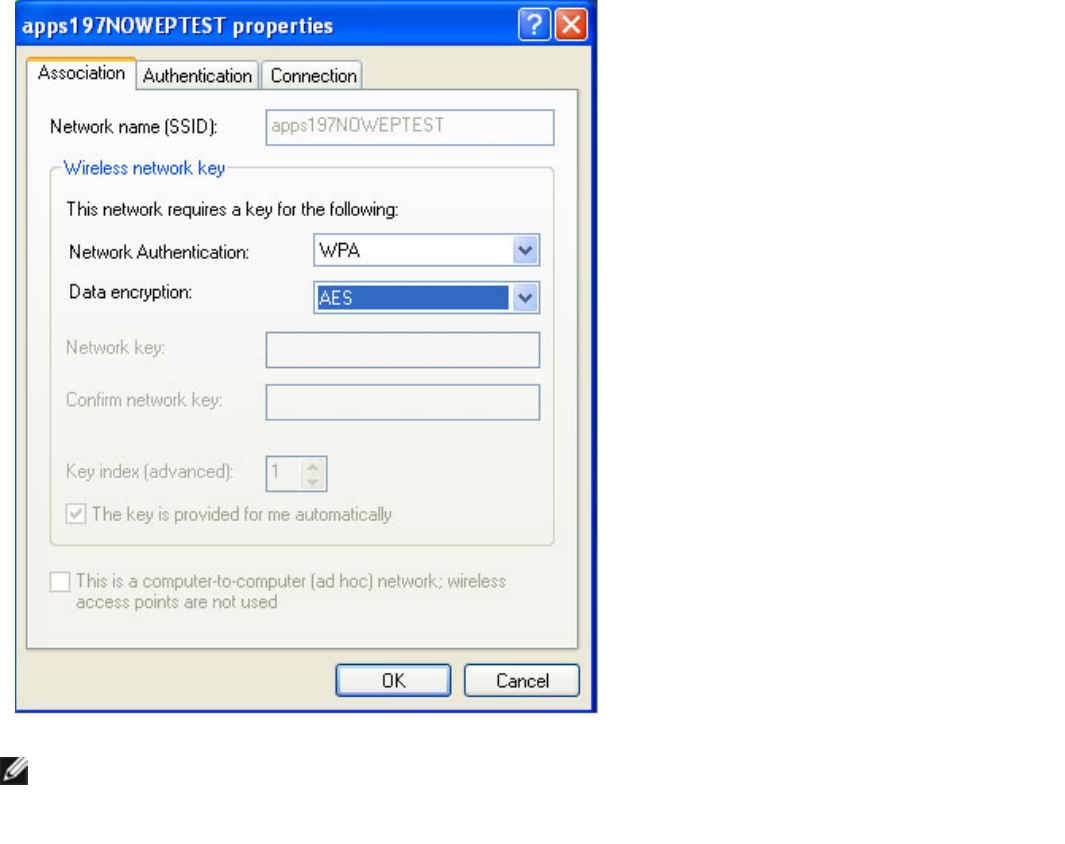
Configuring Advanced Network Security Settings in Windows XP: Intel PRO/Wireless 2915ABG Network Connection User's Guide
1. Click Start àSettings àControl Panel and then double-click Network Connections.
2. Right-click Wireless Network Connection and click Properties.
3. On the Wireless Network Connection Properties window, select the Wireless Networks tab.
4. Verify that the Use Windows to configure my wireless network settings box is selected. If it is not,
select it.
5. From the Preferred Networks list, select the network you want and click Properties. The network properties
window opens.
6. For Network Authentication, select WPA.
7. For Data encryption, select AES or TKIP. These settings are shown in the following illustration.
NOTE:Earlier versions of Microsoft Windows XP did not support encryption modes such as WPA
and WPA-PSK. If you cannot view these options in the dropdown menu, please update
Windows XP to the latest service pack.
8. Click the Authentication tab and for EAP type, select Protected EAP (PEAP).
file:///C|/Documents%20and%20Settings/pguillor/Desktop/w2k5/XPAdv.htm (12 of 15) [7/2/2004 12:29:50 PM]
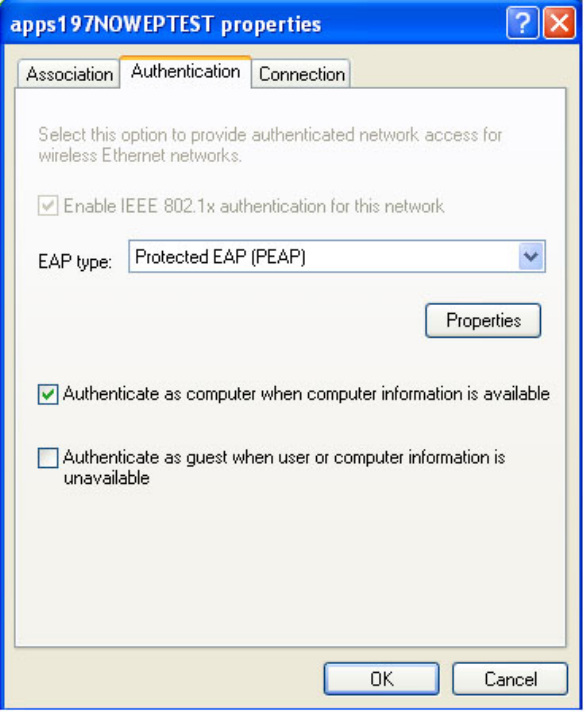
Configuring Advanced Network Security Settings in Windows XP: Intel PRO/Wireless 2915ABG Network Connection User's Guide
9. Click Properties.
10. When the Protected EAP Properties window opens, select Validate server certificate.
11. Select the appropriate Trusted Root Certification Authority from the list.
12. For the authentication method, select Secured password (EAP-MSCHAP v2). These settings are shown
in the following illustration:
file:///C|/Documents%20and%20Settings/pguillor/Desktop/w2k5/XPAdv.htm (13 of 15) [7/2/2004 12:29:50 PM]
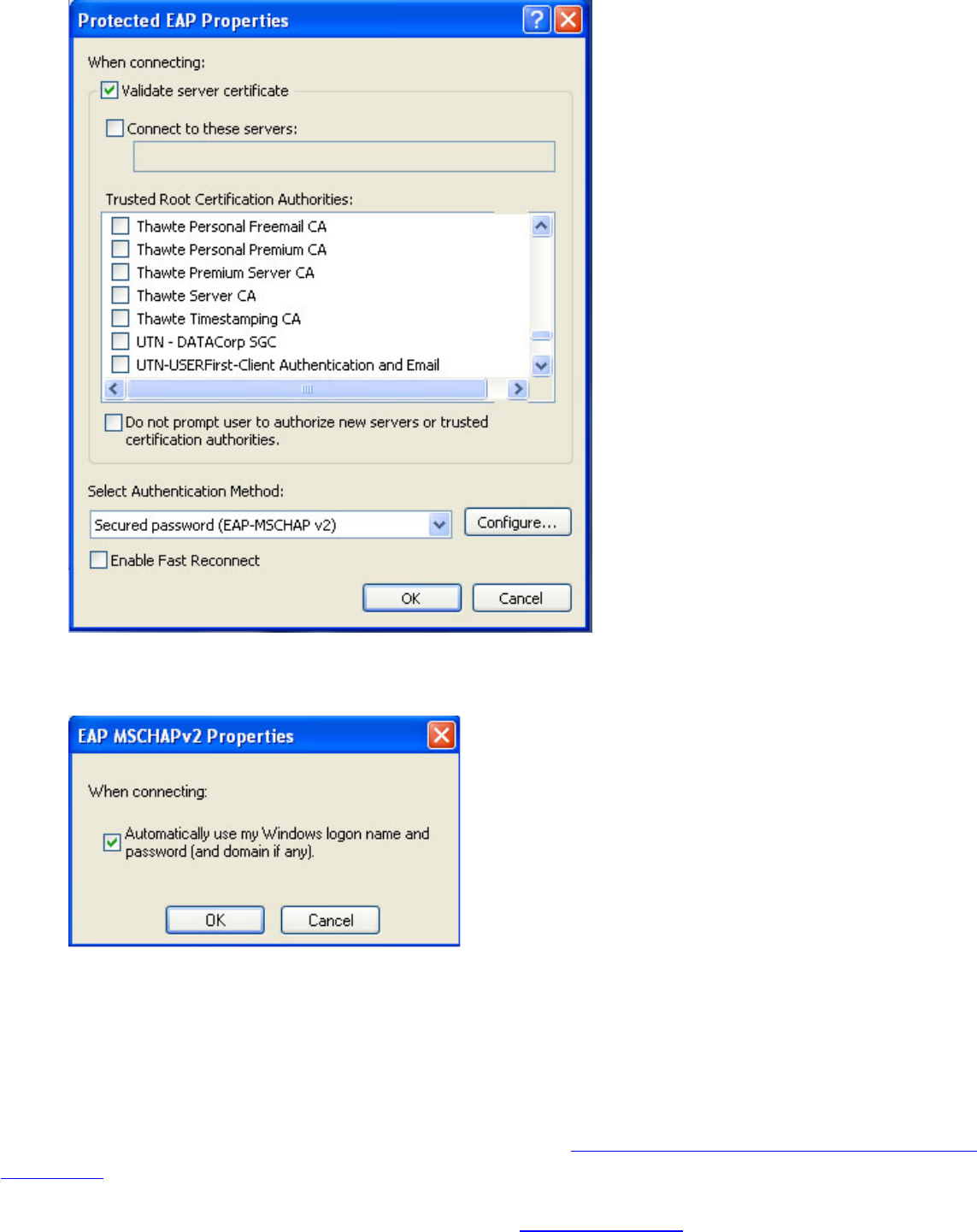
Configuring Advanced Network Security Settings in Windows XP: Intel PRO/Wireless 2915ABG Network Connection User's Guide
13. Click Configure. The following properties window opens.
14. Make sure Automatically use my Windows logon name and password is checked.
15. To return to the previous window, click OK.
16. To save your settings on the Protected AP Properties window, click OK.
17. To save your settings on the Authentication tab, click OK.
18. To close the Wireless Network Connection Properties window, click OK.
To verify that your network connection has been made, refer to Viewing the Status of your Wireless Network
Connection.
For more information about PEAP authentication, refer to Security Overview.
file:///C|/Documents%20and%20Settings/pguillor/Desktop/w2k5/XPAdv.htm (14 of 15) [7/2/2004 12:29:50 PM]

Configuring Advanced Network Security Settings in Windows XP: Intel PRO/Wireless 2915ABG Network Connection User's Guide
Configuring a Client for TLS/TTLS Authentication
The information in this section is intended for enterprise system administrators. For enterprise customers, contact
your system administrator to obtain a client certificate for TLS/TTLS authentication. While obtaining a certificate
for TLS/TTLS authentication, ensure strong private key protection is disabled. This is required for 802.1x
authentication. EAP-TLS and EAP-TTLS authentication require client certificates in the local repository for the
logged in users account and a trusted CA certificate in the root store. Certificates can be obtained from a
corporate certificate authority located on a Windows 2000 Server or using Internet Explorer’s certificate import
wizard.
Obtaining a certificate from Windows 2000 Server
1. Launch Internet Explorer and browse to the Certificate Authority (CA) HTTP Service.
2. Logon to the CA Authority with the username and password of the user account created on the
authentication server. This username and password are not necessarily the same as your Windows
username and password.
3. On the Welcome page, select request a certificate task and submit the form.
4. On the Choose request page, select Advanced request and click Next.
5. On the Advanced Requests page, select Submit a certificate request to this CA using a form and click
next.
6. On the Advanced Requests page, choose the user certificate template. Select Mark keys as exportable
and click next.
7. On the Certificate Issued page, select Install this certificate. If this is the first certificate you have
installed, you will prompted install a trusted CA certificate in the root store. Click Yes as you will need this
certificate for TLS and TTLS authentication.
8. If you certificate was correctly installed, you will see the message: Your new certificate has been
successfully installed.
9. To verify the installation, click à Tools à Internet Options à Content à Certificates. The new
certificate should be installed in the personal folder.
Obtaining a certificate from a file
1. Right click on Internet Explorer icon on desktop, and select Properties.
2. Select the Content tab, click the Certificates button. This displays a list of installed certificates.
3. Select the import button under the list of certificates. This starts the Certification Import Wizard.
4. Select the certificate file and click the password page.
5. Enter the password for the file and ensure strong private key protection option is not selected.
6. On the certification store page, select automatically select certificate store based on the type of
certificate.
7. Proceed to complete the certificate import and click Finish.
Back to Top
Back to Contents
file:///C|/Documents%20and%20Settings/pguillor/Desktop/w2k5/XPAdv.htm (15 of 15) [7/2/2004 12:29:50 PM]

Configuring Advanced Network Security Settings in Windows 2000: Intel PRO/Wireless 2915ABG Network Connection User's Guide
Back to Contents
Configuring Advanced Network Security Settings
in Windows 2000: Intel® PROSet/Wireless
2915ABG Network Connection User's Guide
Using Intel PROSet/Wireless
Ad Hoc Network Overview
Configuring an Ad Hoc Network with WEP Security or without Security
Configuring a WEP Client with WEP and MD5 Authentication
Configuring a WPA2-Enterprise Client with WEP, TKIP or AES-CCMP authentication
Configuring a WPA Client with TKIP Encryption and TTLS or PEAP Authentication
Configuring a CCX Client with CKIP Encryption and LEAP Authentication
System Administrator Tasks (Obtain a Certificate)
Using Intel® PROSet/Wireless
The following sections describe how to set up peer-to-peer networking using Intel®
PROSet/Wireless.
It also provides information about how to configure advanced security settings for your wireless
adapter. This requires information from a system administrator (corporate environment) or
advanced security settings on your access point (for home users). If you are using Windows XP,
refer to Making a Basic Network Connection in Windows XP to configure basic profiles. For
advanced security settings, refer to Configuring Advanced Network Security Settings in Windows
XP. If you are using Windows 2000, click Making a Basic Network Connection in Windows 2000
for basic setup instructions.
NOTE:The software is compatible with the Intel® PRO/Wireless 2915ABG Network
Connection and Intel® PRO/Wireless 2200BG Network Connection.
Ad Hoc Network Overview
In peer-to-peer (ad hoc) mode, you can send information to and receive it from other computers
without using an access point. Each computer in a peer-to-peer network is called a peer. Creating
an ad hoc network requires more than one computer with a wireless adapter. All systems on the
file:///C|/Documents%20and%20Settings/pguillor/Desktop/w2k5/UtilAdv.htm (1 of 25) [7/2/2004 12:29:56 PM]

Configuring Advanced Network Security Settings in Windows 2000: Intel PRO/Wireless 2915ABG Network Connection User's Guide
ad hoc network must be configured identically.
To join an ad hoc network, you must know the ad hoc network key to connect to other computers
in the ad hoc network. If you create the ad hoc network from your computer, other computers can
connect using the network key (SSID) that you created. Once a network connection is established
and after permission rights are given by other computers in the ad hoc network, you can freely
share files. All wireless clients in the ad hoc network must use the same network name (SSID)
and channel number. For a list of allowed 802.11b ad hoc channels, refer to the Adapter Settings
for more information.
Configuring an Ad Hoc Network with WEP Security or without Security
Configuring an Ad Hoc Network with WEP Security or without
Security
The following examples illustrate how to create a new ad hoc profile using the Profile Wizard and
connect to an ad hoc network with or without WEP security. For more information about
authentication and encryption settings, refer to Security Overview.
To configure a new ad hoc profile with no security:
1. Double-click the Intel PROSet Wireless icon in the desktop task tray or click Start
àPrograms àIntel PROSet Wireless àIntel PROSet Wireless.
2. From the Intel PROSet/Wireless main window click Add. The General Settings window
opens:
file:///C|/Documents%20and%20Settings/pguillor/Desktop/w2k5/UtilAdv.htm (2 of 25) [7/2/2004 12:29:56 PM]
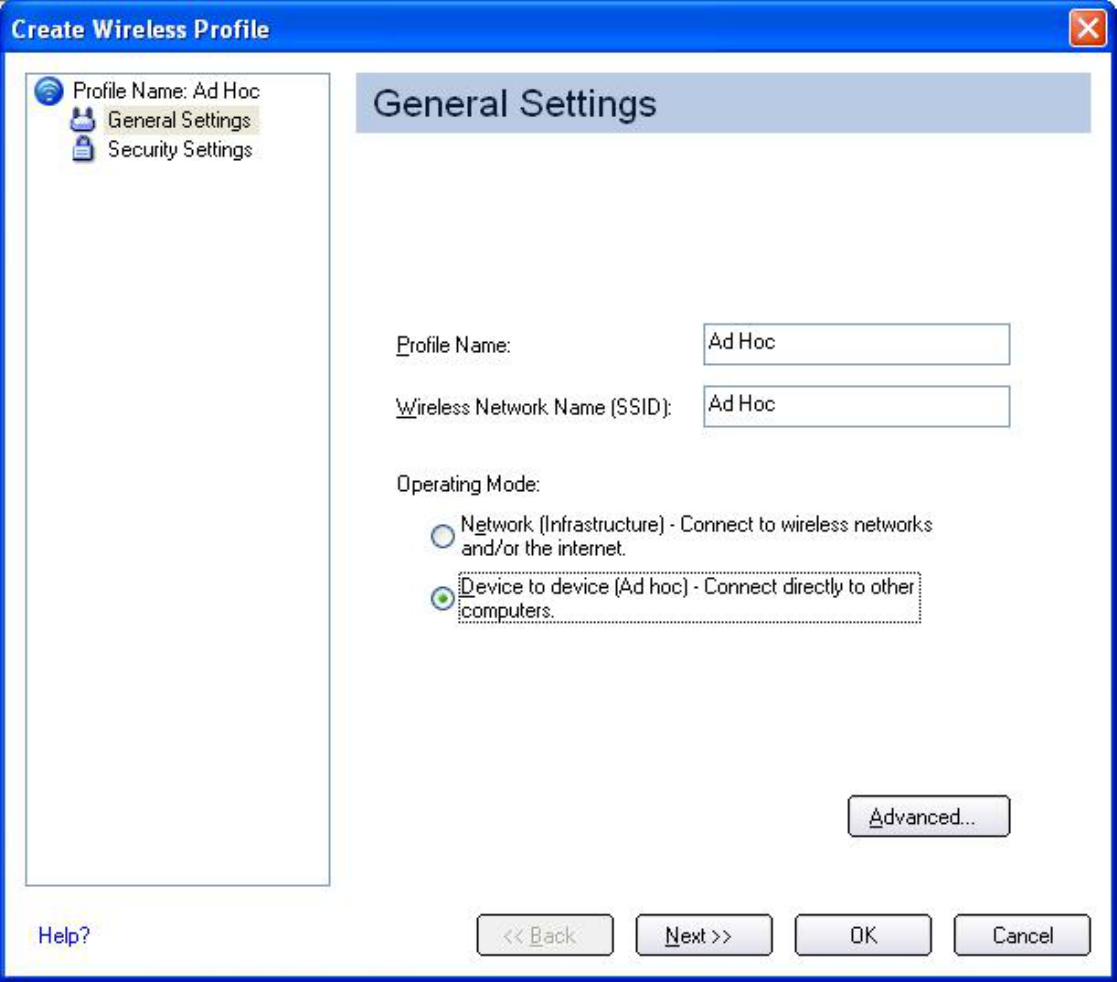
Configuring Advanced Network Security Settings in Windows 2000: Intel PRO/Wireless 2915ABG Network Connection User's Guide
3. Enter the Profile Name and Wireless Network Name (SSID).
4. Select Device to device [Ad hoc].
5. If you want to assign a password for this profile, click Advanced. The Advanced Settings
window opens.
file:///C|/Documents%20and%20Settings/pguillor/Desktop/w2k5/UtilAdv.htm (3 of 25) [7/2/2004 12:29:56 PM]
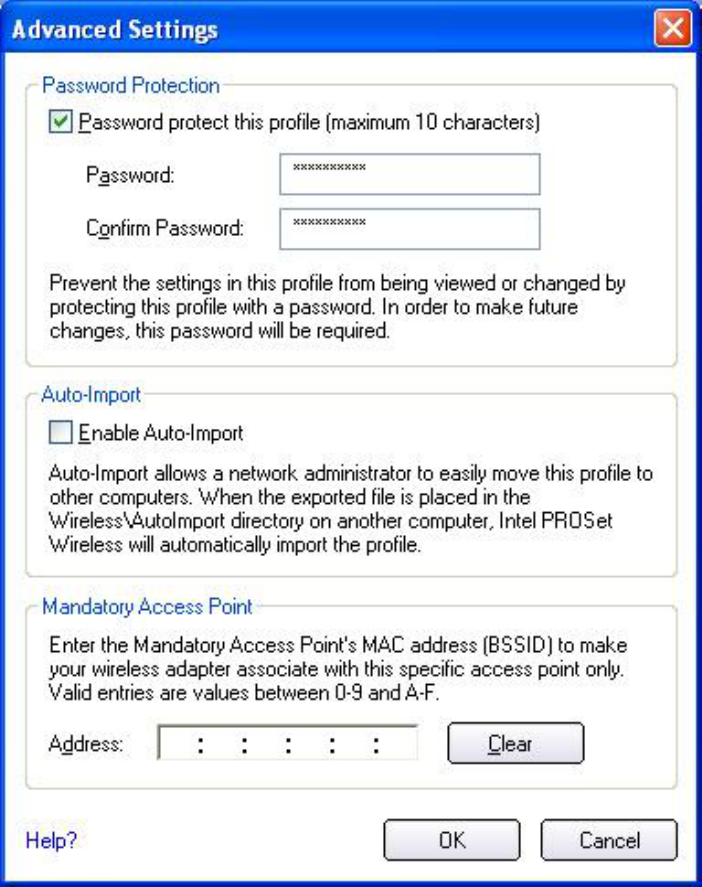
Configuring Advanced Network Security Settings in Windows 2000: Intel PRO/Wireless 2915ABG Network Connection User's Guide
6. Select Password protect this profile (maximum 10 characters).
7. Enter the password, and then enter it again in the Confirm Password box.
8. To save your settings and close the window, click OK. You are returned to the General
Settings window.
9. Click Next. The Security Settings window opens:
file:///C|/Documents%20and%20Settings/pguillor/Desktop/w2k5/UtilAdv.htm (4 of 25) [7/2/2004 12:29:56 PM]
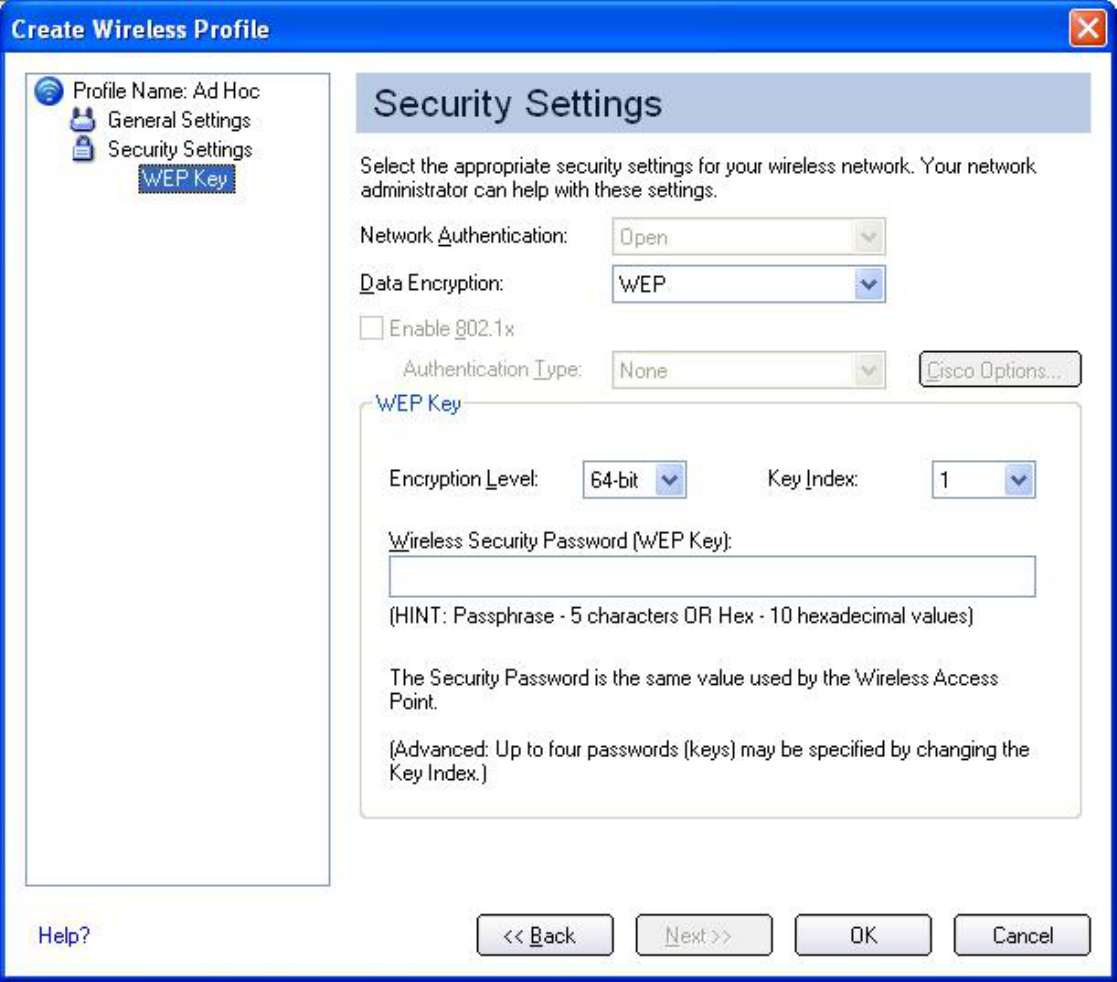
Configuring Advanced Network Security Settings in Windows 2000: Intel PRO/Wireless 2915ABG Network Connection User's Guide
10. In the Network Authentication text box, select Open (default setting).
11. In the Data Encryption text box:
● No security: Select None and proceed to step 15.
● WEP security: Select WEP and continue to step 12.
12. For the Encryption Level, select 64-bit or 128-bit.
13. For Key Index, select a key index number 1, 2, 3, or 4. Key selection must correspond to
the network key on the access point.
14. In the Wireless Security Password (WEP Key) text box, enter the password characters .
Select either of the following:
❍ Use ASCII characters: Click Use ASCII characters to enable. Enter a
file:///C|/Documents%20and%20Settings/pguillor/Desktop/w2k5/UtilAdv.htm (5 of 25) [7/2/2004 12:29:56 PM]

Configuring Advanced Network Security Settings in Windows 2000: Intel PRO/Wireless 2915ABG Network Connection User's Guide
text phrase, five (using 64-bit) or 13 (using 128-bit) ASCII characters (can
use all characters, including space), in the pass phrase field.
❍ Use hex Key: Click Use hex Key to enable. Enter ten (using 64-bit)
alphanumeric characters, 0-9, A-F, or 26 (using 128-bit) alphanumeric
characters (0-9, A-F) in the hex key field.
NOTE:Both the network name and the network key information are case-
sensitive.
15. To save the settings and close the Security Settings window, click OK. The profile is
positioned at the bottom of the Profiles list. Use the up and down arrows to position it
elsewhere on the list.
16. To connect to the wireless network, click Connect.
To verify the status of your wireless connection, refer to Viewing the Status of your Wireless
Connection.
NOTE:Unless other computers in the ad hoc network use a different channel from the default
channel, there is no need to change the default channel. If you want to change the
default channel, select Adapter Settings under the Tools menu, choose the operating
band, and then select a channel.
Security Settings: Open authentication, no encryption
There is no network authentication or data encryption used on this network.
Name Description
Network Authentication Open: No authentication used. Open authentication allows a
wireless device access to the network without 802.11 authentication.
The access point allows any request for authentication. If no
encryption is enabled on the network, any wireless device with the
correct network name (SSID) can associate with the access point
and gain access to the network.
Data Encryption None: No data encryption used.
Enable 802.1x Unchecked.
Security Settings: Open Authentication, WEP Encryption
This network uses no network authentication with WEP data encryption.
Name Description
file:///C|/Documents%20and%20Settings/pguillor/Desktop/w2k5/UtilAdv.htm (6 of 25) [7/2/2004 12:29:56 PM]

Configuring Advanced Network Security Settings in Windows 2000: Intel PRO/Wireless 2915ABG Network Connection User's Guide
Network Authentication Open: No authentication used. Open authentication allows a
wireless device access to the network without 802.11 authentication.
The access point allows any request for authentication. If no
encryption is enabled on the network, any wireless device with the
correct network name (SSID) can associate with the access point
and gain access to the network.
Data Encryption WEP: WEP data encryption can be configured using 64-bit or 128-
bit. When WEP encryption is enabled on an access point, the WEP
key provides a way to verify access to the network. If the wireless
device does not have the correct WEP key, even though
authentication is successful, the device is unable to transmit data
through the access point or decrypt data received from the access
point.
Encryption Level 64-bit or 128-bit: 64-bit or 128-bit encryption.
Key Index 1,2,3,4: Up to four passwords may be specified by changing the Key
Index.
Wireless Security
Password (WEP Key) Type the wireless network Password (WEP Key) in the text box. The
Password is the same value used by the Wireless Access Point or
Router. Contact your wireless network administrator for this
password.
Pass phrase and hex key options are:
Pass phrase (64-bit): Enter 5 aASCII characters (can include any
characters, including spaces).
Hex key (64-bit): Enter 10 hexadecimal characters, 0-9, A-F.
Pass phrase (128-bit): Enter 13 alphanumeric characters (can use
any characters, including spaces).
Hex key (128-bit): Enter 26 alphanumeric hexadecimal characters, 0-
9, A-F.
Configuring a WEP Client with WEP and MD5 Authentication
Note: Before starting, you must obtain a user name and password on the RADIUS server from
your system administrator.
To add WEP and MD5 authentication to a new profile:
1. From Intel PROSet/Wireless main window, under the Profile list click Add. The General
Settings window opens.
2. Enter the profile and network (SSID) name.
file:///C|/Documents%20and%20Settings/pguillor/Desktop/w2k5/UtilAdv.htm (7 of 25) [7/2/2004 12:29:56 PM]
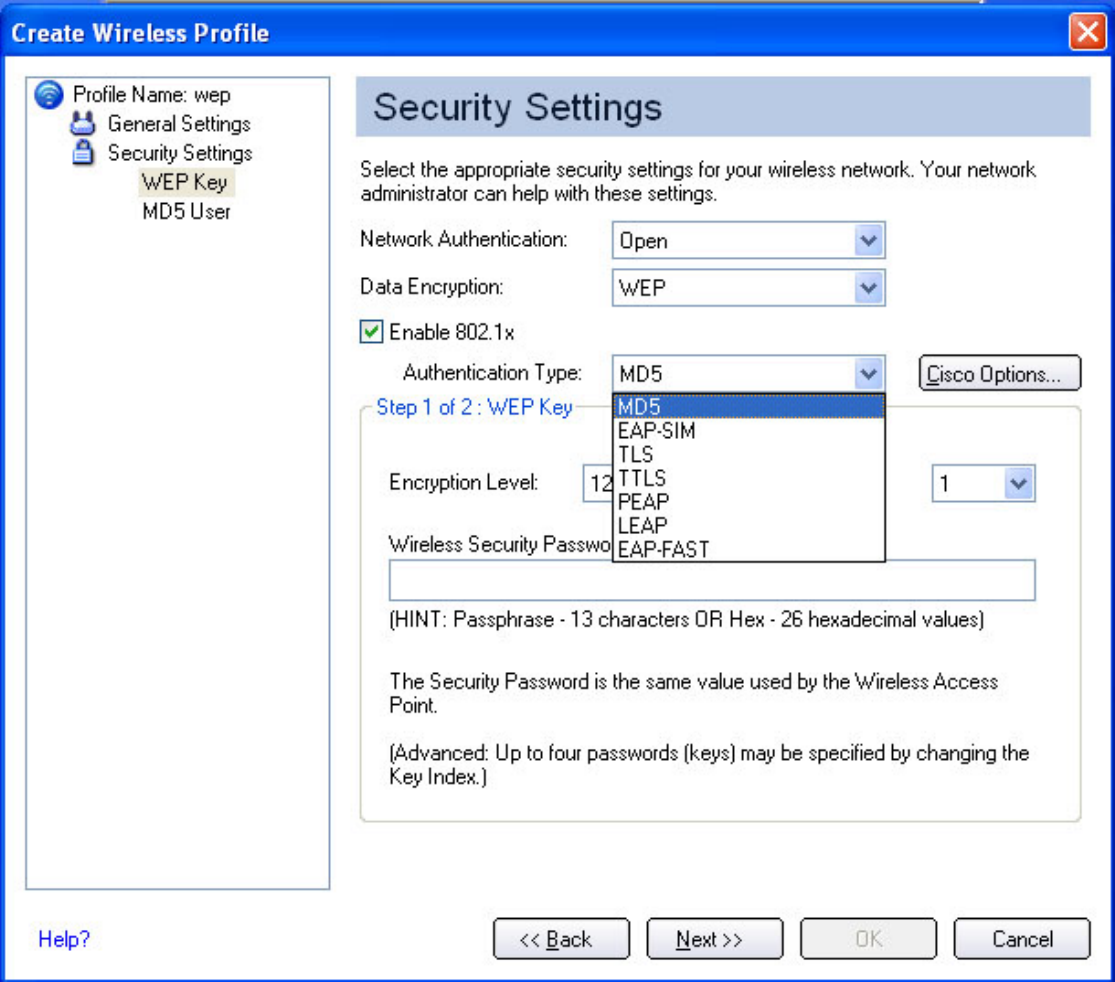
Configuring Advanced Network Security Settings in Windows 2000: Intel PRO/Wireless 2915ABG Network Connection User's Guide
3. For the operating mode, select Infrastructure.
4. If you want to assign a profile password, click Advanced and enter the password
information; then click OK to return to the General Settings window.
5. On the General Settings window, click Next. The Security Settings window opens.
6. For Network Authentication, select Open (recommended).
7. For Data Encryption, select WEP.
8. Click the Enable 802.1x checkbox.
9. For Authentication Type, select MD5 as the 802.1x.
10. For the Encryption Level, select either 64-bit or 128-bit.
11. Select the key index 1, 2, 3 or 4. Key 1 is the default setting.
12. In the Wireless Security Password (WEP Key) text box, enter the required pass phrase or
file:///C|/Documents%20and%20Settings/pguillor/Desktop/w2k5/UtilAdv.htm (8 of 25) [7/2/2004 12:29:56 PM]
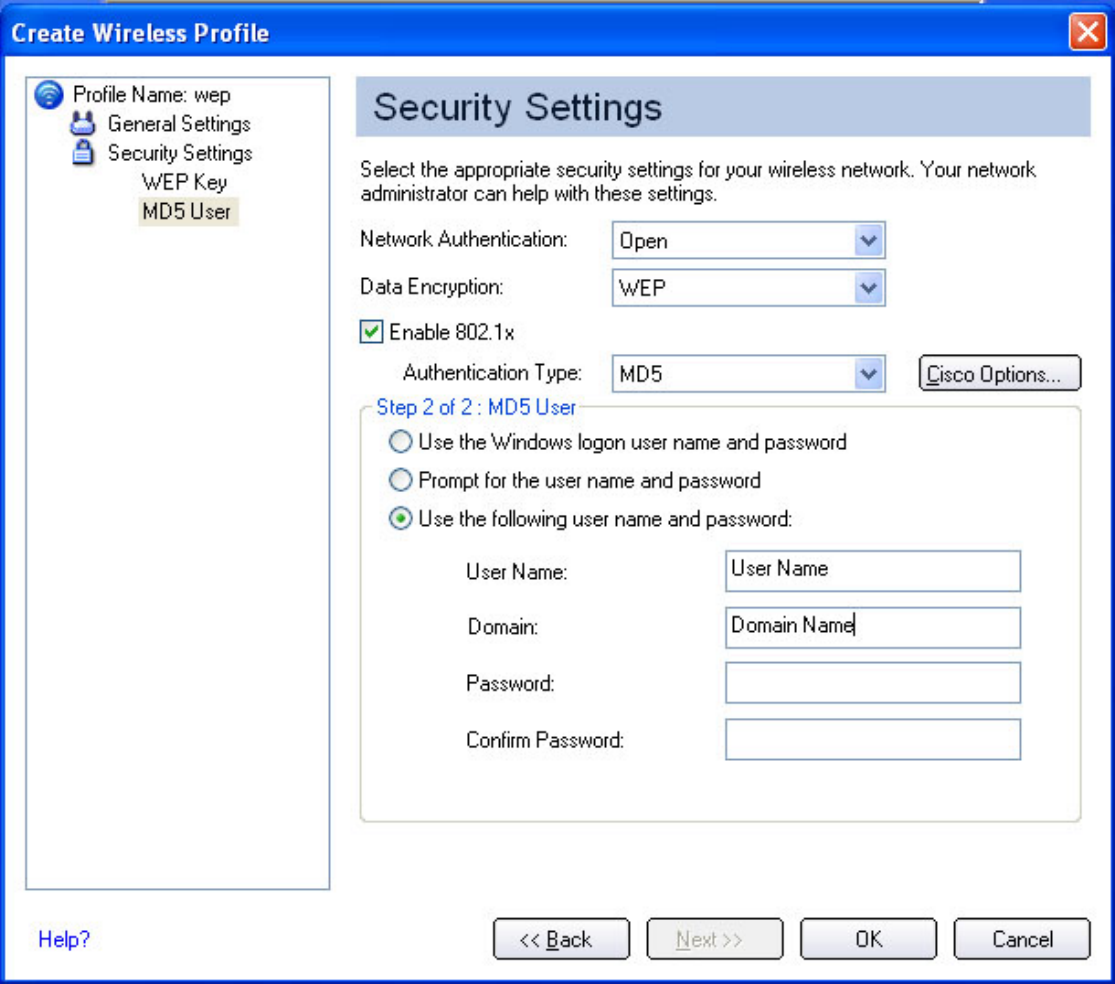
Configuring Advanced Network Security Settings in Windows 2000: Intel PRO/Wireless 2915ABG Network Connection User's Guide
hex key.
13. In the left side panel, click MD5 User to display the MD5 setting. The following window
opens:
14. Select one of the following options:
● Use the Windows logon user name and password: Select this option to use your
Windows log on user name for a Windows session. Note: this option is only available if you
have the single sign On Pre-Login Connection component installed.
● Prompt for the user name and password: Select this option to prompt for user
credentials when you log on to a Windows session.
● Use the following user name and password:
file:///C|/Documents%20and%20Settings/pguillor/Desktop/w2k5/UtilAdv.htm (9 of 25) [7/2/2004 12:29:56 PM]

Configuring Advanced Network Security Settings in Windows 2000: Intel PRO/Wireless 2915ABG Network Connection User's Guide
❍ User Name: This user name must match the user name that is set in the
authentication server. Note: The user name and password do not have to be
the same as the name of your current Windows user login.
❍ Domain: Optionally enter the domain name.
❍ Password: This password must match the password that is set in the
authentication server. The entered password characters display as asterisks.
Note: The user name and password do not have to be the same as the
password of your current Windows user login.
❍ Confirm Password: Re-enter the user password.
15. To save the settings and close the Security Settings page, click OK.
Configuring a WPA/WPA2-Enterprise Client with WEP, TKIP, or
AES-CCMP Authentication
Note: (1) Before starting, you must obtain a user name and password on the RADIUS server
from your system administrator. (2) For personal/home networks use Wi-Fi Protected Access
Personal (WPA/WPA2 Personal) mode. WPA/WPA2-Enterprise requires an authentication server.
To add WPA/WPA-2 Enterprise authentication to a new profile:
1. Obtain and install a client certificate. For more information refer to Setting up the Client for
TLS authentication or consult your system administrator.
2. From Intel PROSet/Wireless main window, click Add from the Profiles list. The General
Settings window opens.
3. Enter the profile and network (SSID) name.
4. Select Infrastructure for the operating mode.
5. To assign a profile password, click Advanced and enter the password information; then
click OK to return to the General Settings window.
6. On the General Settings window, click Next. The Security Settings window opens.
7. For Network Authentication, select WPA-Enterprise or WPA2-Enterprise.
8. For Data Encryption, select WEP, TKIP, or AES-CCMP.
9. Click the Enable 802.1x checkbox.
10. For the 802.1x Authentication Type, select TLS. The Security settings are shown in the
following illustration:
file:///C|/Documents%20and%20Settings/pguillor/Desktop/w2k5/UtilAdv.htm (10 of 25) [7/2/2004 12:29:56 PM]
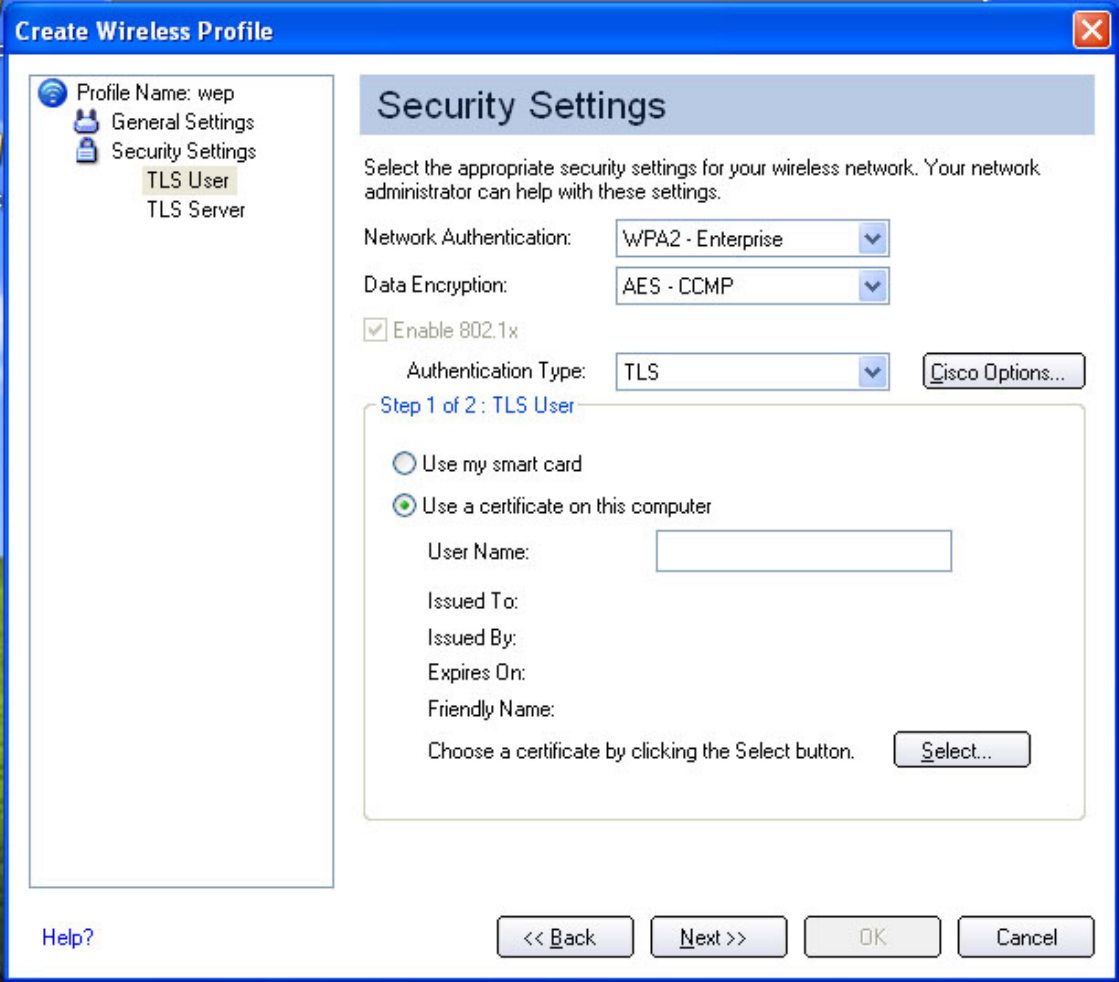
Configuring Advanced Network Security Settings in Windows 2000: Intel PRO/Wireless 2915ABG Network Connection User's Guide
11. Under TLS user, select either:
● Use my smart card. Insert your Smart Card when you log on to your computer using
this profile.
● Use a certificate on this computer: Your user name should be displayed in the
User Name text box. Click the Select button to open a list of installed certificates.
Select a certificate from the list. This option selects a client certificate from the
Personal certificate store of the Windows logged-in user. This certificate will be used
for client authentication. Click the Select button to open a list of installed certificates.
Click OK to close the window.
12. In the left side panel to display the TLS setting, click TLS Server. Choose a certificate from
the list or use the default certificate 'Any Trusted CA' and select the required
Server/Certificate Name.
file:///C|/Documents%20and%20Settings/pguillor/Desktop/w2k5/UtilAdv.htm (11 of 25) [7/2/2004 12:29:56 PM]

Configuring Advanced Network Security Settings in Windows 2000: Intel PRO/Wireless 2915ABG Network Connection User's Guide
13. Click OK to save the settings and close the Security Settings page.
14. Refer to Viewing the Status of your Wireless Connection to verify if your network connection
has been made.
NOTE:Refer to your access point/router settings (for home users) or, contact your system
administrator for the data encryption type and network key (corporate users.)
Configuring a WPA/WPA2-Enterprise Client with TKIP Encryption
and TTLS or PEAP Authentication
Using TTLS authentication: These settings define the protocol and the credentials used to
authenticate a user. In TTLS, the client uses EAP-TLS to validate the server and create a TLS-
encrypted channel between the client and server. The client can use another authentication
protocol, typically password-based protocols, such as MD5 Challenge, over this encrypted
channel to enable server validation. The challenge and response packets are sent over a non-
exposed TLS encrypted channel.
Using PEAP authentication: PEAP settings are required for the authentication of the client to
the authentication server. In PEAP, the client uses EAP-TLS to validate the server and create a
TLS-encrypted channel between client and server. The client can use another EAP mechanism,
such as Microsoft Challenge Authentication Protocol (MSCHAP) Version 2, over this encrypted
channel to enable server validation. The challenge and response packets are sent over a non-
exposed TLS encrypted channel.
Note: Before starting, you must obtain a user name and password on the RADIUS server from
your system administrator.
To set up a new profile:
1. Obtain and install a client certificate, refer to Setting up the Client for TLS authentication or
consult your system administrator.
2. From Intel PROSet/Wireless main window, click Add under the Profiles List. The General
Settings window opens.
3. Enter the profile and network (SSID) name.
4. For the operating mode, select Infrastructure.
5. To assign a profile password, click Advanced and enter the password information; then
click OK to return to the General Settings window.
6. On the General Settings window, click Next.
7. For Network Authentication, select WPA2-Enterprise.
8. For Data Encryption, select TKIP.
file:///C|/Documents%20and%20Settings/pguillor/Desktop/w2k5/UtilAdv.htm (12 of 25) [7/2/2004 12:29:56 PM]
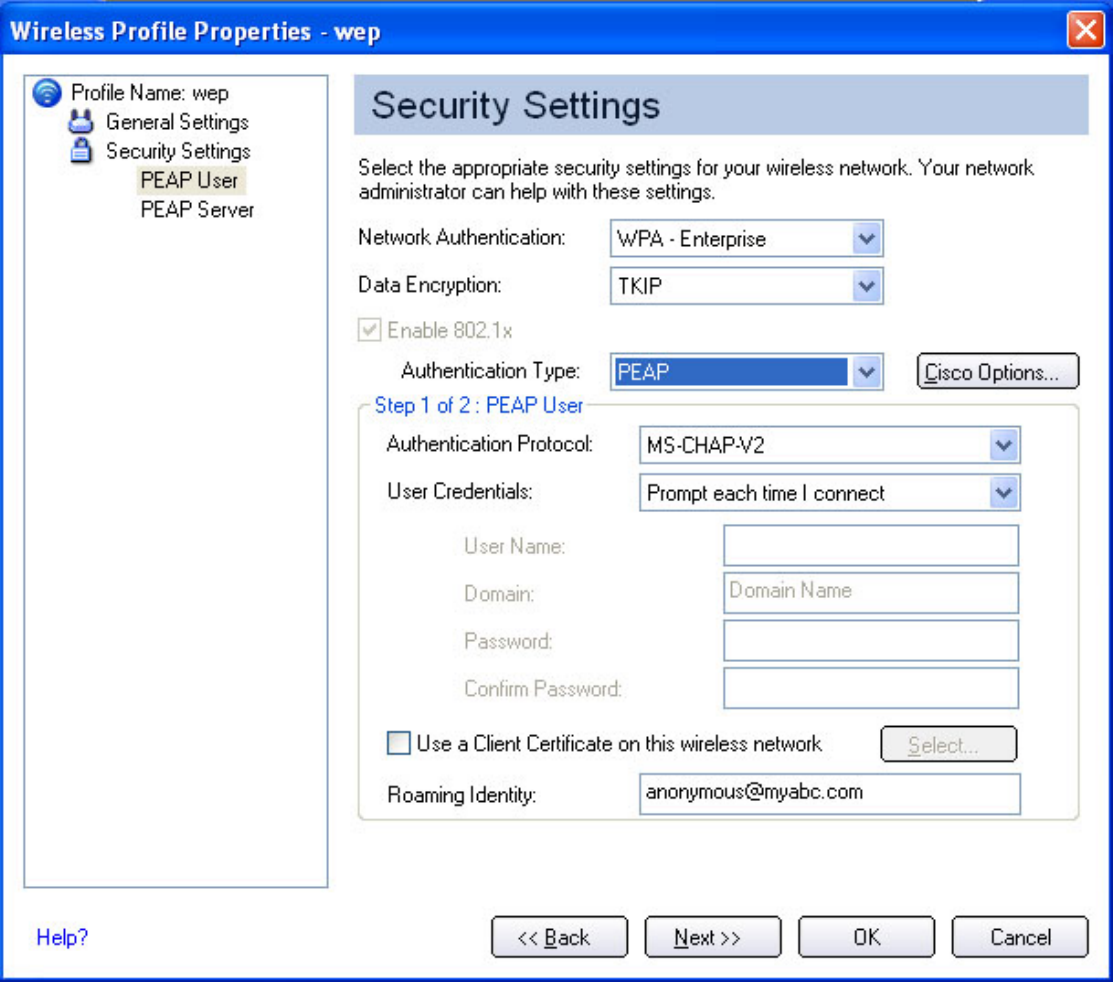
Configuring Advanced Network Security Settings in Windows 2000: Intel PRO/Wireless 2915ABG Network Connection User's Guide
9. Click the Enable 802.1x checkbox.
10. For the 802.1x Authentication Type, select PEAP. The Security settings are shown in the
following illustration:
11. For authentication Protocol:
● Using MS-CHAP-V2 and GTC protocols:
❍ Use the Windows logon user name and password: If this feature is selected the
user’s credentials are retrieved from the user’s Windows Logon process. Note: This
option is only available if you have the Single Sign On Pre-Login Connection
component installed.
file:///C|/Documents%20and%20Settings/pguillor/Desktop/w2k5/UtilAdv.htm (13 of 25) [7/2/2004 12:29:56 PM]

Configuring Advanced Network Security Settings in Windows 2000: Intel PRO/Wireless 2915ABG Network Connection User's Guide
❍ Prompt for the user name and password: Selecting this feature will show a window
which will prompt for user name and password before you connect to the wireless
network. The user name and password must be first set in the authentication server
by the IT administrator.
● For GTC protocol: You may select whether you want to use a static
password or a one-time password.
❍ Use the following user name and password: The user name and password are
securely (encrypted) saved in the profile.
● User Name: This user name must match the user name that is set in the
authentication server.
● Domain: Optionally enter the domain name.
● Password: This password must match the password that is set in the
authentication server. The entered password characters display as
asterisks.
● Confirm Password: Re-enter the user password.
❍ Use a client certificate: You may optionally select a client certificate from the
Personal certificate store of the Windows logged-in user; this certificate is used for
client authentication.
❍ Roaming Identity: When using 802.1x MS RADIUS as an authentication server, the
authentication server authenticates the device by using the "Roaming Identity"
username from PROSet and ignores the "Authentication Protocol MS-CHAP-V2" User
Name. This feature is the 802.1x identity supplied to the authenticator. Microsoft IAS
RADIUS accepts only a valid username (dotNet user) for EAP clients. Enter a valid
username when using 802.1x MS RADIUS. For all other servers, this is an optional
field, therefore, it is recommended that this field not contain a true identity, but instead
the desired realm (e.g., anonymous@myrealm).
● Using TLS protocol:
❍ Use my smart card or certificate: Select smart card if the certificate resides on a
smart card. Select certificate if the certificate resides on the computer.
❍ User Name: This user name must match the user name that is set in the
authentication server by the IT administrator prior to client's authentication. The user
name is case-sensitive. This name specifies the identity supplied to the authenticator
by the authentication protocol operating over the TLS tunnel. This user’s identity is
securely transmitted to the server only after an encrypted channel has been verified
and established.
❍ Select button: Select a client certificate from the Personal certificate store of the
Windows logged-in user; this certificate will be used for client authentication.
file:///C|/Documents%20and%20Settings/pguillor/Desktop/w2k5/UtilAdv.htm (14 of 25) [7/2/2004 12:29:56 PM]

Configuring Advanced Network Security Settings in Windows 2000: Intel PRO/Wireless 2915ABG Network Connection User's Guide
12. For User Credentials, select Use Windows logon, Prompt each time I connect, or Use
the following. If you select Use the following, you need to enter user name, domain, and
password information.
13. To select a Client Certificate, click Use a Client Certificate on this wireless network, and
then click Select.
14. When the Select Certificate window opens, select the certificate you want:
PEAP or TTLS: Server/Certificate Authority
Certificate Issuer The server certificate received during the PEAP or TTLS message
exchange must have been issued by this certificate authority.
Trusted intermediate certificate authorities and root authorities
whose certificates exist in the system store will be available for
selection in the drop-down list box. If Any Trusted CA is selected,
any CA in the list will be acceptable.
● Allow intermediate certificates: The server certificate
received during negotiation may have been issued directly
by the certificate authority indicated in the “Certificate issuer”
field, or additionally by one of its intermediate certificate
authorities. Check this box to allow a number of unspecified
certificates to be in the server certificate chain between the
server certificate and the specified CA. If unchecked, then
the specified CA must have directly issued the server
certificate.
Server/Certificate Name Check this option if you want to specify your server/certificate
name.
The server name, or a domain to which the server belongs,
depending on which of the two options below has been selected.
● Server name must match exactly: When selected, the
server name entered must match exactly the server name
found on the certificate. The server name should include the
complete domain name (e.g., Servername.Domain name) in
this field.
● Domain name must end in specified name: When
selected, the server name field identifies a domain, and the
certificate must have a server name belonging to this
domain or to one of its sub-domains (e.g., zeelans.com,
where the server is blueberry.zeelans.com)
Note: These parameters should be obtained from the system
file:///C|/Documents%20and%20Settings/pguillor/Desktop/w2k5/UtilAdv.htm (15 of 25) [7/2/2004 12:29:56 PM]

Configuring Advanced Network Security Settings in Windows 2000: Intel PRO/Wireless 2915ABG Network Connection User's Guide
administrator.
15. To save your settings, click OK.
Configuring a CCX Client with CKIP Encryption and LEAP
Authentication
Configuring LEAP using Intel PROSet/Wireless Assistant
An Intel PROSet Wireless CCX (v2.0) profile must be configured to connect to a specific ESS or
Wireless LAN network. The profiles settings include LEAP and CKIP with automatic Rogue AP
detection.
To configure a profile for CCX security settings:
1. On the Intel PROSet/Wireless main window, click Add. The General Settings window
opens.
2. Enter the profile and network (SSID) name.
3. For the operating mode, select Network [Infrastructure].
4. Click Next. The Security Settings window opens.
5. For Network Authentication, select Open.
6. For Data Encryption, select CKIP.
7. Click Enable 802.1x.
8. For Authentication Type, select LEAP.
9. Click CCX Options. The Cisco Compatible Extensions Options window opens.
file:///C|/Documents%20and%20Settings/pguillor/Desktop/w2k5/UtilAdv.htm (16 of 25) [7/2/2004 12:29:56 PM]
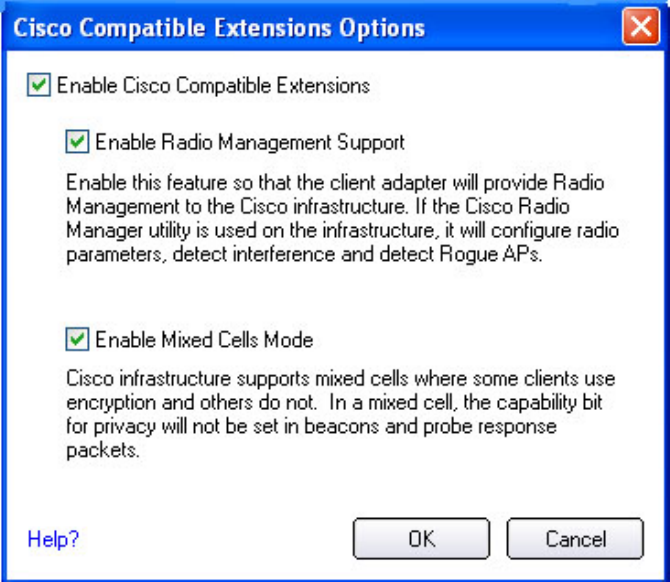
Configuring Advanced Network Security Settings in Windows 2000: Intel PRO/Wireless 2915ABG Network Connection User's Guide
10. Select the following options:
● Click the Cisco Compatible Extensions check box to enable CCX security.
● Click Enable Radio Management Support: Select this option for Cisco access point
compatibility.
● Click Mixed Cells: Use this option to avoid collision in the 11b/11g mixed environment.
11. Click OK.
Under LEAP User, your user name is displayed in the User Name text box. The domain
name is also displayed in the Domain text box (default setting).
12. In the Password text box, enter your Windows login password.
13. In the Confirm Password text box, re-enter the password. This password is your user
account created on the authentication server. The user name and password do not have to
be the same as name and password of your current Windows user login. NOTE: You can
also select Prompt for the user name and password, which will allow you to enter you
user name when you connect to the network.
14. Click Allow for fast roaming (CCKM) to enable this feature. The Security settings are
shown in the following illustration:
file:///C|/Documents%20and%20Settings/pguillor/Desktop/w2k5/UtilAdv.htm (17 of 25) [7/2/2004 12:29:56 PM]
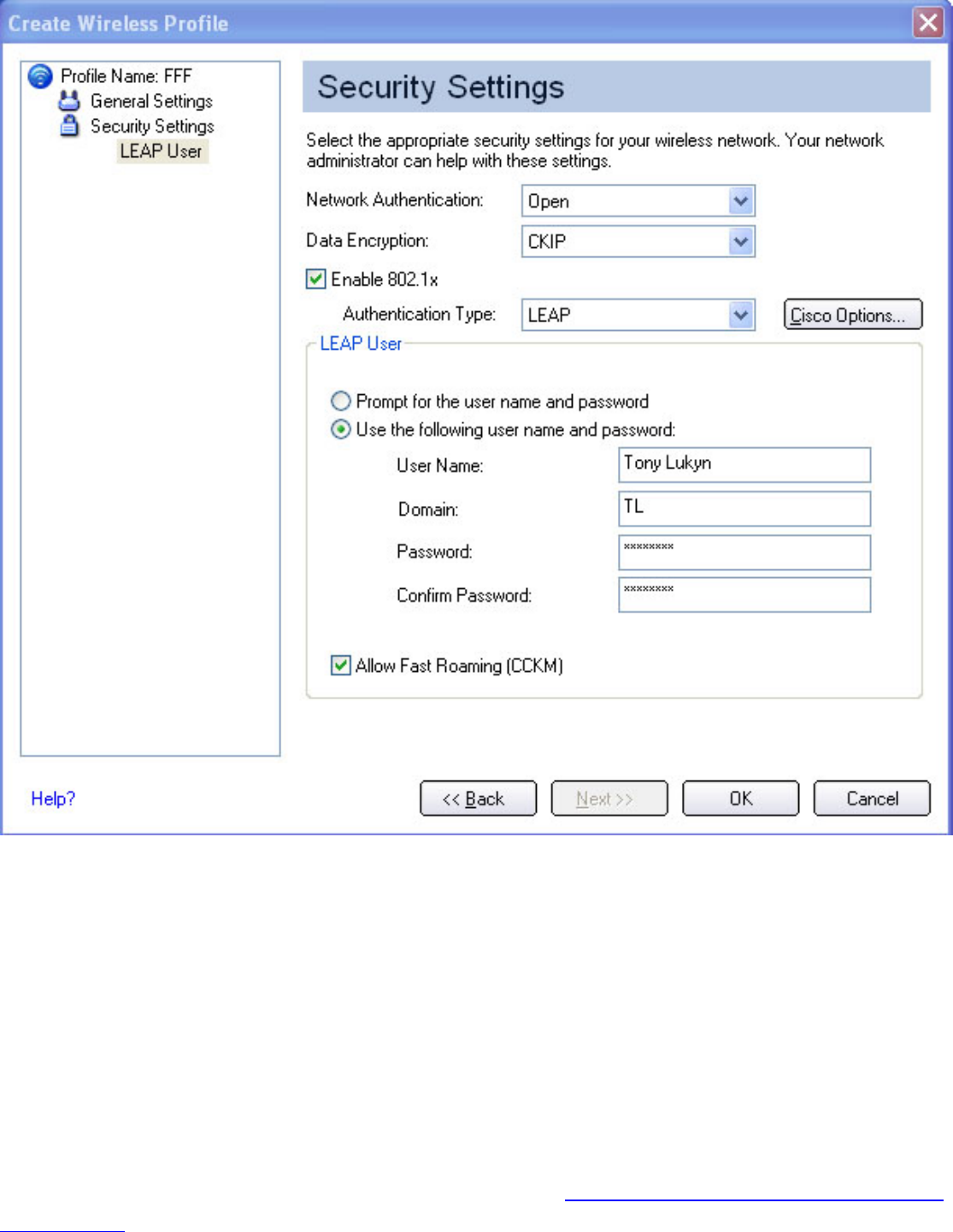
Configuring Advanced Network Security Settings in Windows 2000: Intel PRO/Wireless 2915ABG Network Connection User's Guide
15. To save the settings and close the Security Settings page, click OK. The Intel
PROSet/Wireless main window opens to display the profile at the bottom of the Profiles list.
Use the profile list arrows to position the profile in the list. If the profile is positioned at the
top of the list, it will automatically be connected to the network the next time the wireless
network is detected.
16. To connect to the appropriate CCX enabled wireless network access point using the CCX
Profile, select the profile and click Connect. The connection icon indicates that you are
connected to the network. The network name, speed, and signal quality display the current
connection status.
17. To display information about the current network connection, click Details.
For more information about connection status, refer to Viewing the Status of Your Wireless
Connection.
file:///C|/Documents%20and%20Settings/pguillor/Desktop/w2k5/UtilAdv.htm (18 of 25) [7/2/2004 12:29:56 PM]

Configuring Advanced Network Security Settings in Windows 2000: Intel PRO/Wireless 2915ABG Network Connection User's Guide
Security Settings for LEAP
Name Description
Use the Windows logon
user name and password Selecting this feature, the user credentials are retrieved from the
Windows Logon process. Note: This option is only available if you
have the Single sign On Pre-Login Connection component installed.
Prompt for the user name
and password Selecting this feature, prompts for user name and password before
you connect to the wireless network. The user name and password
must be first set in the authentication server by the IT administrator.
Use the following user
name and password: The user name and password must be first set in the authentication
server by the IT administrator.
User Name: This user name must match the user name that is set in
the authentication server.
Domain: Optionally enter the name of the domain.
Password: This password must match the password that is set in
the authentication server. The entered password characters display
as asterisks.
Confirm Password: Re-enter the user password.
Allow Fast Roaming
(CCKM) Click Allow Fast Roaming (Cisco Centralized Key Management
(CCKM)) to enable the client wireless adapter for fast secure
roaming.
When a wireless LAN is configured for fast reconnection, a LEAP
enabled client device can roam from one access point to another
without involving the main server. Using Cisco Centralized Key
Management (CCKM), an access point configured to provide
Wireless Domain Services (WDS) takes the place of the RADIUS
server and authenticates the client without perceptible delay in voice
or other time-sensitive applications.
CCX Access Point and Client Configurations
The access point provides settings to select different authentication types depending on the
wireless network environment. The client sends an Authentication algorithm field during the
802.11 authentication handshake that takes place between the client and the AP during
connection establishment. The Authentication algorithm values recognized by a CCX enabled AP
is different for the different authentication types. For instance “Network-EAP” which denotes LEAP
has a value of 0x80 while “Open” which is the 802.11 specified Open authentication and
file:///C|/Documents%20and%20Settings/pguillor/Desktop/w2k5/UtilAdv.htm (19 of 25) [7/2/2004 12:29:56 PM]
Configuring Advanced Network Security Settings in Windows 2000: Intel PRO/Wireless 2915ABG Network Connection User's Guide
“Required EAP” which requires an EAP handshake exchange have values of 0x0.
Network-EAP only
AP: For CCX enabled networks using LEAP authentication only the authentication type is set with
“Network-EAP” checkbox selected, and “Open” and “Required EAP” boxes unchecked. The AP is
then configured to allow LEAP clients ONLY to authenticate and connect. In this case, the AP
expects the 802.11 authentication algorithm to be set to 0x80 (LEAP), and rejects clients that
attempt authentication with an Authentication algorithm value 0x0.
Client: In this case the client needs to send out an authentication algorithm value of 0x80 else the
802.11 authentication handshake would fail. During boot, when the Wireless LAN driver is already
loaded, but the Intel PROSet Wireless supplicant is still unloaded, the client sends 802.11
authentication with an Authentication algorithm value of 0x0. Once the Intel PROSet Wireless
supplicant loads, and engages the LEAP profile, it sends 802.11 authentication with an
Authentication algorithm value of 0x80. However, the supplicant sends out 0x80 only if the Rogue
AP box is checked.
Network-EAP, Open and Required EAP
AP: If Network-EAP, Open and Required EAP boxes are checked then it would accept both types
of 802.11 authentication algorithm values 0x0 and 0x80. However, once the client is associated
and authenticated the AP expects an EAP handshake to take place. For any reason if the EAP
handshake does not take place quickly, the AP would not respond to the client for about 60
seconds.
Client: Here the client could send out an authentication algorithm value of 0x80 or 0x0. Both
values are acceptable and the 802.11 authentication handshake would succeed. During boot,
when the Wireless LAN driver is already loaded and the client sends 802.11 authentication
with an Authentication algorithm value of 0x0. This is sufficient to get authenticated but the
corresponding EAP or LEAP credentials need to be communicated to the AP to establish a
connection.
Open and Required EAP only
AP: In the case where the AP is configured with Network-EAP unchecked, but Open and
Required EAP checked, the AP will reject any client attempting to 802.11 authenticate using an
authentication algorithm value of 0x80. The AP would accept any client using an authentication
algorithm value of 0x0, and expects EAP handshake to commence soon after. In this case, the
client uses MD5, TLS, LEAP or any other appropriate EAP method suitable for the specific
network configuration.
Client: The client in this case is required to send out an authentication algorithm value of 0x0. As
mentioned before the sequence involves a repeat of the initial 802.11 authentication handshake.
file:///C|/Documents%20and%20Settings/pguillor/Desktop/w2k5/UtilAdv.htm (20 of 25) [7/2/2004 12:29:56 PM]

Configuring Advanced Network Security Settings in Windows 2000: Intel PRO/Wireless 2915ABG Network Connection User's Guide
First, the Wireless LAN driver initiates authentication with a value of 0x0 and later the supplicant
would repeat the process. However, the authentication algorithm value used by the supplicant
depends on the status of the Rogue AP checkbox. When the Rogue AP box is unchecked, the
client sends an 802.11 authentication with Authentication algorithm value of 0x0 even after the
supplicant loads and engages the LEAP profile.
Some non-Intel clients, for example, when set to LEAP, cannot authenticate in this case.
However, the Intel Wireless LAN client can authenticate, if the Rogue AP is unchecked.
Rogue AP Checkbox configuration
When the checkbox is checked it ensures that the client implements the Rogue AP feature as
required by CCX. The client makes note of APs that it failed to authenticate with and sends this
information to the AP that allows it to authenticate and connect. Also, the supplicant sets the
Authentication algorithm type to 0x80 when the Rogue AP box is checked. There may be some
network configurations implementing and Open and Required EAP only as described above. For
this setup to work, the client must use an Authentication Algorithm value of 0x0, as opposed to
the need to use 0x80 for Network-EAP only described above. Therefore, the Rogue AP checkbox
also enables the client to support Network-EAP only and Open and Required EAP only.
Note: Please refer to Cisco Client extensions version 2.0 document available at www.cisco.com
for more details.
System Administrator Tasks (Obtain a Certificate)
Important: The following information is intended for system administrators.
How to Obtain a Client Certificate
If you do not have any certificates for EAP-TLS, or EAP-TTLS you must get a client certificate to
allow authentication. For Enterprise customers, typically you need to consult your system network
administrator for instructions about how to obtain a certificate on your network. Certificates can be
managed from Internet Settings, accessed from either Internet Explorer or the Windows Control
Panel. Use the “Content” page of “Internet Settings.”
Windows XP and 2000 - When obtaining a client certificate, do not enable strong private key
protection. If you enable strong private key protection for a certificate, you will need to enter an
access password for the certificate each time this certificate is used. You must disable strong
private key protection for the certificate if you are configuring the service for TLS/TTLS
authentication. Otherwise the 802.1x service will fail authentication because there is no logged on
file:///C|/Documents%20and%20Settings/pguillor/Desktop/w2k5/UtilAdv.htm (21 of 25) [7/2/2004 12:29:56 PM]
Configuring Advanced Network Security Settings in Windows 2000: Intel PRO/Wireless 2915ABG Network Connection User's Guide
user to whom it can display the prompt window.
Notes about Smart Cards
After installing a Smart Card, the certificate is automatically installed on your computer and can
be select from the personal certificate store and root certificate store.
Setting up the Client for TLS and TTLS authentication
The information in this section is intended for system administrators. For enterprise customers,
contact your system administrator to obtain a client certificate for TLS/TTLS authentication. While
obtaining a certificate for TLS/TTLS authentication, ensure strong private key protection is
disabled. This is required for 802.1x authentication. EAP-TLS and EAP-TTLS authentication
require client certificates in the local repository for the logged in users account and a trusted CA
certificate in the root store. Certificates can be obtained from a corporate certificate authority
located on a Windows 2000 Server, or, using Internet Explorer’s certificate import wizard.
Step 1: Obtain a certificate from a Windows 2000 Server
1. Launch Internet Explorer and browse to the Certificate Authority (CA) HTTP Service. (Use a
URL such as http://myCA.myDomain.com/certsrv).
2. Logon to the CA Authority with the username and password of the user account created on
the authentication server. This username and password are not necessarily the same as
your Windows username and password.
3. On the Welcome page, select request a certificate task and submit the form.
4. On the Choose request page, select Advanced request and click Next.
5. On the Advanced Requests page, select Submit a certificate request to this CA using a
form and click Next.
6. On the Advanced Requests page, choose the user certificate template. Select Mark keys
as exportable and click Next.
7. On the Certificate Issued page, select Install this certificate. If this is the first certificate
you have installed, you will prompted install a trusted CA certificate in the root store. Click
Yes as you will need this certificate for TLS and TTLS authentication.
8. If you certificate was correctly installed, you will see the message: Your new certificate has
been successfully installed.
9. To verify the installation, click Internet explorer > Tools > Internet Options > Content >
Certificates. The new certificate should be installed in the personal folder.
Importing a certificate from a file
1. Open Internet Properties (right-click on the Internet Explorer icon on the desktop and
select Properties.
2. Click the Certificates button on the Content page. This will open the list of installed
file:///C|/Documents%20and%20Settings/pguillor/Desktop/w2k5/UtilAdv.htm (22 of 25) [7/2/2004 12:29:56 PM]
Configuring Advanced Network Security Settings in Windows 2000: Intel PRO/Wireless 2915ABG Network Connection User's Guide
certificates.
3. Click the Import button under the list of certificates. This will start the Certificate Import
Wizard. (Note: Steps 1 through 3 may also be accomplished by double-clicking the icon for
the certificate.
4. Select the file and proceed to the Password page.
5. On the Password page specify your access password for the file. Clear the Enable strong
private key protection option.
6. On the Certificate store page select Automatically select certificate store based on the
type of certificate (the certificate must be in the User accounts Personal store to be
accessible in the Configure window of the Client; this will happen if ‘automatic’ is selected).
7. Proceed to 'Completing the Certificate Import' and click Finish.
Step 2: Specifying the certificate used by Intel PROSet Wireless
To create a profile using Shared Network authentication, WEP encryption, and TLS 802.1x
authentication:
1. Obtain and install a client certificate, refer to Step 1 Obtain a Certificate or consult your
system administrator.
2. Click the Add button.
General Settings
3. Enter the profile and network (SSID) name.
4. Select Network [Infrastructure] for the operating mode.
5. Click Next.
Security Settings
6. Select Shared in the Network Authentication options.
7. Select WEP as the Data encryption.
8. Click the Enable 802.1x checkbox to enable the 802.1x security option.
9. Select TLS as the 802.1x Authentication Type.
Step 1 of 3: WEP Key
10. Select either 64-bit or 128-bit for the Encryption Level.
11. Select the encryption Key index 1, 2, 3 or 4.
12. Enter the Wireless Security Password (WEP Key):
● Use pass phrase: Click Use Pass Phrase to enable. Enter a text phrase using 8-63
alphanumeric characters (0-9, a-z or A-Z), in the pass phrase field.
● Use hex Key: Click Use hex Key to enable. Enter up to 64 alphanumeric characters,
file:///C|/Documents%20and%20Settings/pguillor/Desktop/w2k5/UtilAdv.htm (23 of 25) [7/2/2004 12:29:56 PM]

Configuring Advanced Network Security Settings in Windows 2000: Intel PRO/Wireless 2915ABG Network Connection User's Guide
0-9, A-F in the hex key field.
13. Click TLS User in the left side panel to display the TLS user settings.
Step 2 of 3: TLS User
14. Select either:
● Use my smart card. Insert your Smart Card when you log on to your computer using
this profile.
● Use a certificate on this computer: Your user name should be displayed in the
User Name text box. Click the Select button to open a list of installed certificates.
Select a certificate from the list. This option selects a client certificate from the
Personal certificate store of the Windows logged-in user. This certificate will be used
for client authentication. Click the Select button to open a list of installed certificates.
Click OK to close the window.
Note about Certificates: The specified identity should match the field "Issued to" in
the certificate and should be registered on the authentication server (i.e., RADIUS
server) that is used by the authenticator. Your certificate must be "valid" with respect
to the authentication server. This requirement depends on the authentication server
and generally means that the authentication server must know the issuer of your
certificate as a Certificate Authority. You should be logged in using the same
username you used when the certificate was installed. See Step 1 for more
information.
15. Click TLS Server in the left side panel to display the TLS server settings.
Step 3 of 3: TLS Server
16. Select from the Certificate Issuer list Any Trusted CA as the default.
17. Select the Allow intermediate certificates checkbox to allow a number of unspecified
certificates to be in the server certificate chain between the server certificate and the
specified CA. If unchecked, then the specified CA must have directly issued the server
certificate
18. Enter the Server/Certificate name. If you know the server name enter this name. Select
the appropriate option to match the server name exactly or specify the domain name. The
options are Server Name must match exactly or Domain name must end in the
specified name.
19. Click OK to save the settings and close the Security Settings page.
20. The profile displays in the profile list and is positioned at the bottom of the list. Use the
profile list arrows to position the profile in the list. If the profile is positioned at the top of the
list, it will automatically be connected to the network the next time the wireless network is
detected.
file:///C|/Documents%20and%20Settings/pguillor/Desktop/w2k5/UtilAdv.htm (24 of 25) [7/2/2004 12:29:56 PM]

Configuring Advanced Network Security Settings in Windows 2000: Intel PRO/Wireless 2915ABG Network Connection User's Guide
21. Select the profile and click Connect to connect to the wireless network. The connection
icon indicates that you are connected to the network. The network name, speed, and signal
quality display the current connection status. Click the Details button to display details of
the current network connection.
Back to Top
Back to Contents
file:///C|/Documents%20and%20Settings/pguillor/Desktop/w2k5/UtilAdv.htm (25 of 25) [7/2/2004 12:29:56 PM]

Specifications
Back to Contents
Specifications: Intel PROSet/Wireless
Network Connection
Specifications: Intel PROSet/Wireless 2915ABG Network
Connection
Form Factor Mini PCI Type 3A
Dimensions Width 2.85 in x Length 1.75 in x Height 0.20 in
(59.75 mm x 50.95 mm x 5 mm)
Weight 0.7 oz. (12.90 g.)
Antenna Interface
Connector Hirose U.FL-R-SMT mates with cable connector
U.FL-LP-066
Dual Diversity Antenna On-board dual diversity switching
Connector Interface 124-pin SO-DIMM edge connector
Voltage 3.3 Volt
Operating Temperature 0 to +70 degrees Celsius
Humidity 50 to 85% non-condensing
Frequency Modulation 5 GHz (802.11a) 2.4 GHz (802.11b/g)
Frequency band 5.15 GHz to 5.85 GHz 2.400 - 2.472 GHz
(dependent on country)
Modulation BPSK, QPSK, 16 QAM,
64 QAM CCK, DQPSK, DBPSK
Wireless Medium 5 GHz UNII: Orthogonal
Frequency Division
Multiplexing (OFDM)
2.4 GHz ISM:
Orthogonal Frequency
Division Multiplexing
(OFDM)
file:///C|/Documents%20and%20Settings/pguillor/Desktop/w2k5/specs.htm (1 of 3) [7/2/2004 12:29:58 PM]

Specifications
Channels 4 to 12 non-
overlapping, dependent
on country
Channel 1-11 (US only)
Channel 1-13 (Japan,
Europe)
Data Rates 54, 48, 36, 24, 18, 12, 9,
6 Mbps 11, 5.5, 2, 1 Mbps
General
Operating Systems Windows XP, Windows 2000
Wi-Fi® Alliance certification Wi-Fi® certification for 802.11b, 802.11g, 802.11a
WLAN Standard IEEE 802.11g, 802.11b, 802.11a
Architecture Infrastructure or ad hoc (peer-to-peer) operating
modes
Security
WPA, WPA-Enterprise, AES 128-bit, WEP 128-bit
and 64-bit.Cisco Compatible Extensions v2.0,
802.1x: LEAP, PEAP, TKIP, EAP-TLS, EAP-TTLS,
MD5
Product Safety UL, C-UL, CB (IEC 60590)
Specifications: Intel PROSet/Wireless 2200BG Network
Connection
Form Factor Mini PCI Type 3A
Dimensions Width 2.85 in x Length 1.75 in x Height 0.20 in
(59.75 mm x 50.95 mm x 5 mm)
Weight 0.7 oz. (12.90 g.)
Antenna Interface
Connector Hirose U.FL-R-SMT mates with cable connector
U.FL-LP-066
Dual Diversity Antenna On-board dual diversity switching
Connector Interface 124-pin SO-DIMM edge connector
Voltage 3.3 Volt
Operating Temperature 0 to +80 degrees Celsius
file:///C|/Documents%20and%20Settings/pguillor/Desktop/w2k5/specs.htm (2 of 3) [7/2/2004 12:29:58 PM]

Specifications
Humidity 50 to 85% non-condensing
2.4 GHz Band (802.11b/g Most of the World
(United States) Rest of World (Europe,
Japan)
Frequency ranges 2.412 - 2.462 GHz 2.412 - 2.472 GHz
Channels 1 - 11 (active scan)
1 - 13 (active scan)
Modulation CCK, DQPSK, DBPSK, BPSK, QPSK, 16 QAM, 64
QAM
Wireless Medium 2.4 GHz ISM: Direct Sequence Spread Spectrum
(DSSS) and Orthogonal Frequency Division
Multiplexing (OFDM)
Data Rates 54, 48, 36, 24, 18, 12, 11, 9, 6, 5.5, 2, 1 Mbps
General
Operating Systems Windows XP, 2000
Wi-Fi® Alliance certification Wi-Fi® certification for 802.11b, 802.11g, 802.11a
WLAN Standard IEEE 802.11g, 802.11b, 802.11a
Architecture Infrastructure or ad hoc (peer-to-peer) operating
modes
Security WPA, WPA-Enterprise, AES 128-bit, WEP 128-bit
and 64-bit.Cisco Compatible Extensions v2.0,
802.1x
Product Safety UL, C-UL, CB (IEC 60590)
Back to Top
Back to Contents
file:///C|/Documents%20and%20Settings/pguillor/Desktop/w2k5/specs.htm (3 of 3) [7/2/2004 12:29:58 PM]

Regulatory Information
Back to Contents
Regulatory Information: Intel PRO/Wireless
2915ABG Network Connection User's Guide
Information For the User
Regulatory Information
Information for the user
Safety Notices
The FCC with its action in ET Docket 96-8 has adopted a safety standard for human
exposure to radio frequency (RF) electromagnetic energy emitted by FCC certified
equipment. The Intel PRO/Wireless 2915ABG Adapter meets the Human Exposure limits
found in OET Bulletin 65, 2001, and ANSI/IEEE C95.1, 1992. Proper operation of this
radio according to the instructions found in this manual will result in exposure
substantially below the FCC’s recommended limits.
The following safety precautions should be observed:
● Do not touch or move antenna while the unit is transmitting or receiving.
● Do not hold any component containing the radio such that the antenna is very
close or touching any exposed parts of the body, especially the face or eyes, while
transmitting.
● Do not operate the radio or attempt to transmit data unless the antenna is
connected; if not, the radio may be damaged.
● Use in specific environments:
❍ The use of wireless devices in hazardous locations is limited by the
constraints posed by the safety directors of such environments.
❍ The use of wireless devices on airplanes is governed by the Federal Aviation
Administration (FAA).
❍ The use of wireless devices in hospitals is restricted to the limits set forth by
each hospital.
file:///C|/Documents%20and%20Settings/pguillor/Desktop/w2k5/regs.htm (1 of 8) [7/2/2004 12:30:03 PM]

Regulatory Information
● Explosive Device Proximity Warning (see below)
● Antenna Warning (see below)
● Use on Aircraft Caution (see below)
● Other Wireless Devices (see below)
● Power Supply (Access Point) (see below)
Explosive Device Proximity Warning
Warning: Do not operate a portable transmitter (such as a wireless network device)
near unshielded blasting caps or in an explosive environment unless the device has been
modified to be qualified for such use.
Antenna Warnings
Warning: To comply with the FCC and ANSI C95.1 RF exposure limits, it is
recommended for the Intel PRO/Wireless 2915ABG Adapter installed in a desktop or
portable computer, that the antenna for this device be installed so as to provide a
separation distance of al least 20 cm (8 inches) from all persons and that the antenna
must not be co-located or operating in conjunction with any other antenna or radio
transmitter. It is recommended that the user limit exposure time if the antenna is
positioned closer than 20 cm (8 inches).
Warning: The Intel PRO/Wireless 2915ABG Adapter product is not designed for use
with high-gain directional antennas. Use of such antennas with these products is illegal.
Use On Aircraft Caution
Caution: Regulations of the FCC and FAA prohibit airborne operation of radio-
frequency wireless devices because their signals could interfere with critical aircraft
instruments.
Local Restrictions on 802.11b Radio Usage
Caution: Because the frequency used by 802.11b wireless LAN devices may not yet
be harmonized in all countries, 802.11b products are designed for use only in specific
countries and are not allowed to be operated in countries other than those so designated.
As a user of these products, you are responsible for ensuring that the products are used
only in the countries for which they were intended and for verifying that they are
file:///C|/Documents%20and%20Settings/pguillor/Desktop/w2k5/regs.htm (2 of 8) [7/2/2004 12:30:03 PM]
Regulatory Information
configured with the correct selection of frequency and channel for the country of use. Any
deviation from the permissible settings for the country of use is an infringement of
national law and may be punished as such.
For country-specific information, please see the additional compliance information
supplied with this product.
Wireless interoperability
The Intel PRO/Wireless 2915ABG Adapter is designed to be interoperable with any
wireless LAN product that is based on direct sequence spread spectrum (DSSS) radio
technology and to comply with the following standards:
● IEEE Std. 802.11b-1999. Standard on Wireless LAN.
● IEEE Std. 802.11g compliant. Standard on Wireless LAN.
● Wireless Fidelity (WiFi(R)) certification, as defined by the WECA (Wireless Ethernet
Compatibility Alliance).
The Intel(R) PRO/Wireless LAN 2200 3A Mini PCI adapter and your health
The Intel PRO/Wireless 2915ABG Adapter, like other radio devices, emits radio
frequency electromagnetic energy. The level of energy emitted by this device, however,
is less than the electromagnetic energy emitted by other wireless devices such as mobile
phones. The Intel PRO/Wireless 2915ABG Adapter wireless device operates within the
guidelines found in radio frequency safety standards and recommendations. These
standards and recommendations reflect the consensus of the scientific community and
result from deliberations of panels and committees of scientists who continually review
and interpret the extensive research literature. In some situations or environments, the
use of the Intel PRO/Wireless 2915ABG Adapter wireless device may be restricted by the
proprietor of the building or responsible representatives of the applicable organization.
Examples of such situations include the following:
● Using the Intel PRO/Wireless 2915ABG Adapter equipment on board airplanes, or
● Using the Intel PRO/Wireless 2915ABG Adapter equipment in any other
environment where the risk of interference with other devices or services is
perceived or identified as being harmful.
If you are uncertain of the policy that applies to the use of wireless devices in a specific
organization or environment (an airport, for example), you are encouraged to ask for
authorization to use the Intel PRO/Wireless 2915ABG Adapter wireless device before
file:///C|/Documents%20and%20Settings/pguillor/Desktop/w2k5/regs.htm (3 of 8) [7/2/2004 12:30:03 PM]

Regulatory Information
you turn it on.
Regulatory information
The Intel PRO/Wireless 2915ABG Adapter wireless network device must be installed and
used in strict accordance with the manufacturer's instructions as described in the user
documentation that comes with the product. For country-specific approvals, see Radio
approvals. Dell Inc. is not responsible for any radio or television interference caused by
unauthorized modification of the devices included with the Intel PRO/Wireless 2915ABG
Adapter kit, or the substitution or attachment of connecting cables and equipment other
than that specified by Dell Inc. The correction of interference caused by such
unauthorized modification, substitution or attachment is the responsibility of the user. Dell
inc. and its authorized resellers or distributors are not liable for any damage or violation
of government regulations that may arise from the user failing to comply with these
guidelines.
NOTE—Your Intel PRO/Wireless 2915ABG Adapter transmits less than 100 mW, but
more than 10 mW.
USA—Federal Communications Commission (FCC)
This device complies with Part 15 of the FCC Rules. Operation of the device is subject to
the following two conditions:
● This device may not cause harmful interference.
● This device must accept any interference that may cause undesired operation.
NOTE—The radiated output power of the Intel PRO/Wireless 2915ABG Adapter wireless
network device is far below the FCC radio frequency exposure limits. Nevertheless, the
Intel PRO/Wireless 2915ABG Adapter device should be used in such a manner that the
potential for human contact during normal operation is minimized. To avoid the possibility
of exceeding the FCC radio frequency exposure limits, you should keep a distance of at
least 20 cm between you (or any other person in the vicinity) and the antenna that is built
into the computer. To determine the location of the antenna within your computer, check
the information posted on the general Dell support site at http://www.support.dell.com.
Interference statement
file:///C|/Documents%20and%20Settings/pguillor/Desktop/w2k5/regs.htm (4 of 8) [7/2/2004 12:30:03 PM]
Regulatory Information
This equipment has been tested and found to comply with the limits for a Class B digital
device, pursuant to Part 15 of the FCC Rules. These limits are designed to provide
reasonable protection against harmful interference in a residential installation. This
equipment generates, uses, and can radiate radio frequency energy. If the equipment is
not installed and used in accordance with the instructions, the equipment may cause
harmful interference to radio communications. There is no guarantee, however, that such
interference will not occur in a particular installation. If this equipment does cause harmful
interference to radio or television reception (which can be determined by turning the
equipment off and on), the user is encouraged to try to correct the interference by taking
one or more of the following measures:
● Reorient or relocate the receiving antenna.
● Increase the distance between the equipment and the receiver.
● Connect the equipment to an outlet on a circuit different from that to which the
receiver is connected.
● Consult the dealer or an experienced radio/TV technician for help.
NOTE—The Intel PRO/Wireless 2915ABG Adapter wireless network device must be
installed and used in strict accordance with the manufacturer's instructions as described
in the user documentation that comes with the product. Any other installation or use will
violate FCC Part 15 regulations.
U.S. Frequency Bands
2.400 - 2.473 GHz
Canada—Industry Canada (IC)
This Class B digital apparatus complies with Canadian ICES-003, Issue 2, and RSS-210,
Issue 4 (Dec. 2000).
Cet appariel numérique de la classe B est conforme à la norme NMB-003, No. 2, et CNR-
210, No 4 (Dec 2000).
"To prevent radio interference to the licensed service, this device is intended to be
operated indoors and away from windows to provide maximum shielding. Equipment (or
its trasmit antenna) that is installed outdoors is subject to licensing."
« Pour empêcher que cet appareil cause du brouillage au service faisant l'objet d'une
licence, il doit être utilisé a l'intérieur et devrait être placé loin des fenêtres afinde fournir
un écran de blindage maximal. Si le matériel (ou son antenne d'émission) est installé à
l'extérieur, il doit faire l'objet d'une licence. »
file:///C|/Documents%20and%20Settings/pguillor/Desktop/w2k5/regs.htm (5 of 8) [7/2/2004 12:30:03 PM]
Regulatory Information
Europe—EU Declaration of Conformity
Europe Frequency Bands
2.400 - 2.4835 GHz (Europe ETSI)
The lower band of 5.15 -- 5.25 GHz should be operated only outdoors.
This equipment complies with the essential requirements of the European Union directive
1999/5/EC.
Cet équipement est conforme aux principales exigences essentielles définies dans la
Directive européenne RTTE 1999/5/CE.
Die Geräte erfüllen die grundlegenden Anforderungen der RTTE-Richtlinie 1999/5/EG.
Questa apparecchiatura è conforme ai requisiti essenziali della Direttiva Europea R&TTE
1999/5/CE.
Este equipo cumple los requisitos principales de la Directiva 1999/5/CE de la UE,
"Equipos de Terminales de Radio y Telecomunicaciones".
Este equipamento cumpre os requisitos essenciais da Directiva 1999/5/CE do
Parlamento Europeu e do Conselho (Directiva RTT).
O exoplismos autos plhroi tis basikes apaits ths koinotikhs odhgias EU R&TTE 1999/5/E.
Deze apparatuur voldoet aan de noodzakelijke vereisten van EU-richtlijn betreffende
radioapparatuur en telecommunicatie-eindapparatuur 1999/5/EG.
Dette udstyr opfylder de Væsentlige krav i EU's direktiv 1999/5/EC om Radio- og
teleterminaludstyr.
Dette utstyret er i overensstemmelse med hovedkravene i R&TTE-direktivet (1999/5/EC)
fra EU.
Utrustningen uppfyller kraven för EU-direktivet 1999/5/EC om ansluten teleutrustning och
ömsesidigt erkännande av utrustningens överensstämmelse (R&TTE).
Tämä laite vastaa EU:n radio- ja telepäätelaitedirektiivin (EU R&TTE Directive
1999/5/EC) vaatimuksia.
France
Some areas of France have a restricted frequency band. The worst case maximum
authorized power indoors is:
● 10 mW for the entire 2.4 GHz band (2400 MHz–2483.5 MHz)
● 100 mW for frequencies between 2446.5 MHz and 2483.5 MHz (NOTE—Channels
file:///C|/Documents%20and%20Settings/pguillor/Desktop/w2k5/regs.htm (6 of 8) [7/2/2004 12:30:03 PM]

Regulatory Information
10 through 13 inclusive operate in the band 2446.6 MHz to 2483.5 MHz)
There are few possibilities for outdoor use: On private property or on the private property
of public persons, use is subject to a preliminary authorization procedure by the Ministry
of Defense, with maximum authorized power of 100 mW in the 2446.5–2483.5 MHz
band. Use outdoors on public property is not permitted. In the departments listed below,
for the entire 2.4 GHz band:
● Maximum authorized power indoors is 100 mW
● Maximum authorized power outdoors is 10 mW
There is partial restriction of the 2.4 GHz band for outdoor/indoor in part of the 2.4 GHz
band, according to the OEM Regulatory and Safety Notice Guidelines of CX2 2200BG
(see page 12, concerning France).
Departments in which the use of the 2400–2483.5 MHz band is permitted with an EIRP of
less than 100 mW indoors and less than 10 mW outdoors:
01 Ain Orientales 36 Indre 66 Pyrénées
02 Aisne 37 Indre et Loire 67 Bas Rhin
03 Allier 41 Loir et Cher 68 Haut Rhin
05 Hautes Alpes 42 Loire 70 Haute Saône
08 Ardennes 45 Loiret 71 Saône et Loire
09 Ariège 50 Manche 75 Paris
11 Aude 55 Meuse 82 Tarn et Garonne
12 Aveyron 58 Nièvre 84 Vaucluse
16 Charente 59 Nord 88 Vosges
24 Dordogne 60 Oise 89 Yonne
25 Doubs 61 Orne 90 Territoire de Belfort
26 Drôme 63 Puy du Dôme 94 Val de Marne
32 Gers 64 Pyrénées Atlantique
This requirement is likely to change over time, allowing the use your wireless LAN card in
more areas within France. Please check with ART for the latest information (www.art-
telecom.co.fr)
file:///C|/Documents%20and%20Settings/pguillor/Desktop/w2k5/regs.htm (7 of 8) [7/2/2004 12:30:03 PM]

Regulatory Information
Belgique
Dans le cas d'une utilisation privée, à l'extérieur d'un bâtiment, au-dessus d'un espace
public, aucun enregistrement n'est nécessaire pour une distance de moins de 300m.
Pour une distance supérieure à 300m un enregistrement auprès de l'IBPT est requise.
Pour les enregistrements et licences, veuillez contacter l'IBPT.
Italia
For use in private premises: no restriction outdoor or indoor, 2.400 - 2.4835 Ghz
For use in public premises: no restriction outdoor or indoor, 2.400 - 2.4835 Ghz, but a
general authorization has to be requested to the ministry of Post and
telecommunications.
Japan Frequency Bands
2.400 - 2.497 GHz (Japan)
Radio approvals
To determine whether you are allowed to use your wireless network device in a specific
country, please check to see if the radio type number that is printed on the identification
label of your device is listed on the radio approval list posted on the general Dell support
site at http://support.dell.com.
Back to Top
Back to Contents
file:///C|/Documents%20and%20Settings/pguillor/Desktop/w2k5/regs.htm (8 of 8) [7/2/2004 12:30:03 PM]

Troubleshooting: Intel PRO/Wireless 2915ABG Network Connection User's Guide
Back to Contents
Intel Wireless Troubleshooter (Tools menu)
Resolving Errors
Intel Wireless Troubleshooter
Intel Wireless Troubleshooter is an application that can assist you in resolving wireless
network connection issues. When a connection issue is detected, a balloon tip appears
at the bottom right of your desktop screen. When you click the balloon tip, a diagnostic
page displays the recommended steps to resolve the connection issue. For example, if a
connection issue occurred because of an invalid password, the Profile Wizard application
is launched when you click the displayed hyperlink. You can also launch Wireless Event
Viewer from this page and enable or disable alert notifications.
Intel Wireless Troubleshooter Page Description
The Intel Wireless Troubleshooter page contains two panes. The left pane displays a list
of available tools that can be started using your left mouse button. The right pane
displays the current connection issue in a section. Each section has two parts: the error
message and the hint text. The error message and time stamp are preceded by an icon.
The hint text contains a description of available utilities and help for resolving the
associated connection issue. If you click a help text link, the help text is displayed in a
pop-up window. If you click the associated issue resolver link, a program is launched to
resolve the connection issue. You can launch Wireless Event Viewer or enable or disable
the error notification.
File Exit: Exit Intel
Wireless
Troubleshooter
application.
file:///C|/Documents%20and%20Settings/pguillor/Desktop/w2k5/trouble.htm (1 of 14) [7/2/2004 12:30:06 PM]

Troubleshooting: Intel PRO/Wireless 2915ABG Network Connection User's Guide
Help Intel Wireless
Troubleshooter Help:
Displays online help
about the Intel
Wireless
Troubleshooter.
About: Displays
version information for
the Intel Wireless
Troubleshooter.
Wireless
Event
Viewer
Launch Wireless
Event Viewer.
Disable
NotificationClick to disable the
alert notifications.
Enable
NotificationClick to enable the
alert notifications if an
error is detected.
Available
Help Date Time error
message:
● Description of
error.
● Link to resolve
error (if
available). See
Resolving
Errors.
● Link to
recommended
steps to resolve
error.
file:///C|/Documents%20and%20Settings/pguillor/Desktop/w2k5/trouble.htm (2 of 14) [7/2/2004 12:30:06 PM]

Troubleshooting: Intel PRO/Wireless 2915ABG Network Connection User's Guide
Resolving Errors
Use the following recommendations to resolve network connection issues detected by
Intel Wireless Troubleshooter.
Authentication failed due to invalid user credentials
Authentication failed due to invalid username
Authentication failed due to invalid user password
Authentication failed due to an invalid server certificate
Authentication failed due to invalid server credentials
Authentication failed due to invalid server identity
Authentication failed due to an invalid user certificate
Incorrect PIN for retrieving certificate
Authentication failed because the AAA server is unavailable
Wireless adapter failed to get a valid IP address
Authentication failed because timer expired
Smart Card was unexpectedly removed
Disconnection from an Access Point
AAA Server Rejected the EAP Method
Error Occurred Because the GSM Adapter Was Unexpectedly Removed
Administrator Profile Failed to Authenticate
IT Administrator Profile Failed to Obtain an IP Address from the DHCP Server
Authentication failed due to invalid user credentials – Re-enter
credentials
This authentication error can be caused by invalid user credentials when using either
a TTLS or PEAP profile.
Use the following steps to help resolve this error:
1. From the profiles list, select a TTLS or PEAP profile.
2. Click Properties.
3. Click Next.
file:///C|/Documents%20and%20Settings/pguillor/Desktop/w2k5/trouble.htm (3 of 14) [7/2/2004 12:30:06 PM]

Troubleshooting: Intel PRO/Wireless 2915ABG Network Connection User's Guide
4. For the 802.1x Authentication Type, select TTLS or PEAP.
5. For User Credentials, select Use the following.
6. Verify the User Name, Domain, and password information.
● If Use Windows logon or Prompt each time I connect is selected, make
sure that the correct user credentials information is used when you connect
to the wireless network. Note: This option is only available if you have the
Single Sign On Pre-Login Connection component installed.
7. To save the settings, click OK.
Authentication failed due to invalid username – Re-enter username
This authentication error can be caused by an invalid user name when using either a
TTLS, PEAP or LEAP profile.
Use the following steps to help resolve this error:
1. Select the appropriate profile from the Profiles list.
2. Click Properties.
3. Click Next.
4. Select the appropriate 802.1x Authentication Type.
● For TTLS and PEAP profiles: Select Use the following for User Credentials.
● Verify the User Name information.
● If Use Windows logon or Prompt each time I connect is selected,
make sure that the correct user credentials information is used when
you connect to the wireless network. Note: This option is only available
if you have the Single Sign On Pre-Login Connection component
installed.
● For LEAP profiles: Select Use the following user name and password and
verify the user name information. If Use Windows logon user name and
password or Prompt for user name and password is selected, make sure
that the correct user credentials information is used when you connect to the
wireless network.
● For EAP-SIM authentication type: Verify that the correct User Name is being
used under Specify user name (identity).
5. To save the settings, click OK.
file:///C|/Documents%20and%20Settings/pguillor/Desktop/w2k5/trouble.htm (4 of 14) [7/2/2004 12:30:06 PM]

Troubleshooting: Intel PRO/Wireless 2915ABG Network Connection User's Guide
Authentication failed due to invalid user password – Re-enter
Password
This authentication error can be caused by an invalid user password when using either a
TTLS, PEAP or LEAP profile.
Use the following steps to help resolve this error:
1. Select the appropriate profile from the profiles list.
2. Click Properties.
3. Click Next.
4. Select the appropriate 802.1x Authentication Type.
● For TTLS and PEAP profiles: Select the Use the following option for User
Credentials.
● Re-enter the correct password.
● If Use Windows logon or Prompt each time I connect is selected,
make sure that the correct user credentials information is used when
you connect to the wireless network. Note: This option is only available
if you have the Single Sign On Pre-Login Connection component
installed.
● For LEAP profiles: Select Use the following user name and password and
re-enter the correct password. If Use Windows logon user name and
password or Prompt for user name and password is selected, make sure
that the correct password information is used when you connect to the
wireless network.
5. To save the settings, click OK.
Authentication failed due to an invalid server certificate – Select
another Certificate
This authentication error can be caused by an invalid server certificate when using either
a TLS, TTLS, or PEAP profile.
Use the following steps to help resolve this error:
1. Select the appropriate profile from the profiles list.
file:///C|/Documents%20and%20Settings/pguillor/Desktop/w2k5/trouble.htm (5 of 14) [7/2/2004 12:30:06 PM]

Troubleshooting: Intel PRO/Wireless 2915ABG Network Connection User's Guide
2. Click Properties.
3. Click Next.
4. Select the appropriate 802.1x Authentication Type.
● For TTLS and PEAP profiles: Verify that the correct Authentication Type is
selected from the drop-down list. Click Use a Client Certificate on this
wireless network and click Select. Choose a valid certificate from the list of
installed certificates, and then click OK.
● For TLS profiles: Click Use a Client Certificate on this wireless network
and click Select. Choose a valid certificate from the list of installed
certificates, and then click OK.
Note About Certificates: The specified identity should match the "Issued to" field
in the certificate and should be registered on the authentication server (i.e.,
RADIUS server) that is used by the authenticator. Your certificate must be "valid"
with respect to the authentication server. This requirement depends on the
authentication server and generally means that the authentication server must
know the issuer of your certificate as a Certificate Authority. You should be logged
in using the same user name you used when the certificate was installed.
5. Click Close.
6. to save the settings, click OK.
Authentication failed due to invalid server credentials – Re-enter
server credentials
This authentication error can be caused by invalid server (Domain) credentials when
using either a TTLS, PEAP, or LEAP profile.
Use the following steps to help resolve this error:
1. Select the appropriate profile from the profiles list.
2. Click Properties.
3. Click Next.
4. Select the appropriate 802.1x Authentication Type.
● For TTLS and PEAP profiles: Select Use the following for User Credentials.
● Verify the Domain information.
file:///C|/Documents%20and%20Settings/pguillor/Desktop/w2k5/trouble.htm (6 of 14) [7/2/2004 12:30:06 PM]

Troubleshooting: Intel PRO/Wireless 2915ABG Network Connection User's Guide
● If Use Windows logon or Prompt each time I connect is selected,
make sure that the correct Domain credentials information is used
when you connect to the wireless network. Note: This option is only
available if you have the Single Sign On Pre-Login Connection
component installed.
● For LEAP profiles: Select Use the following user name and password and
verify the Domain is correct. If Prompt for user name and password is
selected, make sure that the correct Domain and password information is
entered when you connect to the wireless network. (Must match what
appears on the Security settings window.)
5. To save the settings, click OK.
Authentication failed due to invalid server identity – Re-enter server
name
This authentication error can be caused by invalid server identity information when using
either a TTLS or PEAP profile.
Use the following steps to help resolve this error:
1. Select the appropriate profile from the profiles list.
2. Click Properties.
3. Click Next.
4. Select the appropriate 802.1x Authentication Type.
5. For TTLS and PEAP profiles: Verify that the Roaming Identity server name is
correct.
6. To save the settings, click OK.
Authentication failed due to an invalid user certificate – Re-enter
user credentials
This authentication error can be caused by an invalid user certificate when using either a
TLS, TTLS, or PEAP profile.
Use the following steps to help resolve this error:
file:///C|/Documents%20and%20Settings/pguillor/Desktop/w2k5/trouble.htm (7 of 14) [7/2/2004 12:30:06 PM]

Troubleshooting: Intel PRO/Wireless 2915ABG Network Connection User's Guide
1. Select the appropriate profile from the profiles list.
2. Click Properties.
3. Click Next.
4. Select the appropriate 802.1x Authentication Type.
● For TTLS and PEAP profiles: Verify that the correct Authentication Type is
selected from the drop-down list, click Select, choose a valid certificate from
the list of installed certificates, and then click OK.
● For TLS profiles: Click Select, choose a valid certificate from the list of
installed certificates, and then click OK.
Note about Certificates: The specified identity should match the field "Issued to"
in the certificate and should be registered on the authentication server (i.e.,
RADIUS server) that is used by the authenticator. Your certificate must be "valid"
with respect to the authentication server. This requirement depends on the
authentication server and generally means that the authentication server must
know the issuer of your certificate as a Certificate Authority. You should be logged
in using the same username you used when the certificate was installed.
5. Click Close.
6. To save the settings, click OK.
Incorrect PIN for retrieving certificate – Re-enter PIN
Recommended action:
The certificate retrieval failed because of an incorrect PIN. Re-enter the correct
PIN.
Authentication failed because the AAA server is unavailable
The wireless adapter is associated to the access point, but the 802.1x authentication
cannot be completed because of no response from the authentication server.
Recommended action:
file:///C|/Documents%20and%20Settings/pguillor/Desktop/w2k5/trouble.htm (8 of 14) [7/2/2004 12:30:06 PM]

Troubleshooting: Intel PRO/Wireless 2915ABG Network Connection User's Guide
On the Intel PROSet/Wireless main window, select the profile and click Connect.
This procedure allows you to try to associate with the network and authenticate
with the server.
Wireless adapter failed to get a valid IP address
This error can be due to an authentication failure with the network, incorrect encryption
keys, or because of a DHCP server malfunction. Re-enter encryption keys.
If it is an encryption key mismatch, use the following steps to resolve this error:
1. Click Properties.
2. Click Next.
3. Enter the encryption key.
4. To save the security settings for the profile, click OK.
If it is a DHCP server issue:
● If using a wireless router, check the DHCP settings in that device.
Authentication failed because timer expired
Authentication failed because timer expires while trying to authenticate a possible rogue
access point (AP). The rogue AP timed out, possibly because of a problem with the
RADIUS server.
Recommended action:
● To prevent the wireless adapter from connecting with a possible rogue AP,
consider adding this rogue AP to the excluded access point list. Then the adapter
will no longer try to connect with this AP.
● To try connecting again (if you don't think this is a rogue AP), on the Intel
PROSet/Wireless main window, select the profile and click Connect and try to
associate with the network and authenticate with the server.
file:///C|/Documents%20and%20Settings/pguillor/Desktop/w2k5/trouble.htm (9 of 14) [7/2/2004 12:30:06 PM]

Troubleshooting: Intel PRO/Wireless 2915ABG Network Connection User's Guide
Smart Card was unexpectedly removed
This error occurred because the Smart Card was unexpectedly removed.
Recommended action:
1. Insert the Smart Card.
2. Select the 802.1x EAP-SIM authentication profile.
3. Click Connect and try to associate with the network.
Disconnection from an Access Point
The following error messages are displayed when the wireless adapter is disconnected
from the network access point.
Disconnect from access point due to failed association.
Disconnect from access point due to authentication failures.
Disconnect from access point due to TKIP Michael Integrity Check failure.
Disconnect from access point due to Class 2 frame non-authentication failure.
Disconnect from access point due to Class 3 frame non-association failure.
Disconnect from access point due to re-association failure.
Disconnect from access point due to Information Element failure.
Disconnect from access point due to EAPOL-Key protocol 4-way handshake failure.
Disconnect from access point due to 802.1x authentication failure.
Recommended action:
To re-connect, remove the access point from the exclude list or manually connect (i.e.,
on the Intel PROSet/Wireless main window, select the profile and click Connect).
file:///C|/Documents%20and%20Settings/pguillor/Desktop/w2k5/trouble.htm (10 of 14) [7/2/2004 12:30:06 PM]

Troubleshooting: Intel PRO/Wireless 2915ABG Network Connection User's Guide
AAA Server Rejected the EAP Method
This error occurs when the AAA Server does not accept the configured authentication
type.
Use the following steps to help resolve this error:
1. Open Intel PROSet/Wireless by double-clicking the task tray icon located at the
bottom right of the screen.
2. Select the associated or last used profile from the Profiles list.
3. Click Properties. The Wireless Profile Properties – General Settings page opens.
4. Click Next. The Wireless Profile Properties – Security Settings page is opens.
5. Verify that Enable 802.1x is checked.
6. Verify that the correct authentication type is selected.
7. Click Next to see Step 2 of the Wireless Profile Properties – Security Settings
page.
8. Enter the required information.
9. Click OK. The profile is now re-applied. Intel PROSet/Wireless attempts to connect
to the wireless network.
Error Occurred Because the GSM Adapter Was Unexpectedly
Removed
This error occurs when the GSM adapter is not fully inserted or is unexpectedly removed
from the mobile station.
Use the following steps to help resolve this error:
1. Re-insert the GSM adapter.
2. Double-click the Intel PROSet/Wireless icon at the bottom right of the screen.
3. Select the associated or last-used profile from the profiles list.
4. Click on Connect. The profile is now re-applied. Intel PROSet/Wireless attempts to
connect to the wireless network.
An Administrator Profile Failed to Authenticate
This error occurs when the credentials in the profile are not accepted by the authenticator
file:///C|/Documents%20and%20Settings/pguillor/Desktop/w2k5/trouble.htm (11 of 14) [7/2/2004 12:30:06 PM]

Troubleshooting: Intel PRO/Wireless 2915ABG Network Connection User's Guide
such as access point or AAA server.
Note: The Administrator Tool may or may not be installed on your system. For more
information about the Administrator Tool, refer to Administrator Tool.
Use the following steps to help resolve this error:
1. Double-click the Intel PROSet/Wireless icon at the bottom right of the screen.
2. From the Tools menu, select Administrator.
3. Select the appropriate Administrator Profile from the profiles list.
4. Click Properties. The Wireless Profile Properties – General Settings page
appears.
5. Click Next. The Wireless Profile Properties – Security Settings page opens.
6. Edit the credentials such as WEP keys and certificates.
7. Click OK. The profile is now re-applied. Intel PROSet/Wireless attempts to connect
to the wireless network.
IT Administrator Profile Failed to Obtain an IP Address from the
DHCP Server
This error can occur due to an authentication failure with the network, incorrect
encryption keys, or because of a DHCP server malfunction.
Use the following steps to help resolve this error:
1. Double-click the Intel PROSet/Wireless icon at the bottom right of the screen.
2. From the Tools menu, click IT Administration.
3. Select the appropriate Administrator Profile from the profiles list.
4. Click Properties. The Wireless Profile Properties – General Settings page opens
5. Click Next. The Wireless Profile Properties – Security Settings page is opens.
6. Edit the credentials such as WEP keys and certificates.
7. Click OK. The profile is now re-applied. Intel PROSet/Wireless attempts to connect
to the wireless network.
Wireless Event Viewer
The Wireless Event Viewer program displays a list of error log records. You can save all
file:///C|/Documents%20and%20Settings/pguillor/Desktop/w2k5/trouble.htm (12 of 14) [7/2/2004 12:30:06 PM]

Troubleshooting: Intel PRO/Wireless 2915ABG Network Connection User's Guide
available log records to a binary format file for sending to customer support. To launch
Wireless Event Viewer, from the Tools menu, click Intel Wireless Troubleshooter, and
then click Wireless Event Viewer.
Wireless Event Viewer
Name Description
File Preferences: Change the storage location of the log file by
selecting Preferences from the File menu. Click to display the
Preference page.
● The available logs shall be saved to the following folder:
The current folder is displayed in the text box. The default
location is the desktop.
Browse: Specify a new folder location.
OK: Close the page and apply the new changes.
Cancel: Close the page without applying any changes.
Exit: Exit Intel Wireless Troubleshooter.
Level The severity level of the connection event is indicated by an icon.
The severity levels are:
● Information
● Error
● Warning
Description Brief description of the connection event.
Date and Time Date and time of the detected connection event. This field can be
sorted in ascending or descending order. Click the column header to
sort the displayed events.
Save As Save the available log. You can use the suggested name or change
it.
Clear Removes the information in the Wireless Event Viewer.
Help? Displays the help information for this page.
file:///C|/Documents%20and%20Settings/pguillor/Desktop/w2k5/trouble.htm (13 of 14) [7/2/2004 12:30:06 PM]

Troubleshooting: Intel PRO/Wireless 2915ABG Network Connection User's Guide
file:///C|/Documents%20and%20Settings/pguillor/Desktop/w2k5/trouble.htm (14 of 14) [7/2/2004 12:30:06 PM]

Glossary
Back to Contents
Glossary: Intel PRO/Wireless 2915ABG
Network Connection User's Guide
Term Definition
802.11 The 802.11 standard refers to a family of
specifications developed by the IEEE for wireless
LAN technology. The 802.11 specifies an over-the-air
interface between a wireless client and a base station
or between two wireless clients and provides 1 or 2
Mbps transmission in the 2.4 GHz band using either
frequency hopping spread spectrum (FHSS) or direct
sequence spread spectrum (DSSS).
802.11a The 802.11a standard specifies a maximum data
transfer rate of 54Mbps and an operating frequency
of 5GHz. The 802.11a standard uses the Orthogonal
Frequency Division Multiplexing (OFDM)
transmission method. Additionally, the 802.11a
standard supports 802.11 features such as WEP
encryption for security.
802.11b 802.11b is an extension to 802.11 that applies to
wireless LANS and provides 11 Mbps transmission
(with a fallback to 5.5, 2 and 1 Mbps) in the 2.4 GHz
band. 802.11b uses only DSSS. Throughput data
rate 5+ Mbps in the 2.4 GHz band.
802.11g The 802.11g standard specifies a maximum data
transfer rate of 54Mbps, an operating frequency of
2.4GHz, and WEP encryption for security. 802.11g
networks are also referred to as Wi-Fi networks.
802.1x 802.1x is the IEEE Standard for Port-Based Network
Access Control. This is used in conjunction with EAP
methods to provide access control to wired and
wireless networks.
file:///C|/Documents%20and%20Settings/pguillor/Desktop/w2k5/glossary.htm (1 of 10) [7/2/2004 12:30:09 PM]

Glossary
Access Point Access point (AP). A stand-alone wireless hub that
allows any computer that has a wireless network
adapter to communicate with another computer and
to connect to the Internet.
Ad Hoc network A communication configuration in which every
computer has the same capabilities, and any
computer can initiate a communication session. Also
known as a peer-to-peer network or a computer-to-
computer network.
AES Advanced Encryption Standard. An additional
replacement for WEP encryption.
Available network One of the networks listed under Available networks
on the Wireless Networks tab of the Wireless
Configuration Utility (Windows 2000 environment) or
Wireless Network Connection Properties (Windows
XP environment). Any wireless network that is
broadcasting and is within receiving range of the
wireless adapter appears on the list.
BER Bit error rate. The ratio of errors to the total number
of bits being sent in a data transmission from one
location to another.
Bit Rate The total number of bits (ones and zeros) per second
that a network connection can support. Note that this
bit rate will vary, under software control, with different
signal path conditions.
Broadcast SSID Used to allow an access point to respond to clients
on a wireless network by sending probes.
BSSID A unique identifier for each wireless client on a
wireless network. The Basic Service Set Identifier
(BSSID) is the Ethernet MAC address of each
adapter on the network.
CA (certificate authority) A corporate certification authority implemented on a
server. In addition, Internet Explorer’s certificate can
import a certificate from a file. A trusted CA certificate
is stored in the root store.
file:///C|/Documents%20and%20Settings/pguillor/Desktop/w2k5/glossary.htm (2 of 10) [7/2/2004 12:30:09 PM]

Glossary
CCX Cisco Compatible eXtension. Cisco Compatible
Extensions Program ensure that devices used on
Cisco wireless LAN infrastructure meet the security,
management and roaming requirements.
Certificate Used for client authentication. A certificate is
registered on the authentication server (i.e., RADIUS
server) and used by the authenticator.
CKIP Cisco Key Integrity Protocol (CKIP) is a Cisco
proprietary security protocol for encryption in 802.11
media. CKIP uses a key message integrity check and
message sequence number to improve 802.11
security in infrastructure mode. CKIP is Cisco's
version of TKIP.
Client computer The computer that gets its Internet connection by
sharing either the host computer's connection or the
Access Point's connection.
DSSS Direct Sequence Spread Spectrum. Technology used
in radio transmission. Incompatible with FHSS.
EAP Short for Extensible Authentication Protocol, EAP sits
inside of Point-to-Point Protocol’s (PPP)
authentication protocol and provides a generalized
framework for several different authentication
methods. EAP is supposed to head off proprietary
authentication systems and let everything from
passwords to challenge-response tokens and public-
key infrastructure certificates all work smoothly.
EAP-FAST EAP-FAST, like EAP-TTLS and PEAP, uses
tunneling to protect traffic. The main difference is that
EAP-FAST does not use certificates to authenticate.
EAP-TLS A type of authentication method using EAP and a
security protocol called the Transport Layer Security
(TLS). EAP-TLS uses certificates that use
passwords. EAP-TLS authentication supports
dynamic WEP key management.
file:///C|/Documents%20and%20Settings/pguillor/Desktop/w2k5/glossary.htm (3 of 10) [7/2/2004 12:30:09 PM]

Glossary
EAP-TTLS A type of authentication method using EAP and
Tunneled Transport Layer Security (TTLS). EAP-
TTLS uses a combination of certificates and another
security method such as passwords.
Encryption Scrambling data so that only the authorized recipient
can read it. Usually a key is needed to interpret the
data.
FHSS Frequency-Hop Spread Spectrum. Technology used
in radio transmission. Incompatible with DSSS.
File and printer sharing A capability that allows a number of people to view,
modify, and print the same file(s) from different
computers.
Fragmentation threshold The threshold at which the wireless adapter breaks
the packet into multiple frames. This determines the
packet size and affects the throughput of the
transmission.
GHz Gigahertz. A unit of frequency equal to 1,000,000,000
cycles per second.
Host computer The computer that is directly connected to the
Internet via a modem or network adapter.
Infrastructure Network A wireless network centered around an access point.
In this environment, the access point not only
provides communication with the wired network, but
also mediates wireless network traffic in the
immediate neighborhood.
IEEE Institute of Electrical and Electronics Engineers
(IEEE) is an organization involved in defining
computing and communications standards.
Internet Protocol (IP) address The address of a computer that is attached to a
network. Part of the address designates which
network the computer is on, and the other part
represents the host identification.
LAN Local area network. A high-speed, low-error data
network covering a relatively small geographic area.
file:///C|/Documents%20and%20Settings/pguillor/Desktop/w2k5/glossary.htm (4 of 10) [7/2/2004 12:30:09 PM]

Glossary
LEAP Light Extensible Authentication Protocol. A version of
Extensible Authentication Protocol (EAP). LEAP is an
authentication implementation of 802.1x by Cisco,
which provides a challenge-response authentication
mechanism and dynamic WEP key assignment.
MAC A hardwired address applied at the factory. It
uniquely identifies network hardware, such as a
wireless adapter, on a LAN or WAN.
Mbps Megabits-per-second. Transmission speed of
1,000,000 bits per second.
MHz Megahertz. A unit of frequency equal to 1,000,000
cycles per second.
MIC Message integrity check (commonly called Michael).
MS-CHAP An EAP mechanism used by the client. Microsoft
Challenge Authentication Protocol (MSCHAP)
Version 2, is used over an encrypted channel to
enable server validation. The challenge and response
packets are sent over a non-exposed TLS encrypted
channel.
ns Nanosecond. 1 billionth (1/1,000,000,000) of a
second.
OFDM Orthogonal Frequency Division Multiplexing.
PEAP Protected Extensible Authentication Protocol (PEAP)
is an Internet Engineering Task Force (IETF) draft
protocol sponsored by Microsoft, Cisco, and RSA
Security. PEAP creates an encrypted tunnel similar to
the tunnel used in secure web pages (SSL). Inside
the encrypted tunnel, a number of other EAP
authentication methods can be used to perform client
authentication. PEAP requires a TLS certificate on
the RADIUS server, but unlike EAP-TLS there is no
requirement to have a certificate on the client. PEAP
has not been ratified by the IETF. The IETF is
currently comparing PEAP and TTLS (Tunneled TLS)
to determine an authentication standard for 802.1X
authentication in 802.11 wireless systems. PEAP is
an authentication type designed to take advantage of
file:///C|/Documents%20and%20Settings/pguillor/Desktop/w2k5/glossary.htm (5 of 10) [7/2/2004 12:30:09 PM]

Glossary
server-side EAP-Transport Layer Security (EAP-TLS)
and to support various authentication methods,
including user's passwords and one-time passwords,
and Generic Token Cards.
Peer-to-Peer Mode A wireless network structure that allows wireless
clients to communicate with each other without using
an access point.
Power Save mode The state in which the radio is periodically powered
down to conserve power. When the notebook is in
Power Save mode, receive packets are stored in the
AP until the wireless adapter wakes up.
Preferred network One of the networks that has been configured. Such
networks are listed under Preferred networks on the
Wireless Networks tab of the Wireless Configuration
Utility (Windows 2000 environment) or Wireless
Network Connection Properties (Windows XP
environment).
RADIUS Remote Authentication Dial-In User Service
(RADIUS) is an authentication and accounting
system that verifies users credentials and grants
access to requested resources.
RF Radio Frequency. The international unit for
measuring frequency is Hertz (Hz), which is
equivalent to the older unit of cycles per second. One
Mega-Hertz (MHz) is one million Hertz. One Giga-
Hertz (GHz) is one billion Hertz. For reference: the
standard US electrical power frequency is 60 Hz, the
AM broadcast radio frequency band is 0.55 -1.6 MHz,
the FM broadcast radio frequency band is 88-108
MHz, and microwave ovens typically operate at 2.45
GHz.
Roaming Movement of a wireless node between two micro
cells. Roaming usually occurs in infrastructure
networks built around multiple access points.
RTS threshold The number of frames in the data packet at or above
which an RTS/CTS (request to send/clear to send)
handshake is turned on before the packet is sent.
The default value is 2347.
file:///C|/Documents%20and%20Settings/pguillor/Desktop/w2k5/glossary.htm (6 of 10) [7/2/2004 12:30:09 PM]

Glossary
Shared Key An encryption key known only to the receiver and
sender of data.
SIM Subscriber Identity Module card is used to validate
credentials with the network. A SIM card is a special
smart card that is used by GSM-based digital cellular
networks.
Silent Mode Silent Mode Access Points or Wireless Routers have
been configured to not broadcast the SSID for the
wireless network. This makes it necessary to know
the SSID in order to configure the wireless profile to
connect to the access point or wireless router.
Single Sign On Single Sign On feature set allows the 802.1x
credentials to match your Windows log on user name
and password credentials for wireless network
connections.
SSID Service Set Identifier. A value that controls access to
a wireless network. The SSID for your wireless
network card must match the SSID for any access
point that you want to connect with. If the value does
not match, you are not granted access to the
network. You can have up to three SSIDs. Each
SSID can be up to 32 characters long and is case-
sensitive.
TKIP Temporal Key Integrity protocol improves data
encryption. Wi-Fi Protected Access utilizes its TKIP.
TKIP provides important data encryption
enhancements including a re-keying method. TKIP is
part of the IEEE 802.11i encryption standard for
wireless LANs. TKIP is the next generation of WEP,
the Wired Equivalency Protocol, which is used to
secure 802.11 wireless LANs. TKIP provides per-
packet key mixing, a message integrity check and a
re-keying mechanism, thus fixing the flaws of WEP.
file:///C|/Documents%20and%20Settings/pguillor/Desktop/w2k5/glossary.htm (7 of 10) [7/2/2004 12:30:09 PM]

Glossary
TLS Transport Layer Security. A type of authentication
method using the Extensible Authentication Protocol
(EAP) and a security protocol called the Transport
Layer Security (TLS). EAP-TLS uses certificates
which use passwords. EAP-TLS authentication
supports dynamic WEP key management. The TLS
protocol is intended to secure and authenticate
communications across a public network through
data encryption. The TLS Handshake Protocol allows
the server and client to provide mutual authentication
and to negotiate an encryption algorithm and
cryptographic keys before data is transmitted.
TTLS Tunneled Transport Layer Security. These settings
define the protocol and the credentials used to
authenticate a user. In TTLS, the client uses EAP-
TLS to validate the server and create a TLS-
encrypted channel between the client and server.
The client can use another authentication protocol,
typically password-based protocols, such as MD5
Challenge over this encrypted channel to enable
server validation. The challenge and response
packets are sent over a non-exposed TLS encrypted
channel. TTLS implementations today support all
methods defined by EAP, as well as several older
methods (CHAP, PAP, MS-CHAP and MS-CHAPv2).
TTLS can easily be extended to work with new
protocols by defining new attributes to support new
protocols.
WEP Wired Equivalent Privacy. Wired Equivalent Privacy,
64- and 128-bit (64-bit is sometimes referred to as 40-
bit). This is a low-level encryption technique designed
to give the user about the same amount of privacy
that he would expect from a LAN. WEP is a security
protocol for wireless local area networks (WLANs)
defined in the 802.11b standard. WEP is designed to
provide the same level of security as that of a wired
LAN. WEP aims to provide security by data over
radio waves so that it is protected as it is transmitted
from one end point to another.
file:///C|/Documents%20and%20Settings/pguillor/Desktop/w2k5/glossary.htm (8 of 10) [7/2/2004 12:30:09 PM]

Glossary
Wi-Fi Wireless Fidelity. Is meant to be used generically
when referring of any type to 802.11 network,
whether 802.11b, 802.11a, or dual-band.
Wireless Router A stand-alone wireless hub that allows any computer
that has a wireless network adapter to communicate
with another computer and to connect to the Internet.
Also known as an access point (AP).
WLAN Wireless Local-Area Network. A type of local-area
network that uses high-frequency radio waves rather
than wires to communicate between nodes.
WPA-Enterprise and WPA-
Personal Wi-Fi Protected Access. A new standards-based,
interoperable security technology for wireless LAN
(subset of IEEE 802.11i draft standard) that encrypts
data sent over radio waves. WPA is a Wi-Fi standard
that was designed to improve upon the security
features of WEP which includes two improvements
over WEP:
1. Improved data encryption through the temporal
key integrity protocol (TKIP). TKIP scrambles
the keys using a hashing algorithm and, by
adding an integrity-checking feature, ensures
that the keys have not been tampered with.
2. User authentication, which is generally missing
in WEP, through the extensible authentication
protocol (EAP). WEP regulates access to a
wireless network based on a computer’s
hardware-specific MAC address, which is
relatively simple to be sniffed out and stolen.
EAP is built on a more secure public-key
encryption system to ensure that only
authorized network users can access the
network.
WPA is an interim standard that will be replaced with
the IEEE’s 802.11i standard upon its completion.
file:///C|/Documents%20and%20Settings/pguillor/Desktop/w2k5/glossary.htm (9 of 10) [7/2/2004 12:30:09 PM]

Glossary
WPA-PSK Wi-Fi Protected Access - Pre-Shared Key (WPA-
PSK) mode does not use an authentication server. It
can be used with the data encryption types: WEP or
TKIP. WPA-PSK requires configuration of a pre-
shared key (PSK). You must enter a pass phrase or
64 hex characters for a Pre-Shared Key of length 256-
bits. The data encryption key is derived from the
PSK.
Back to Top
Back to Contents
file:///C|/Documents%20and%20Settings/pguillor/Desktop/w2k5/glossary.htm (10 of 10) [7/2/2004 12:30:09 PM]
